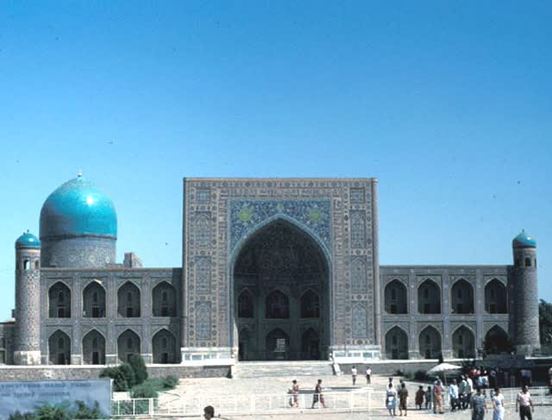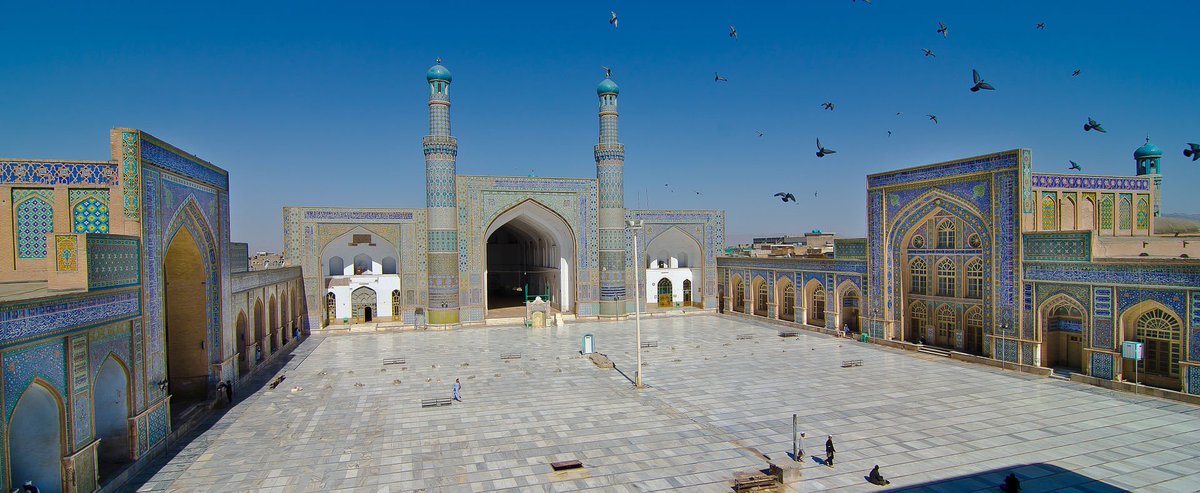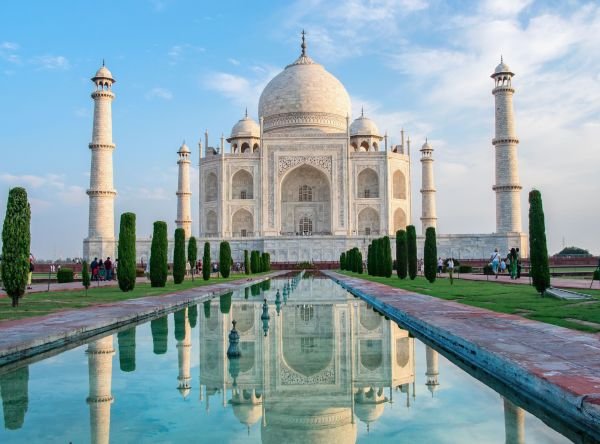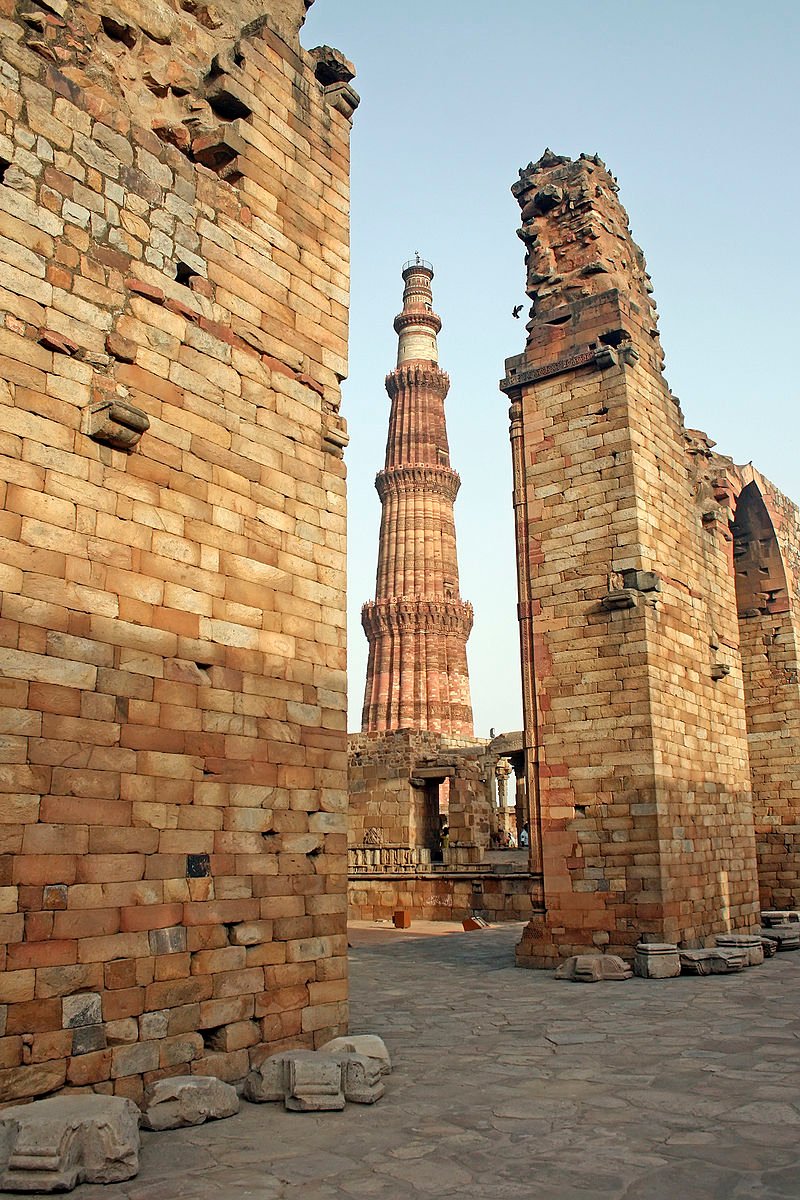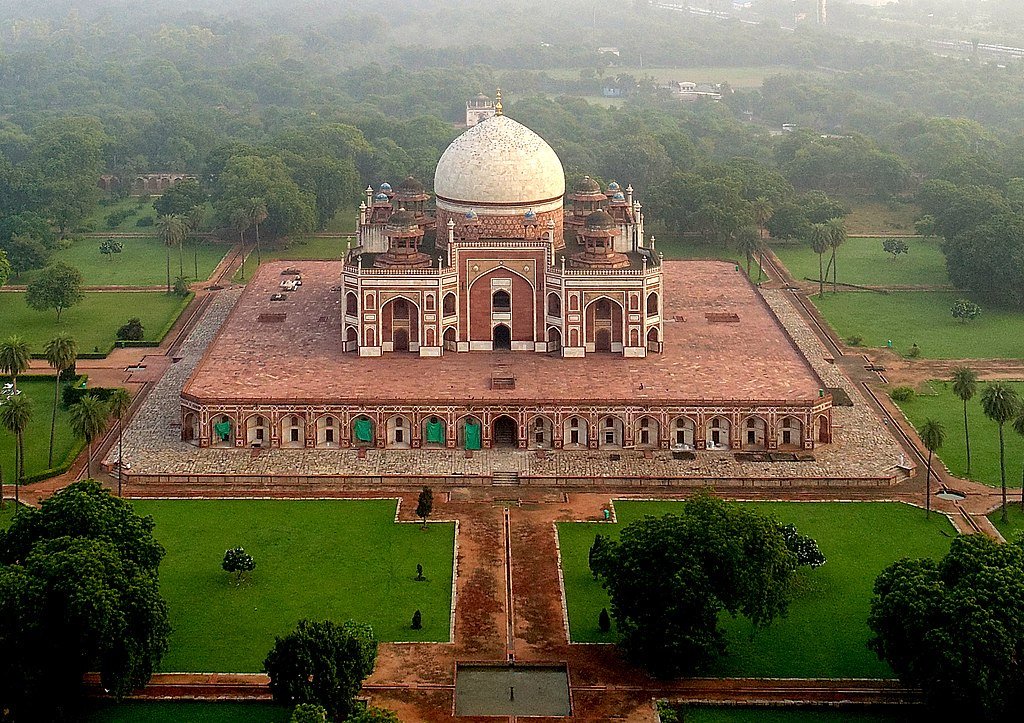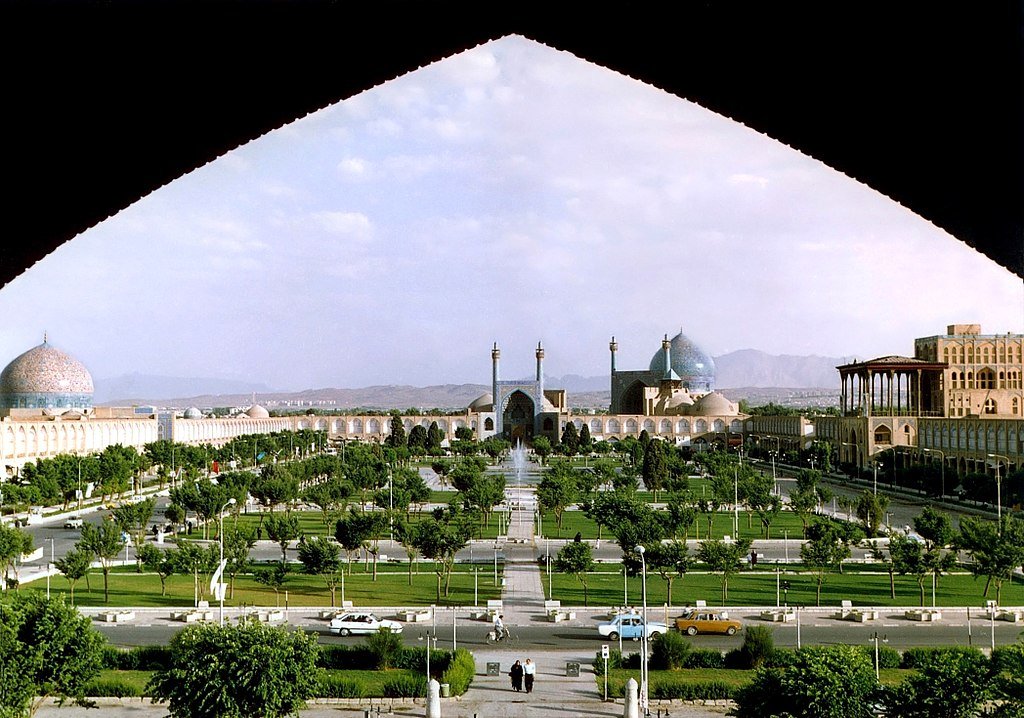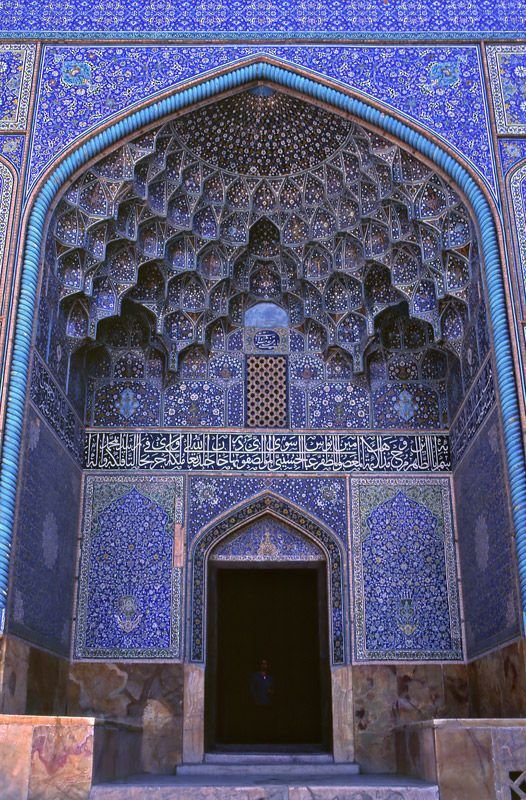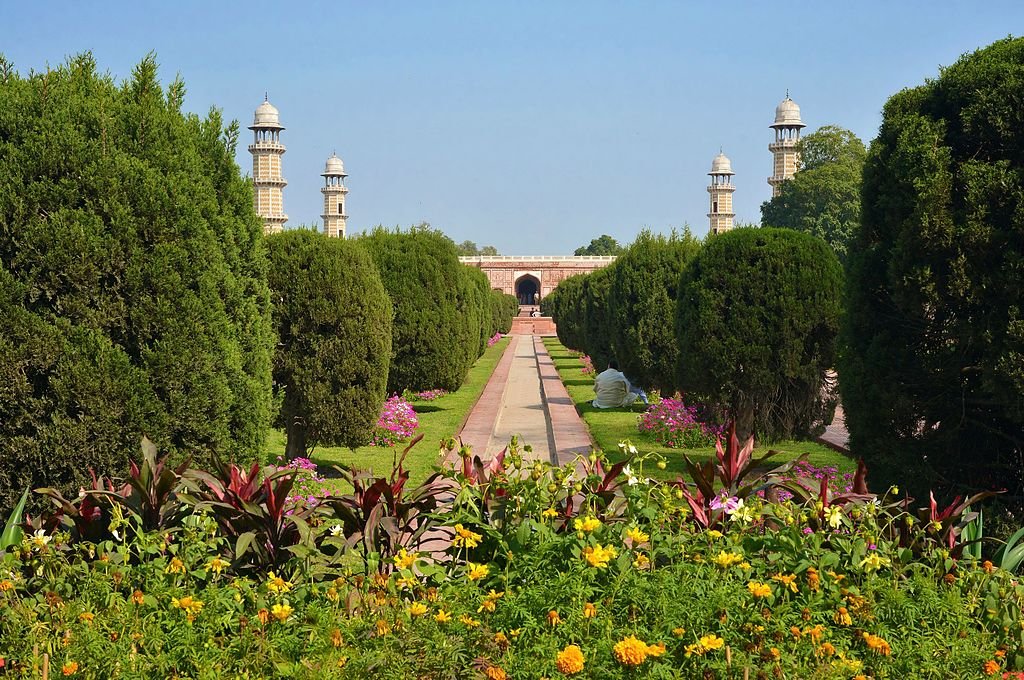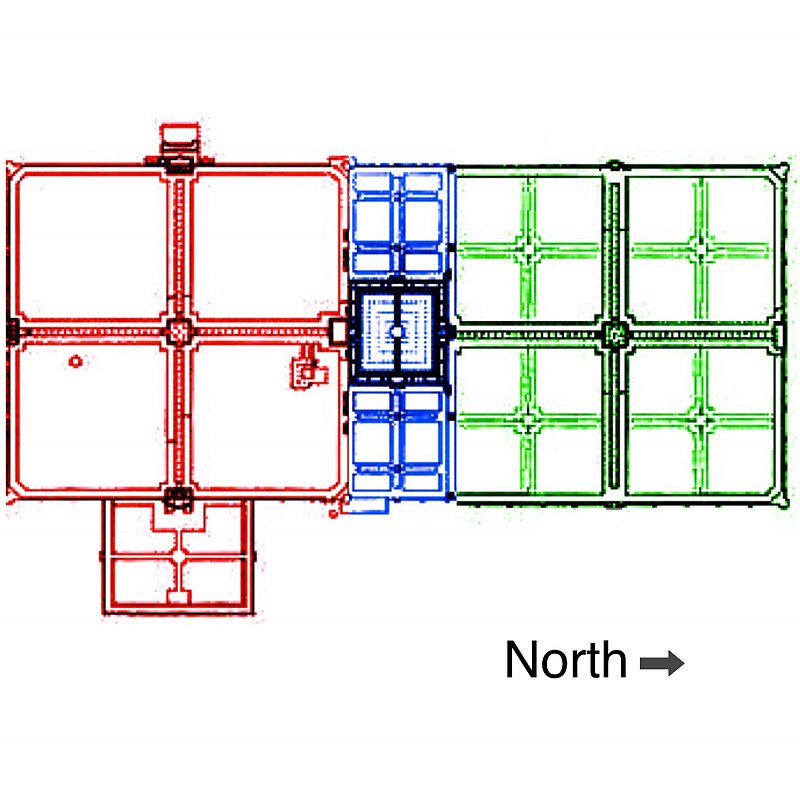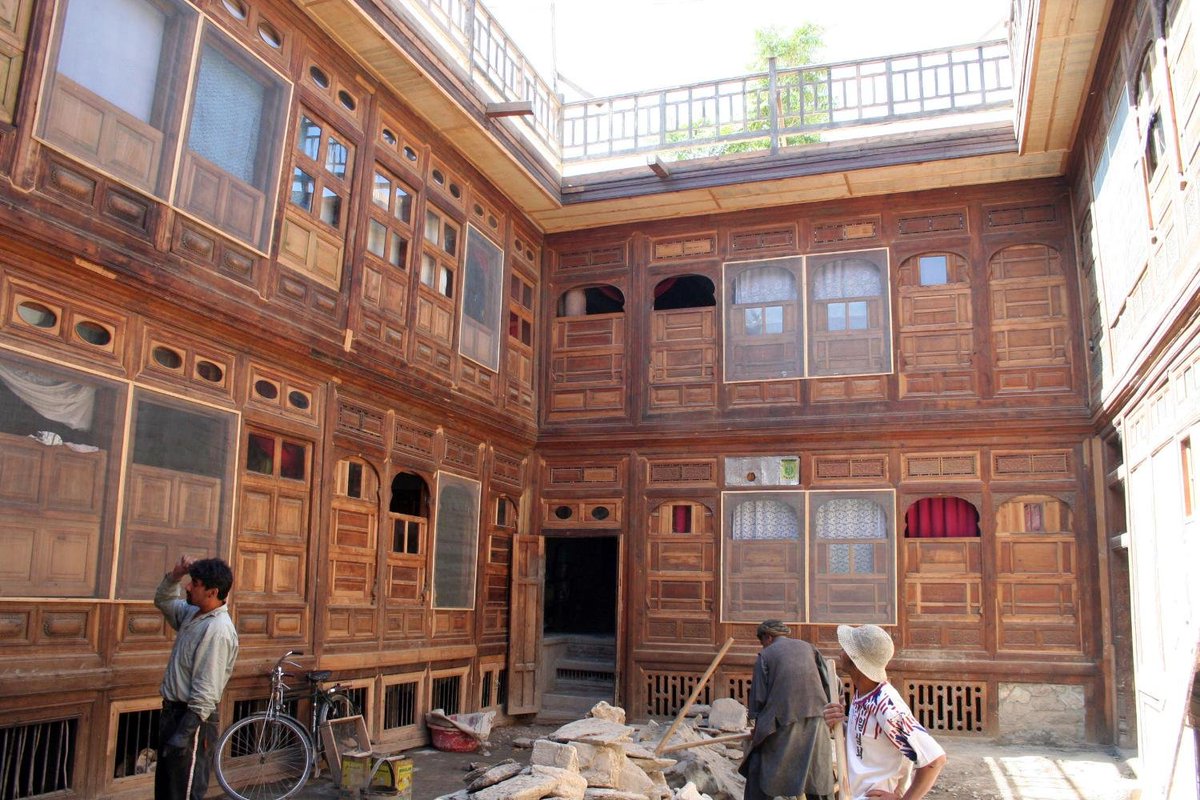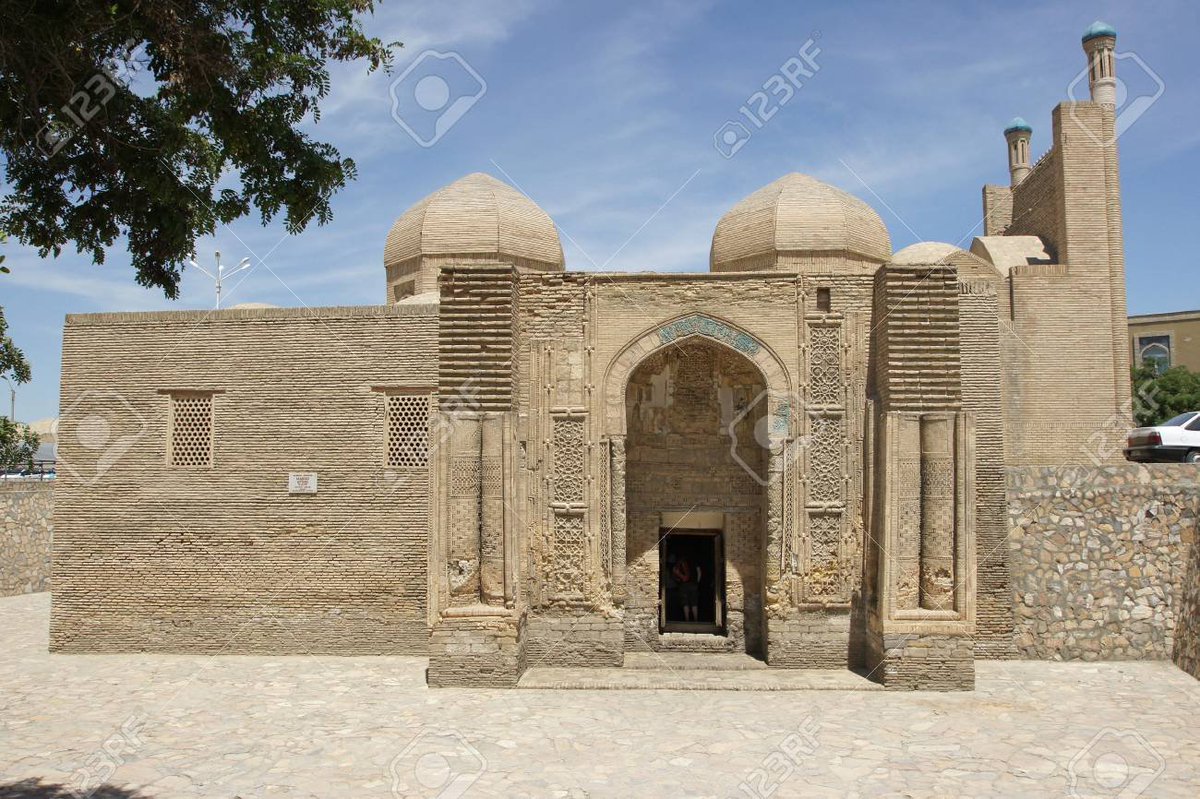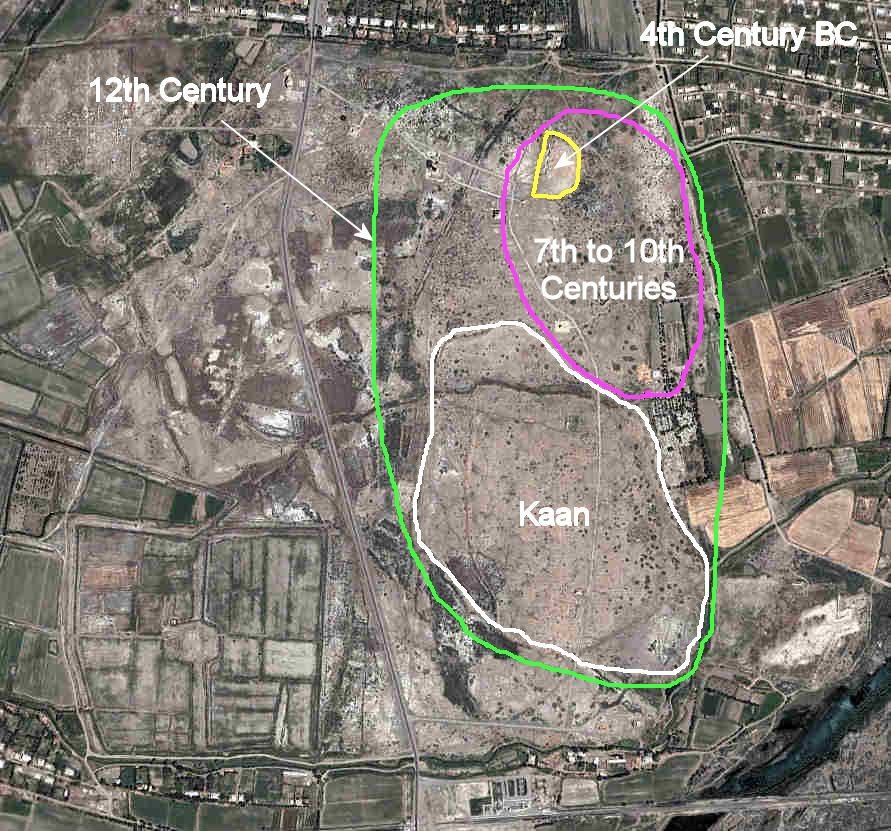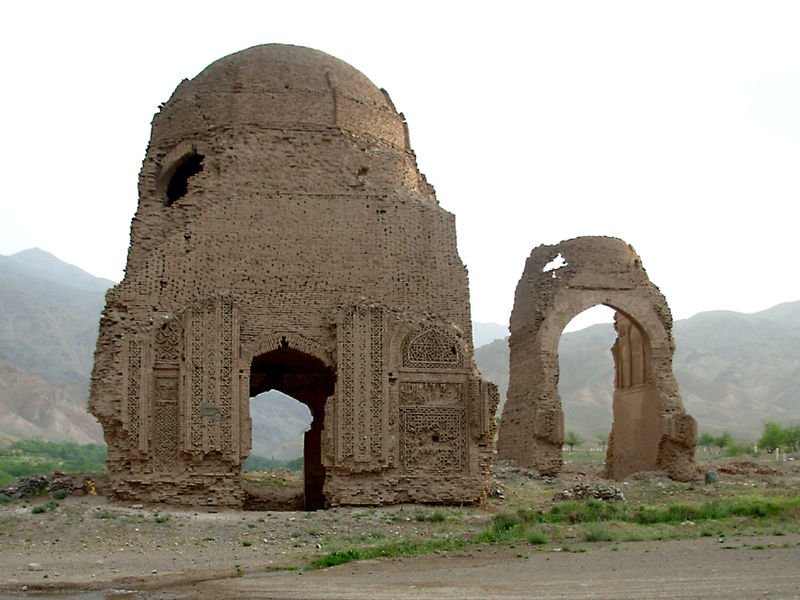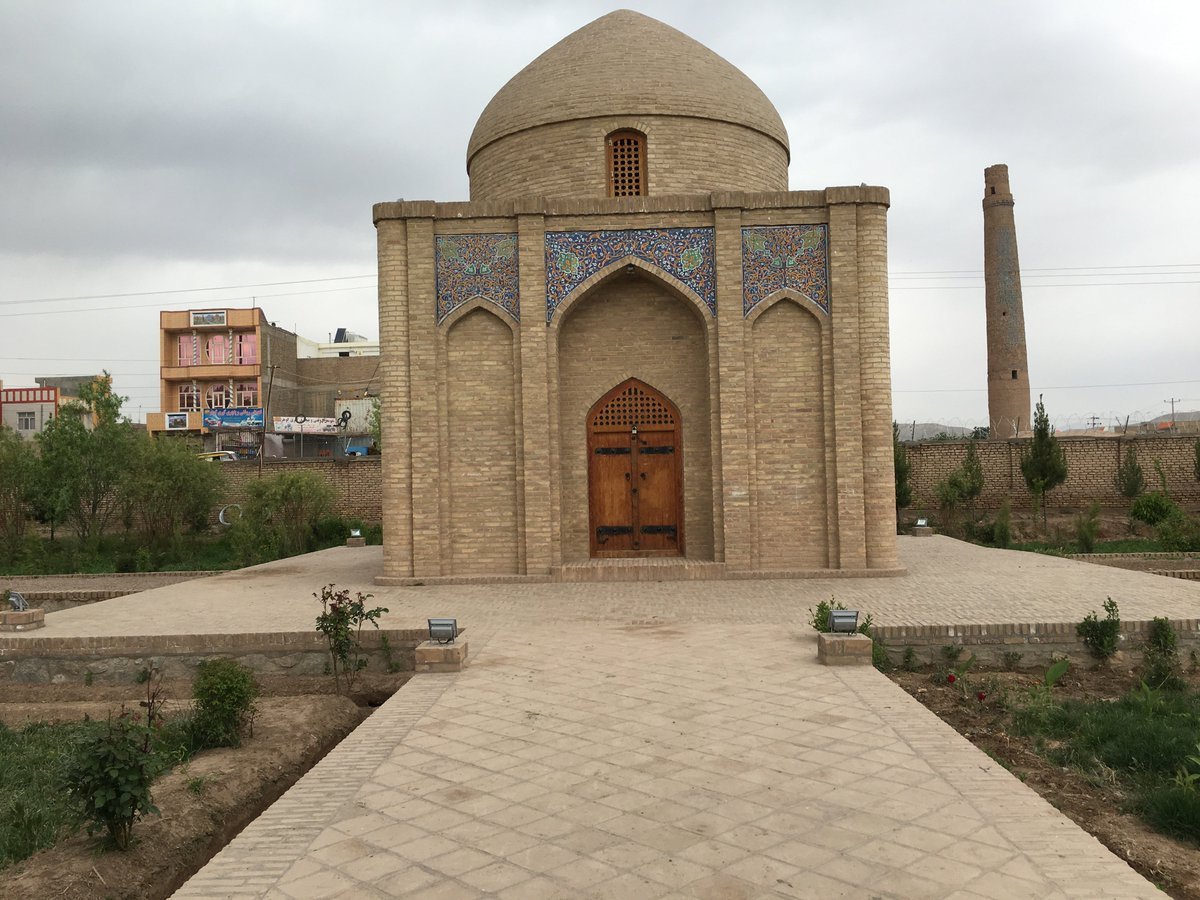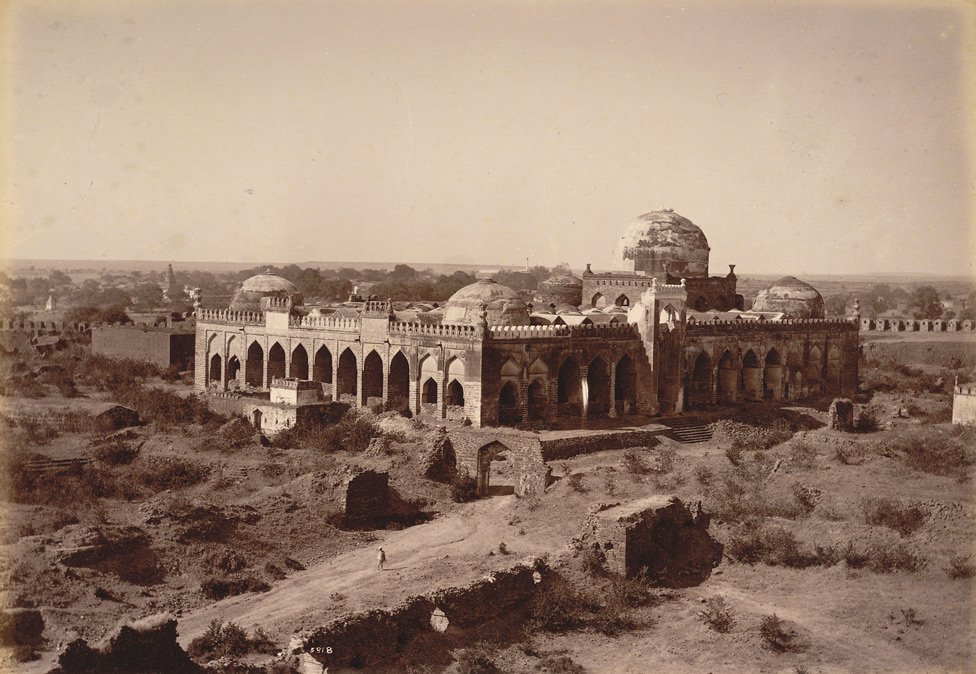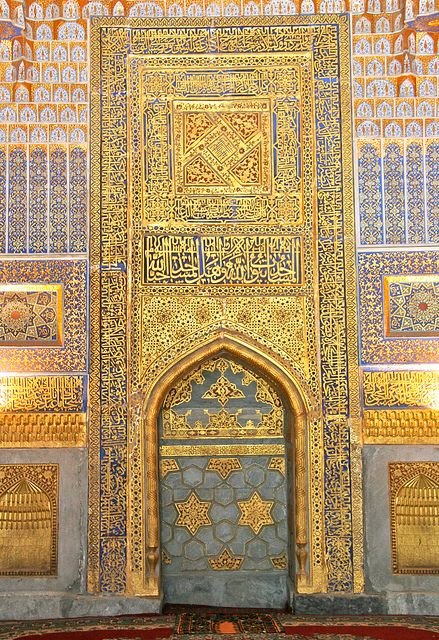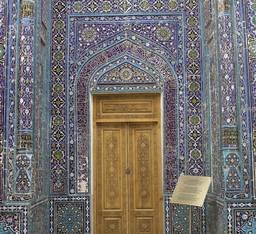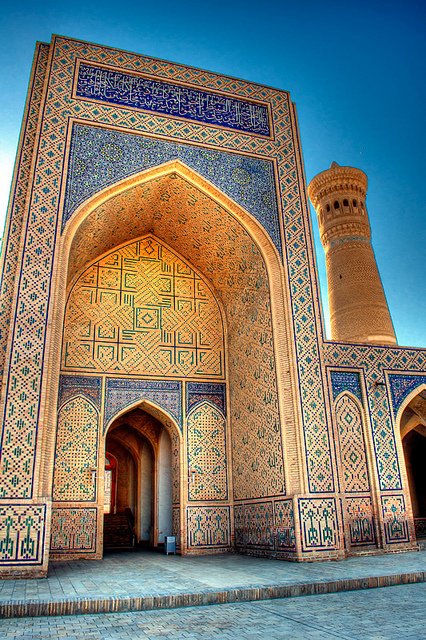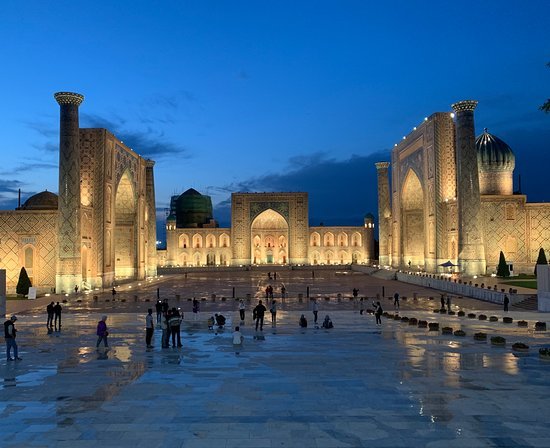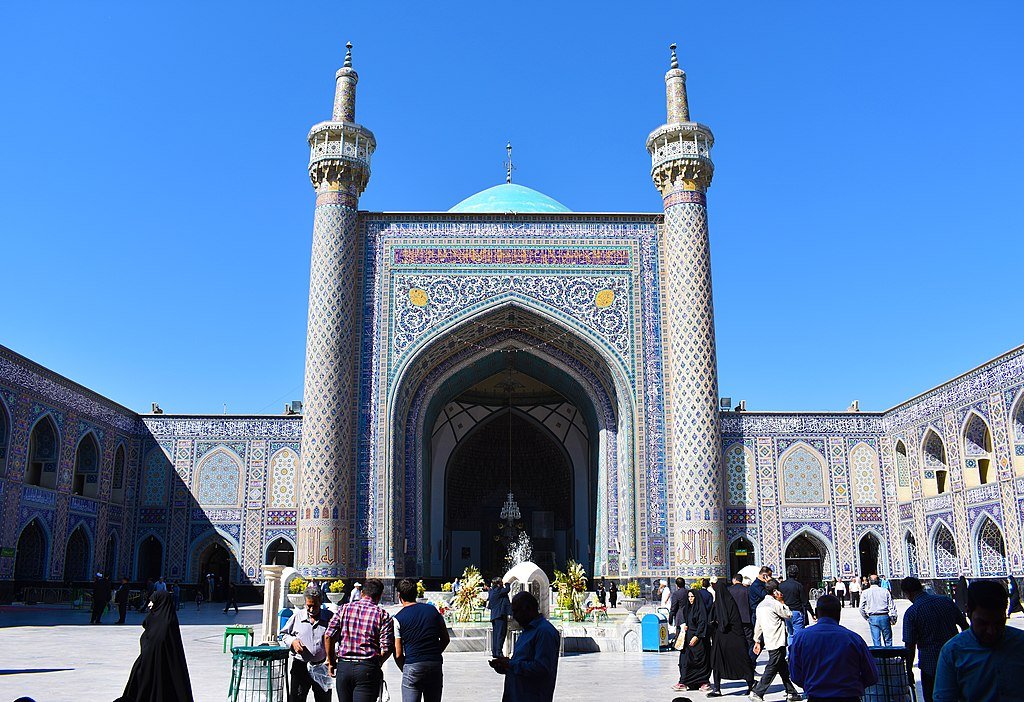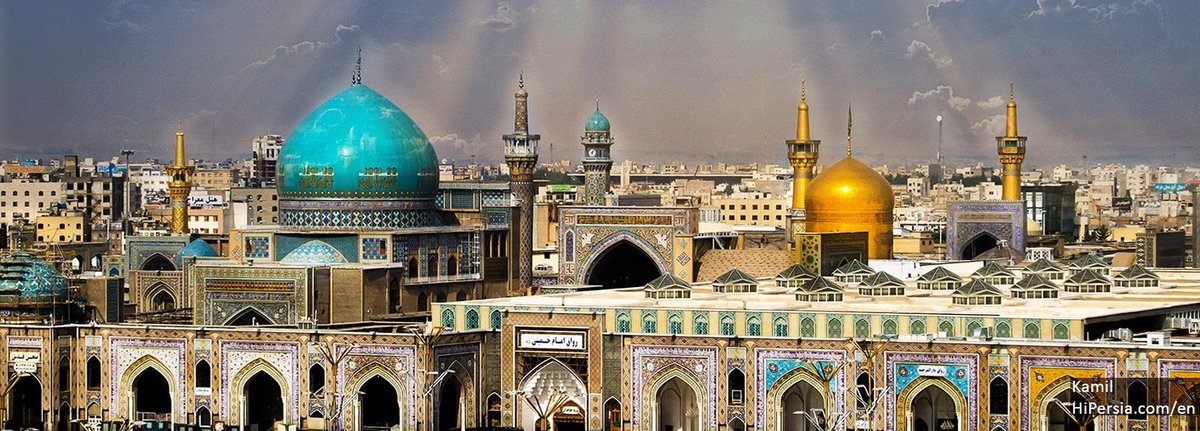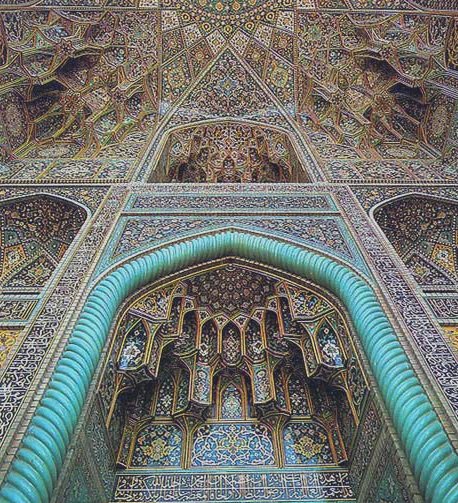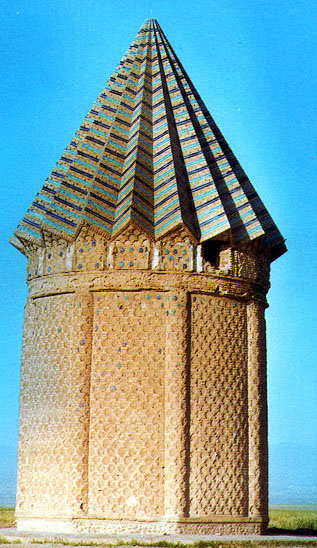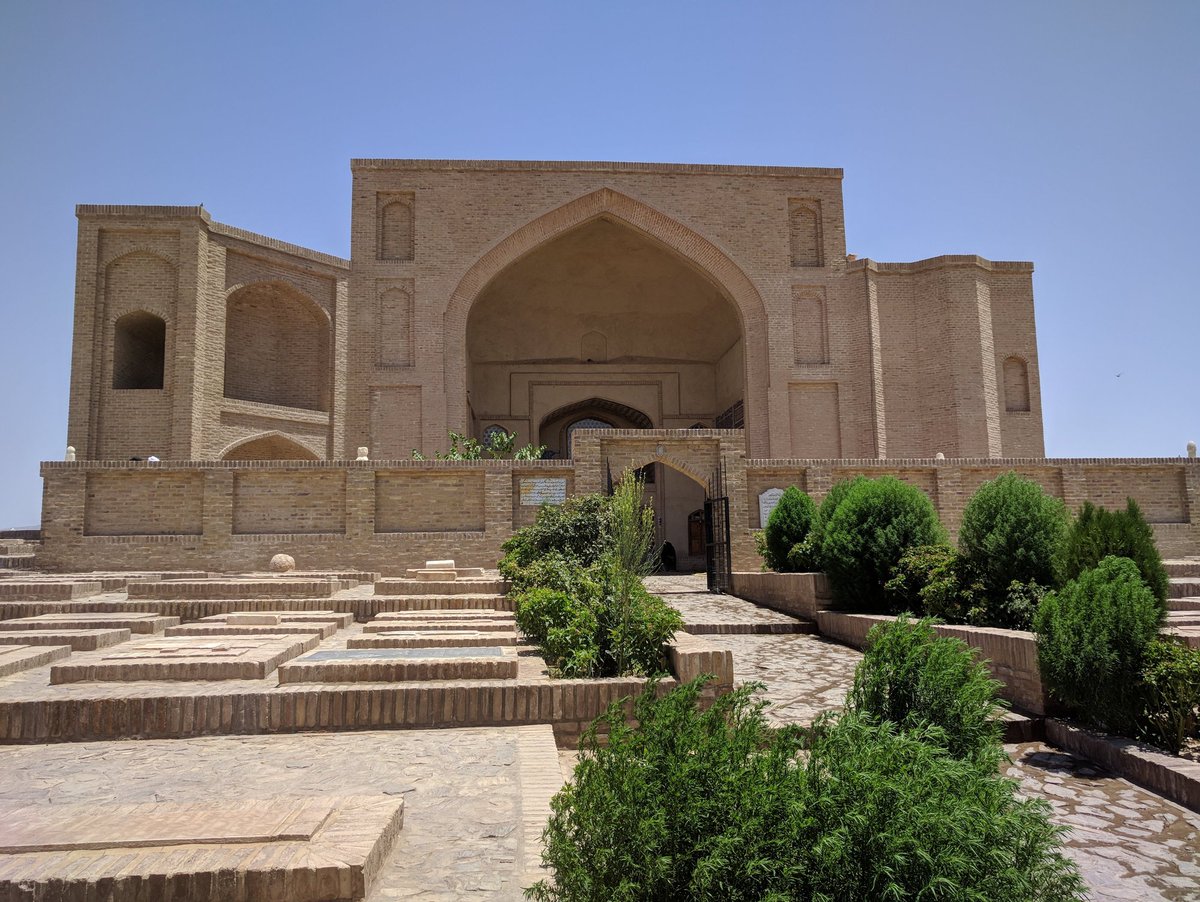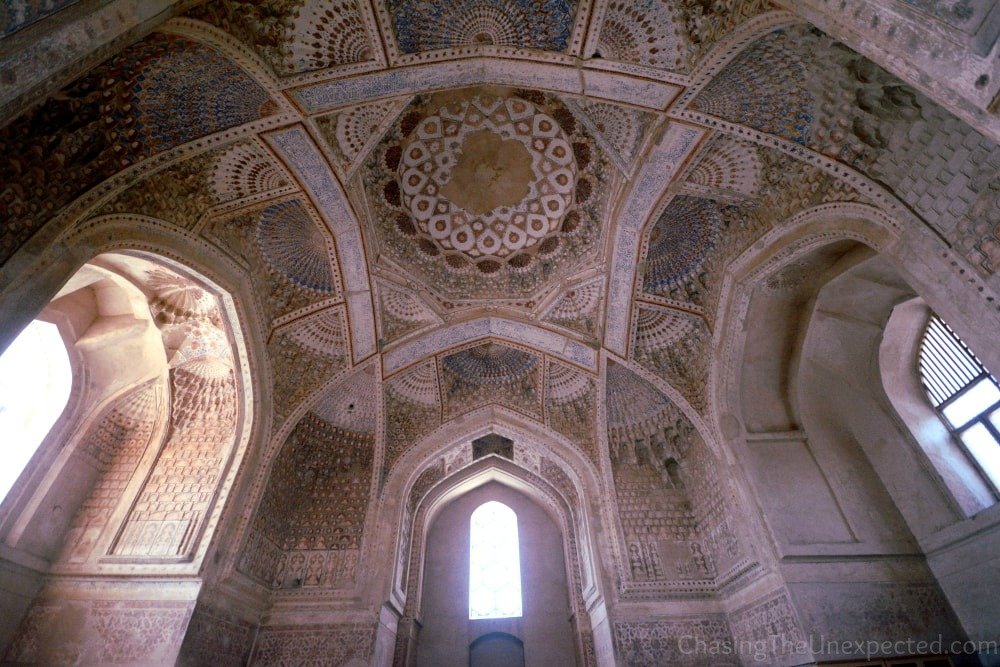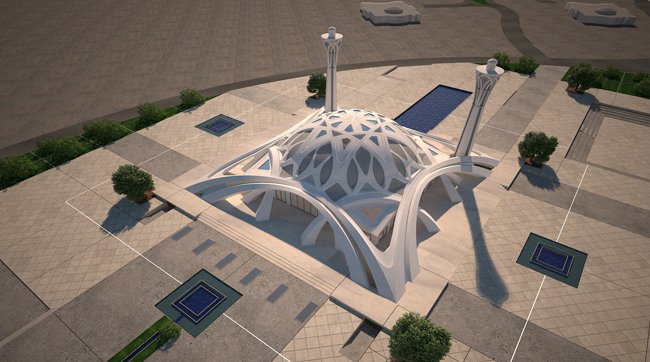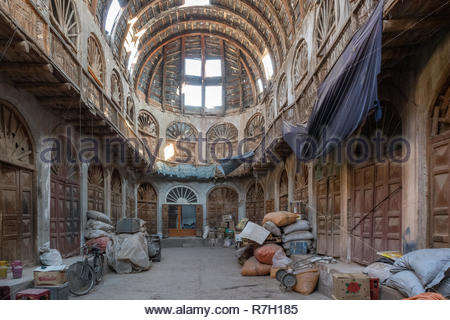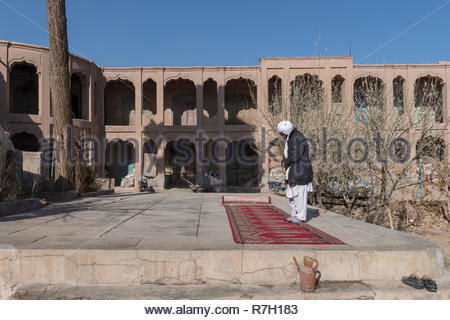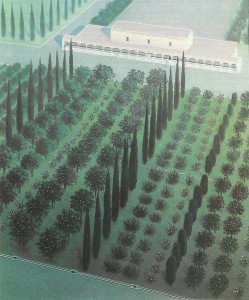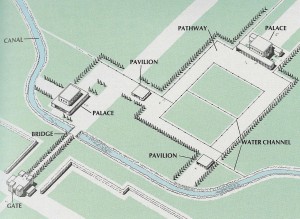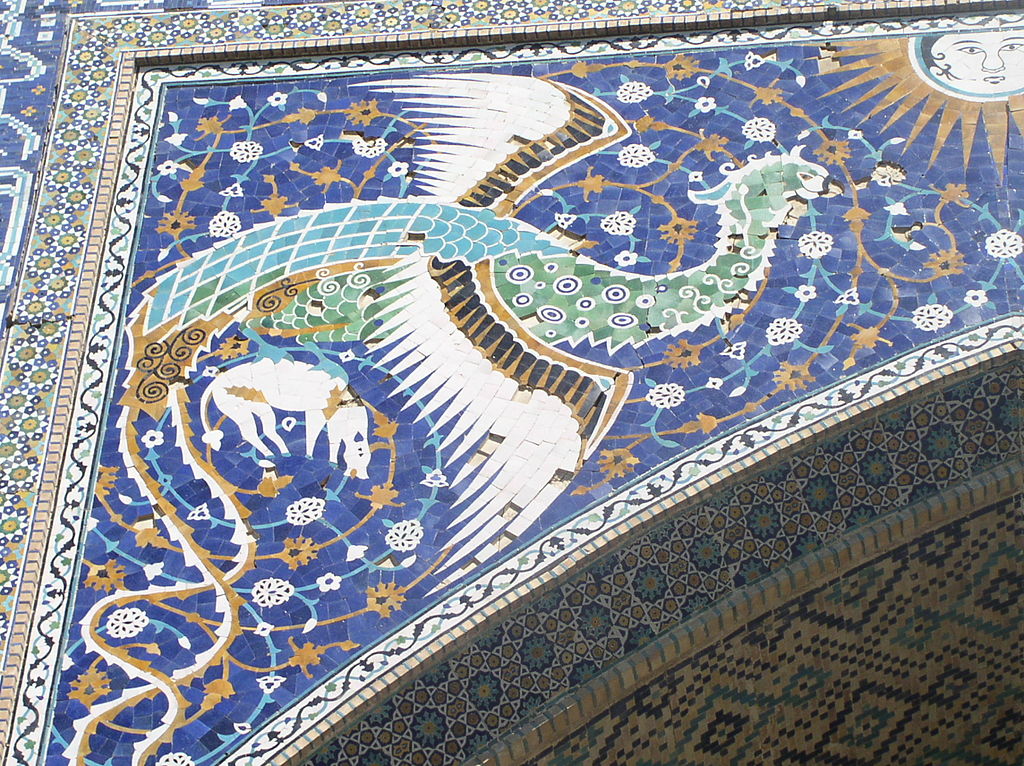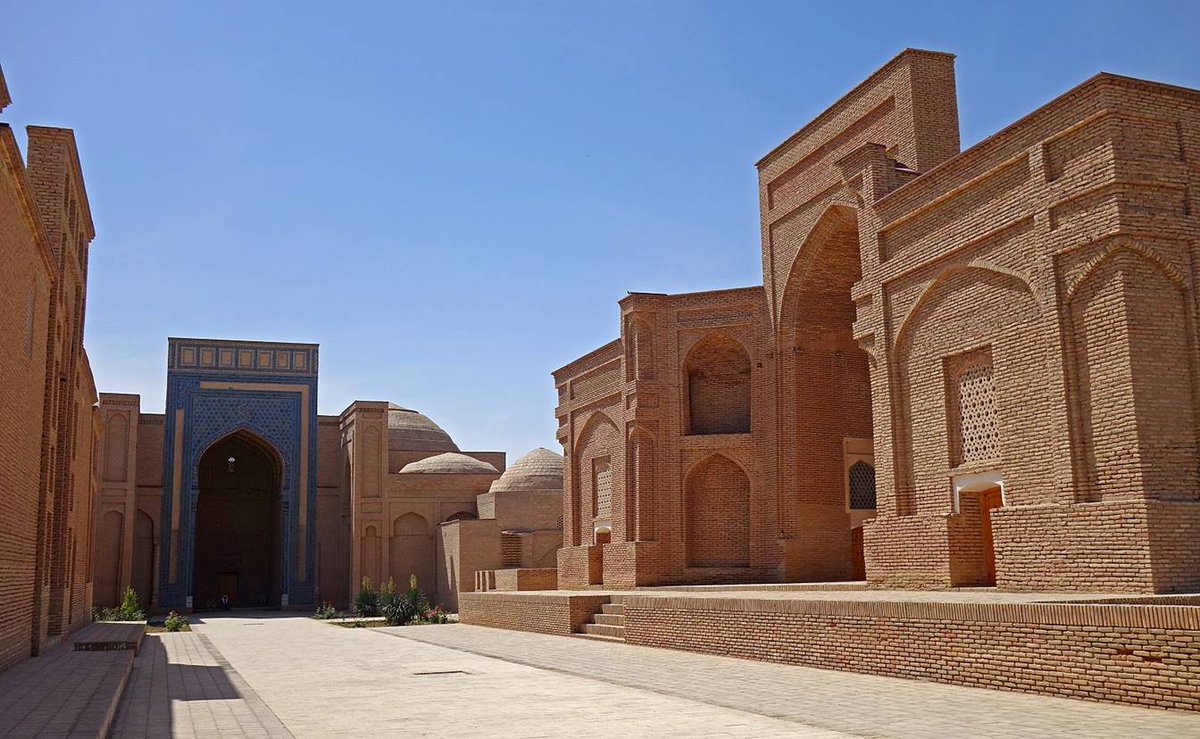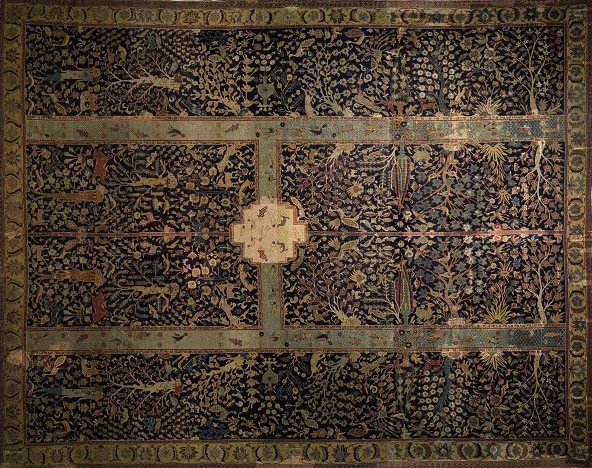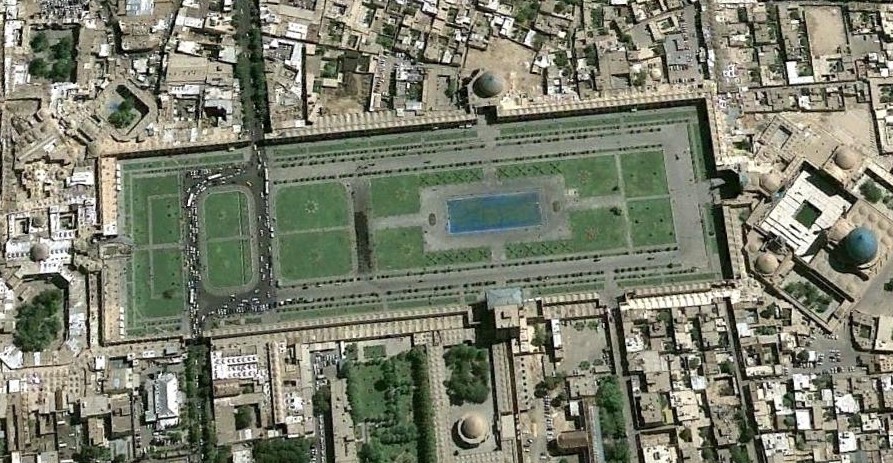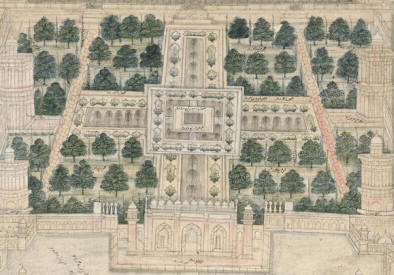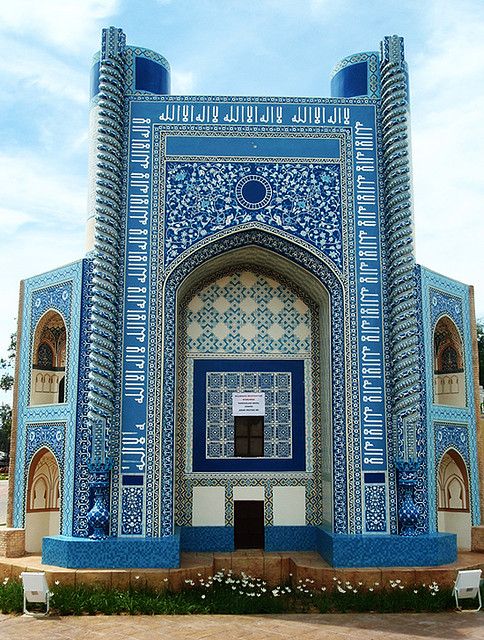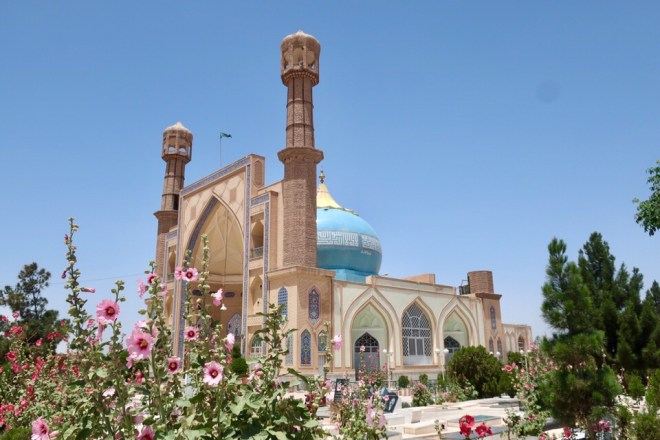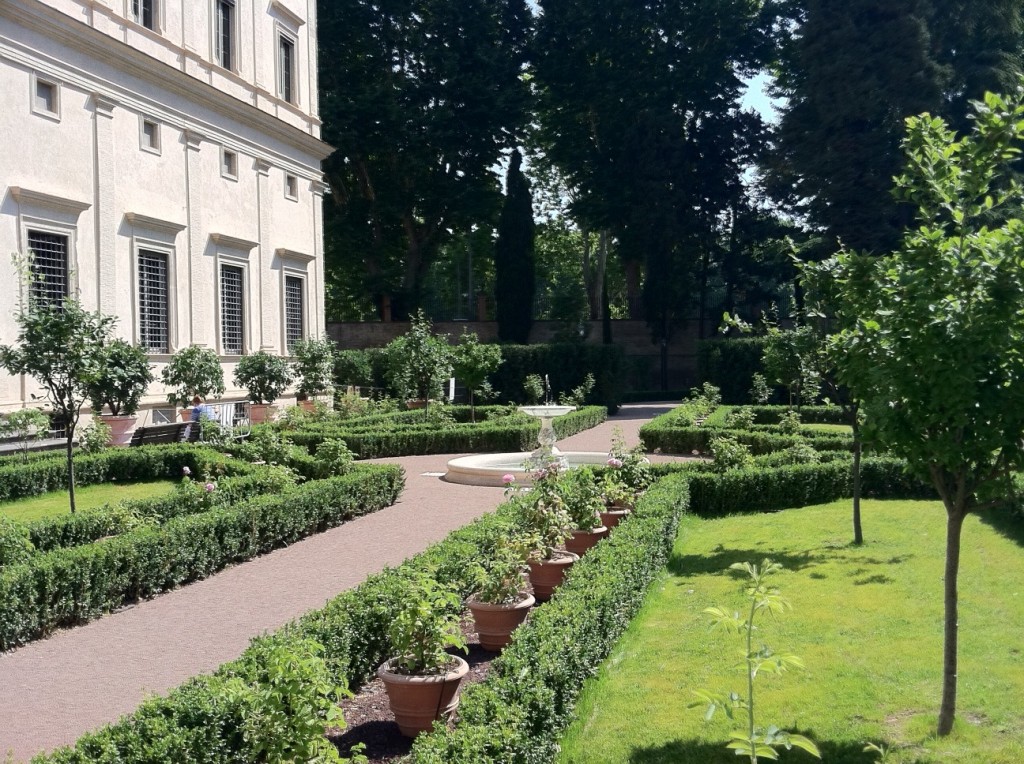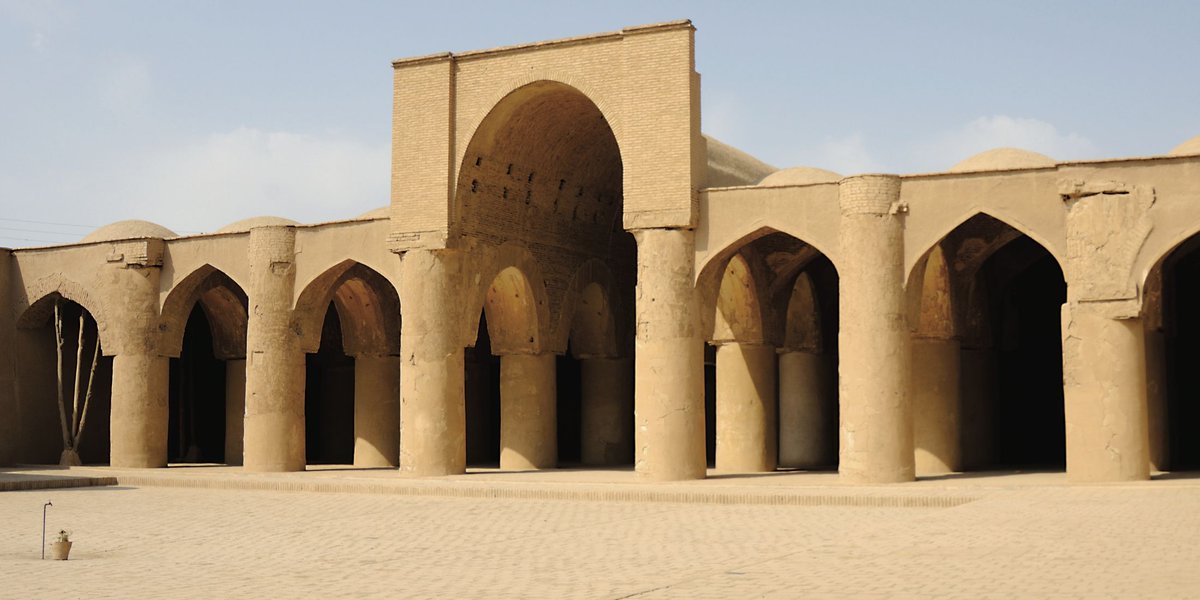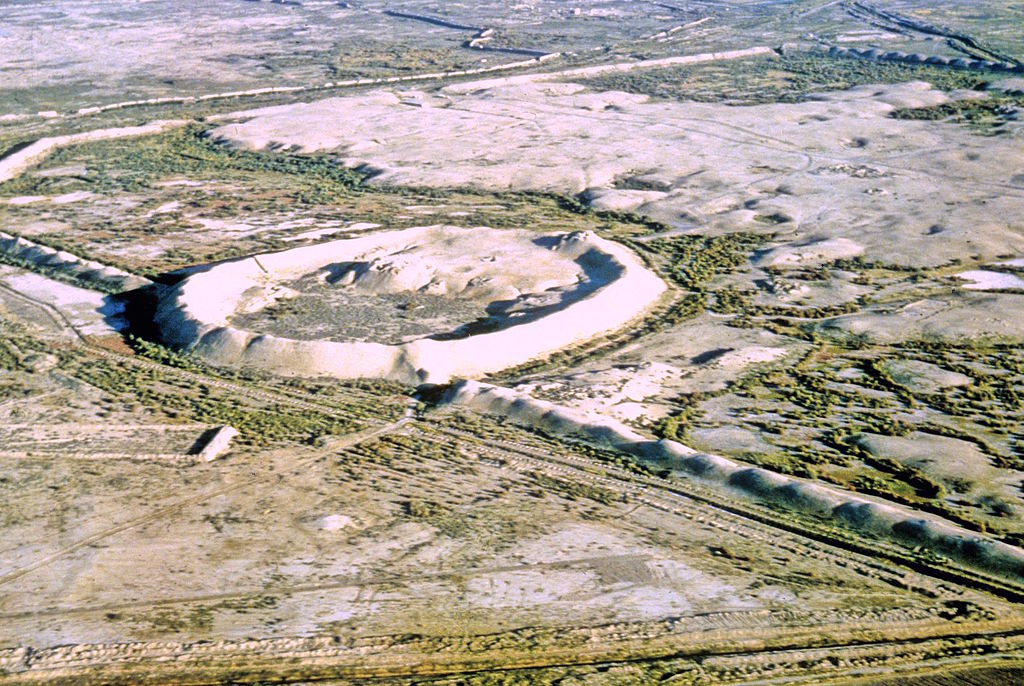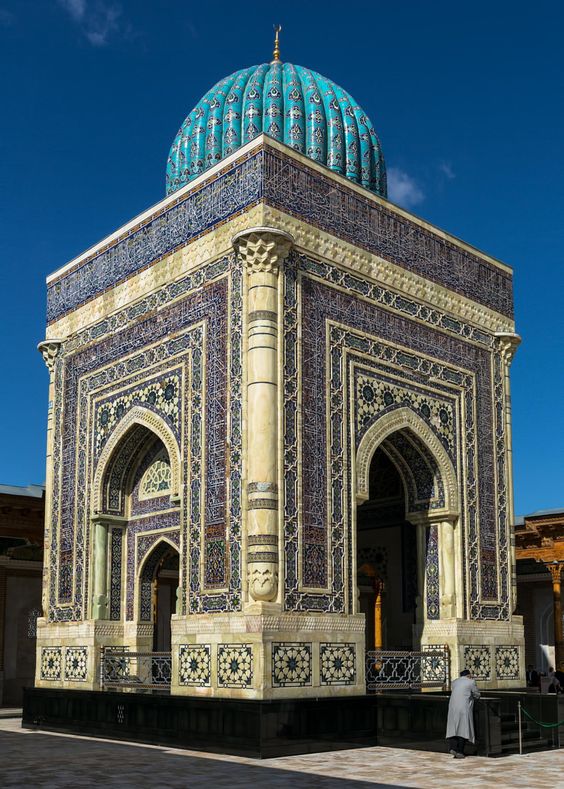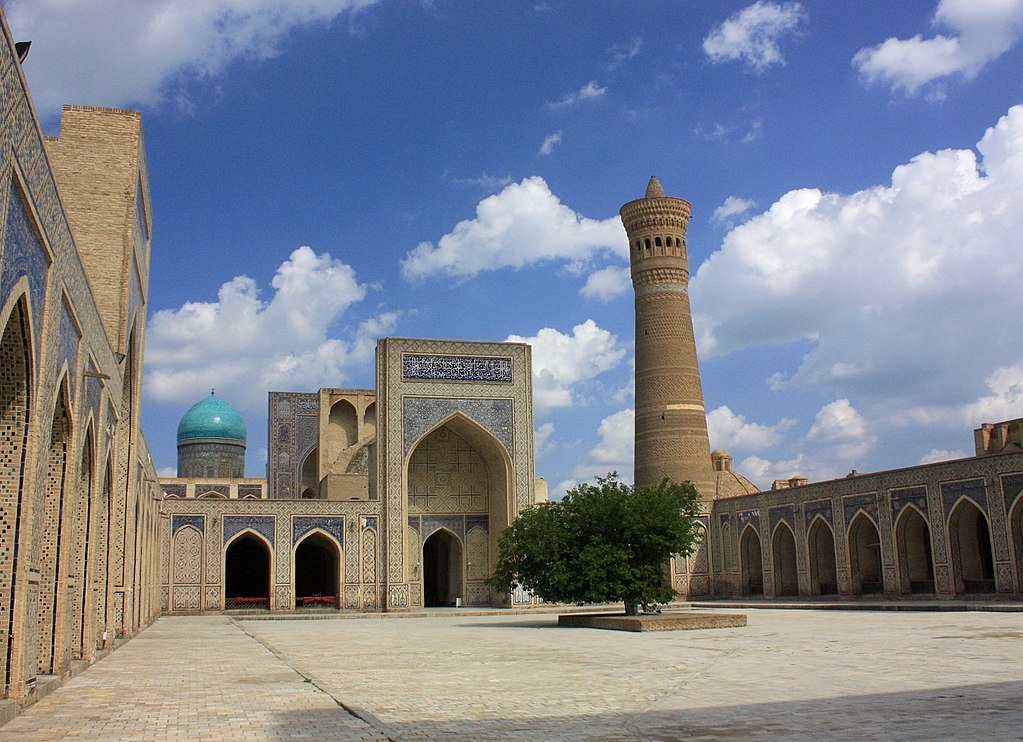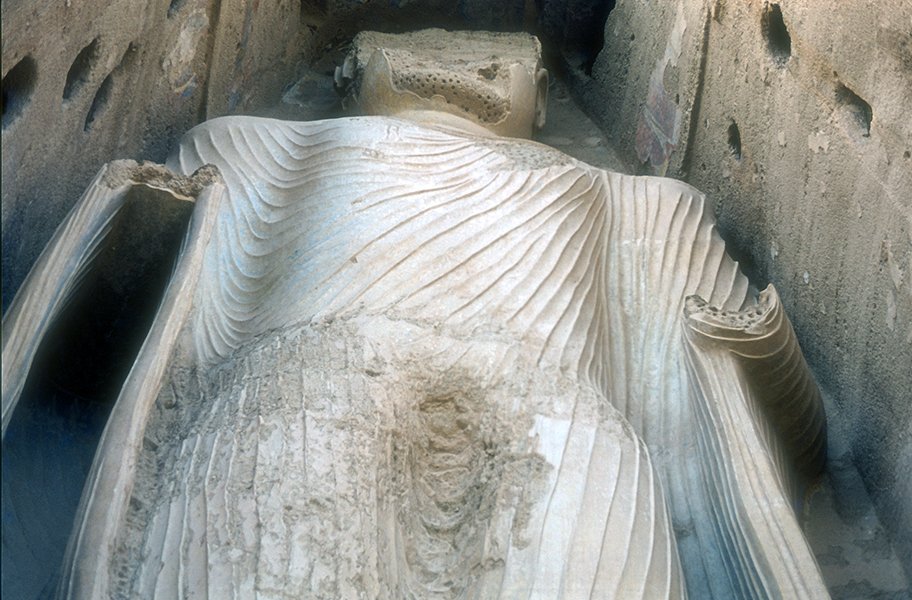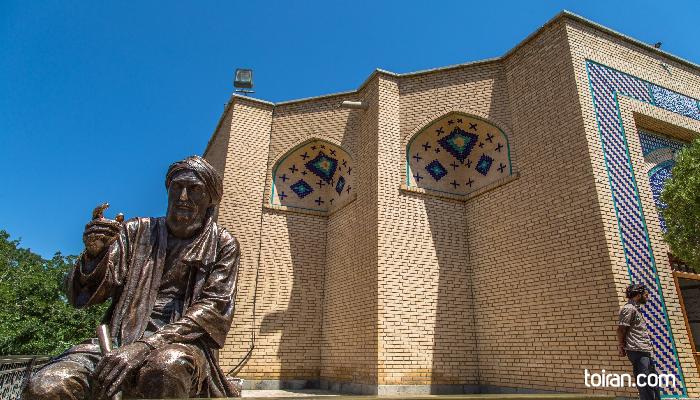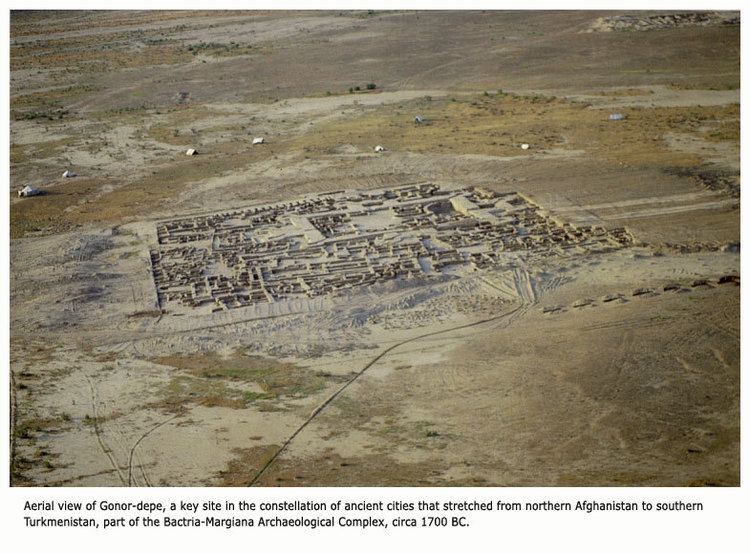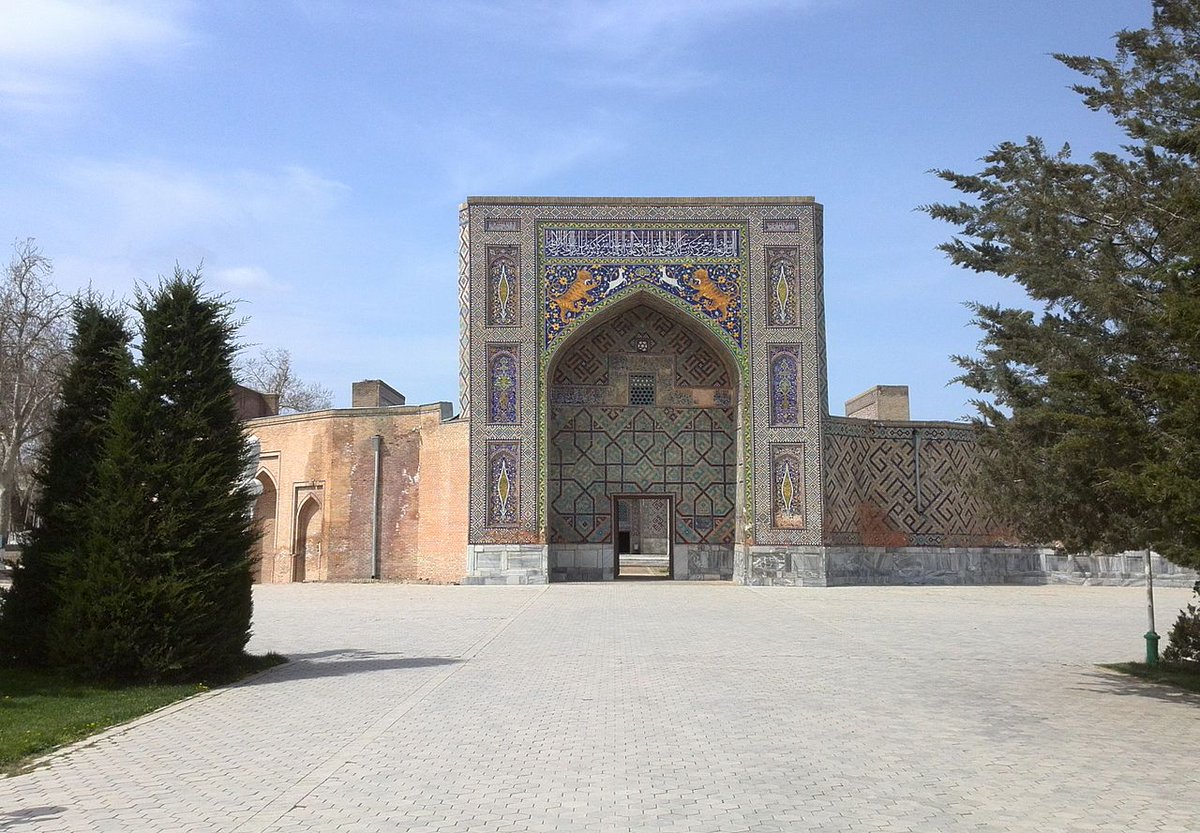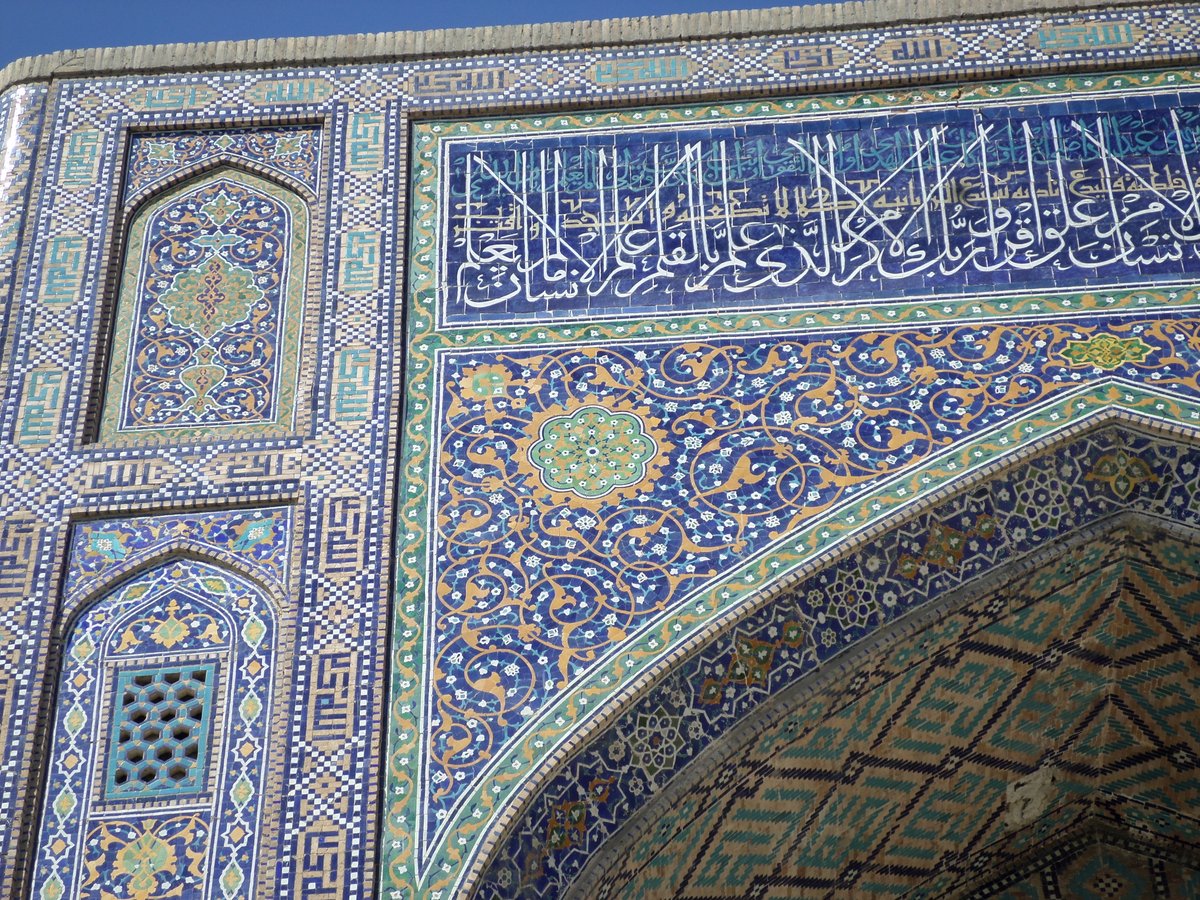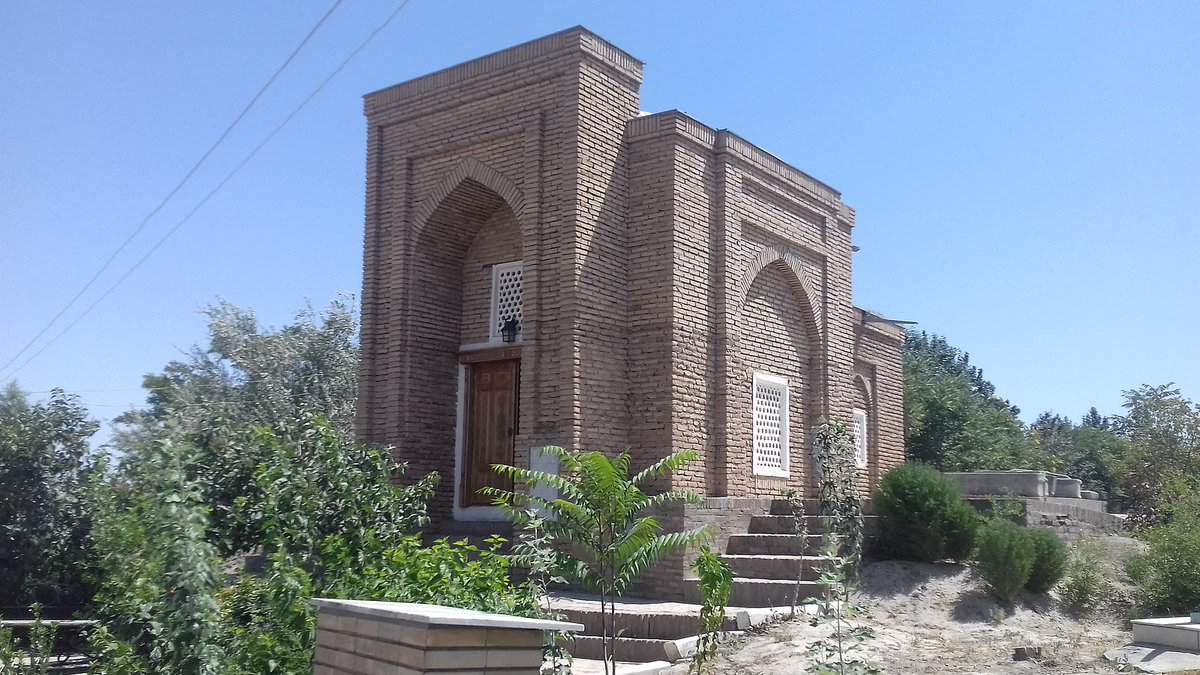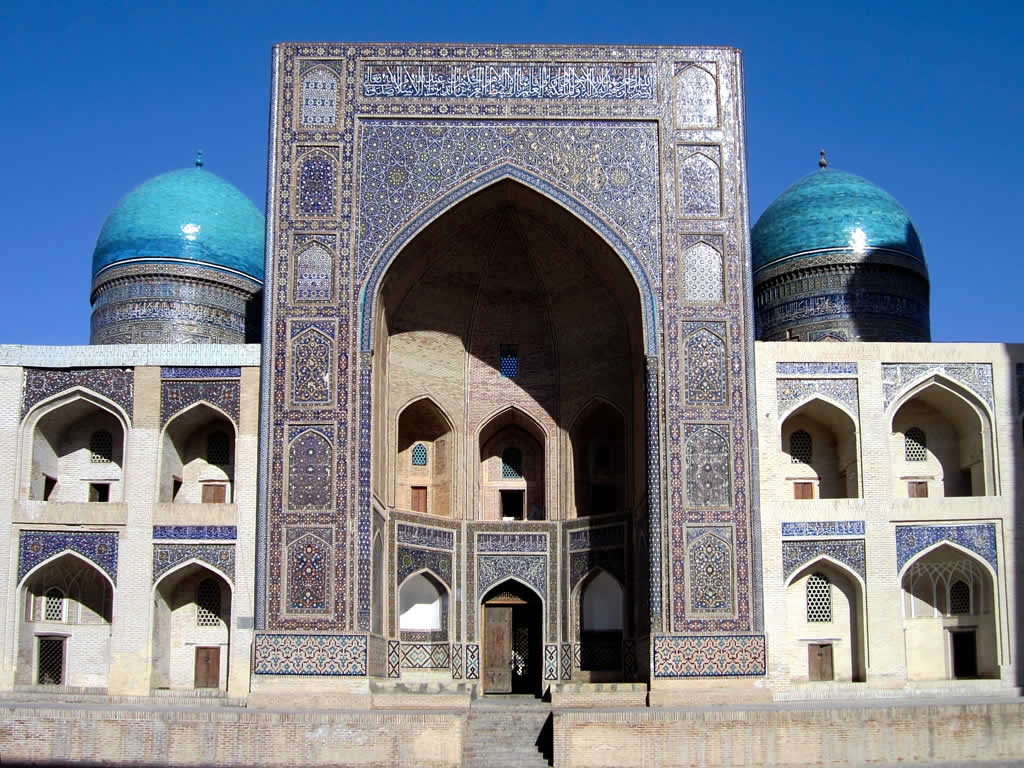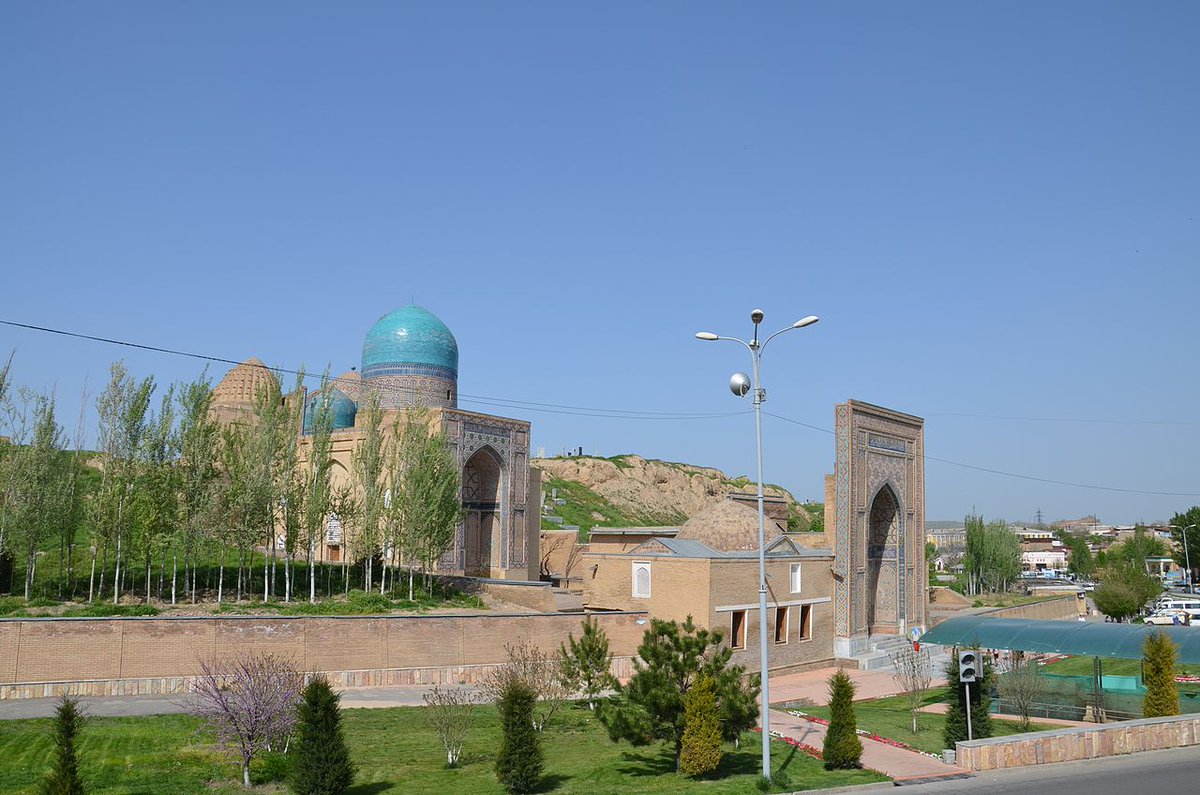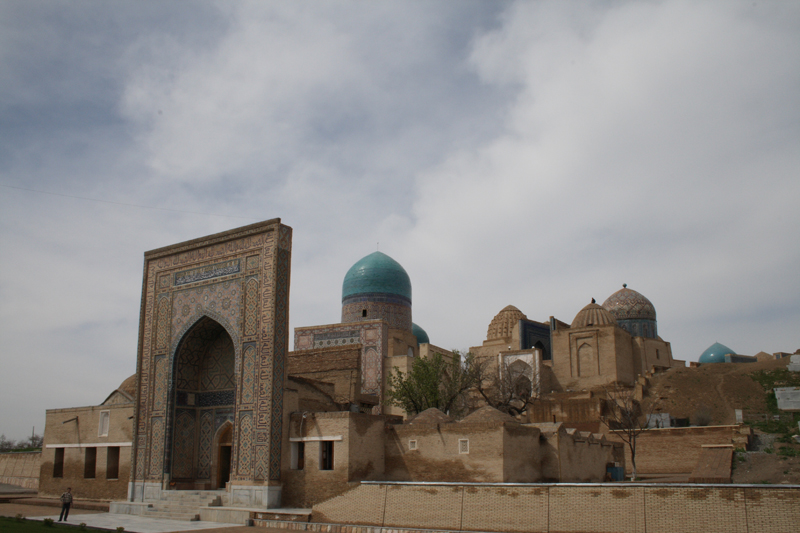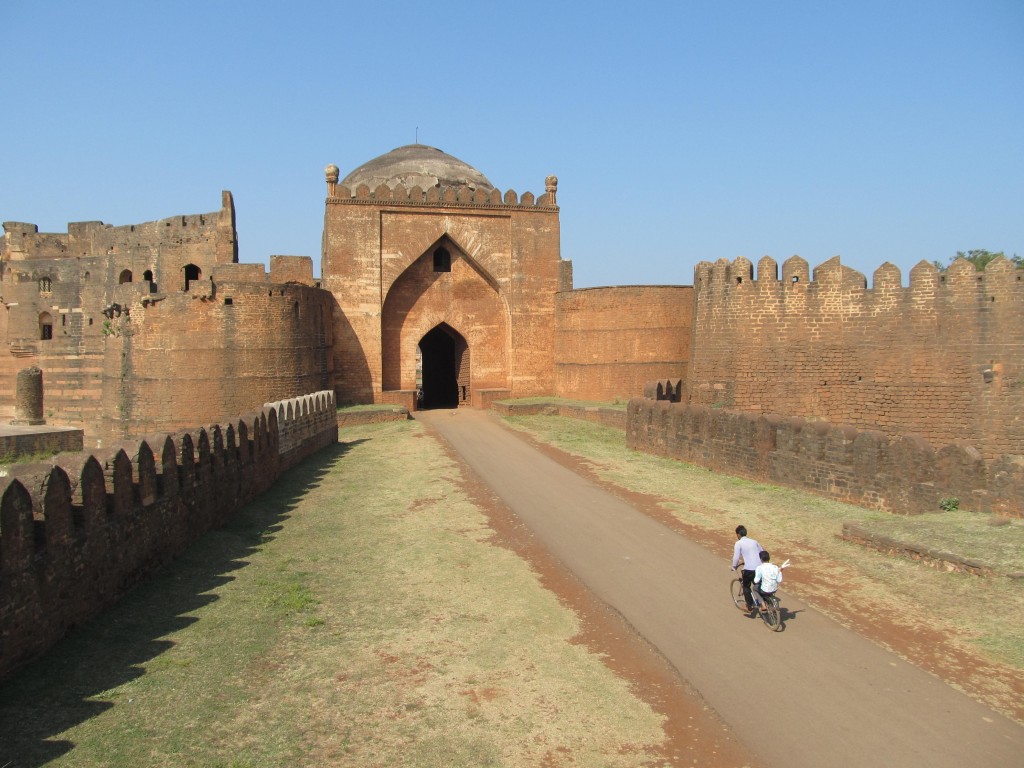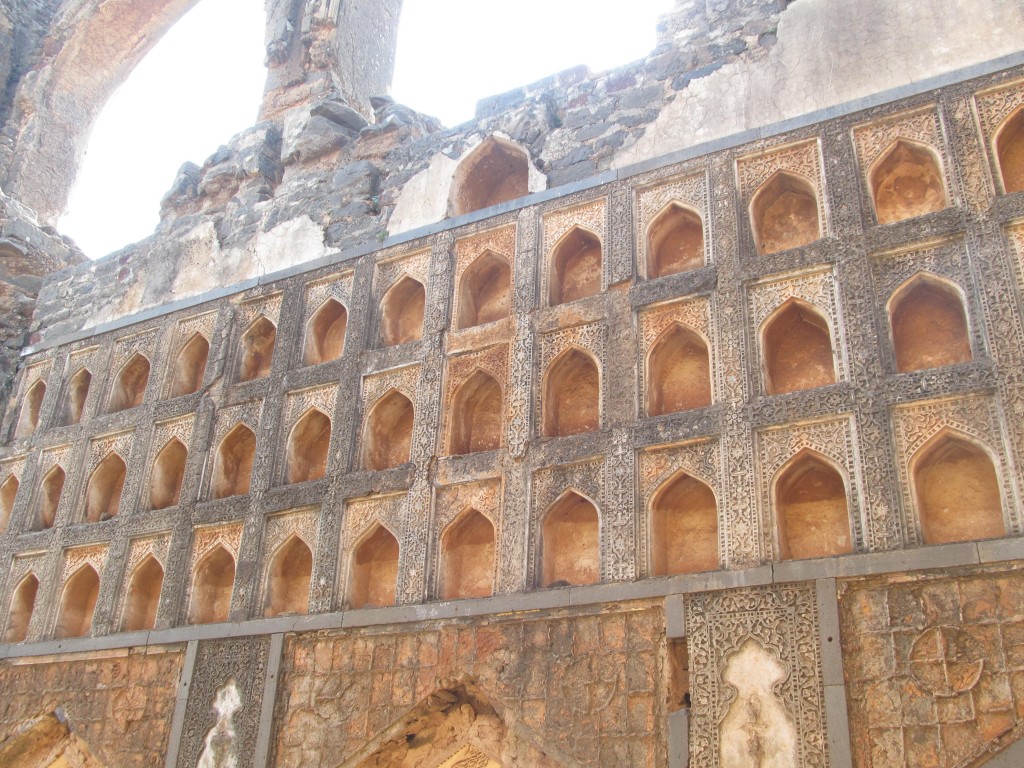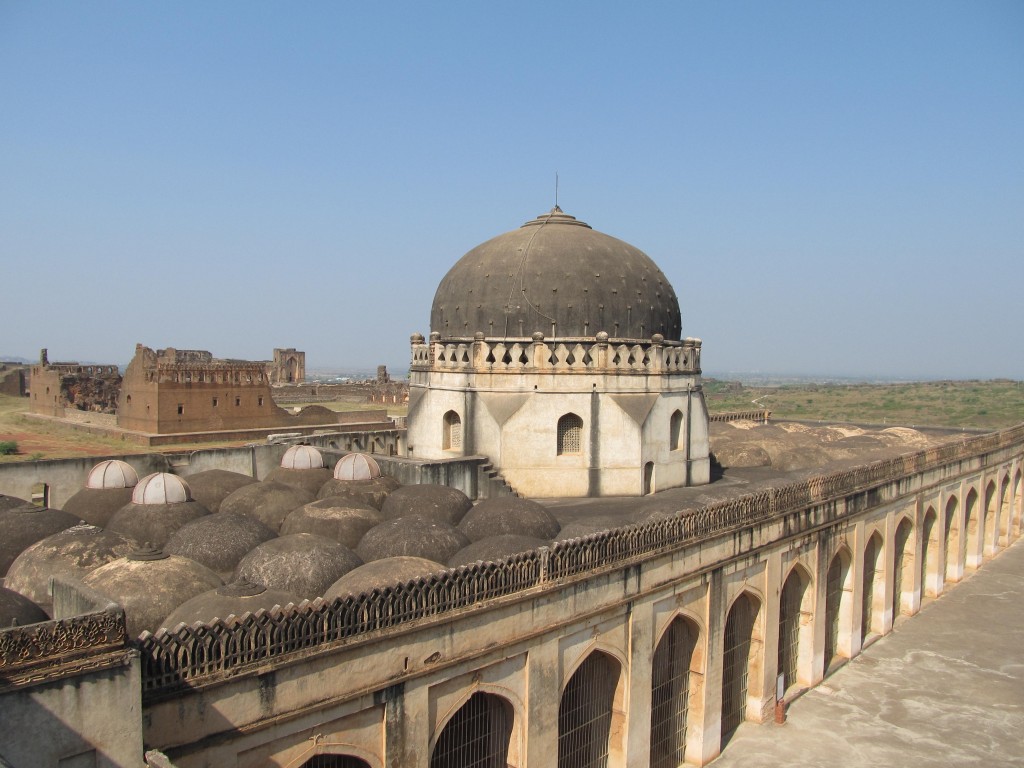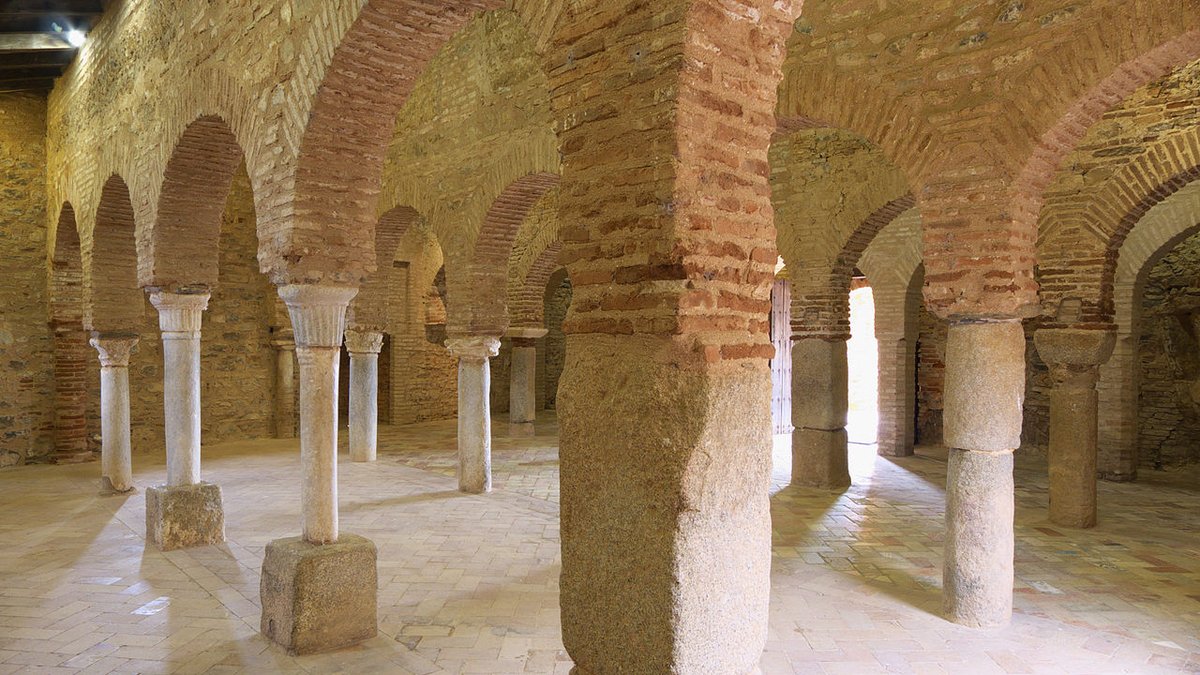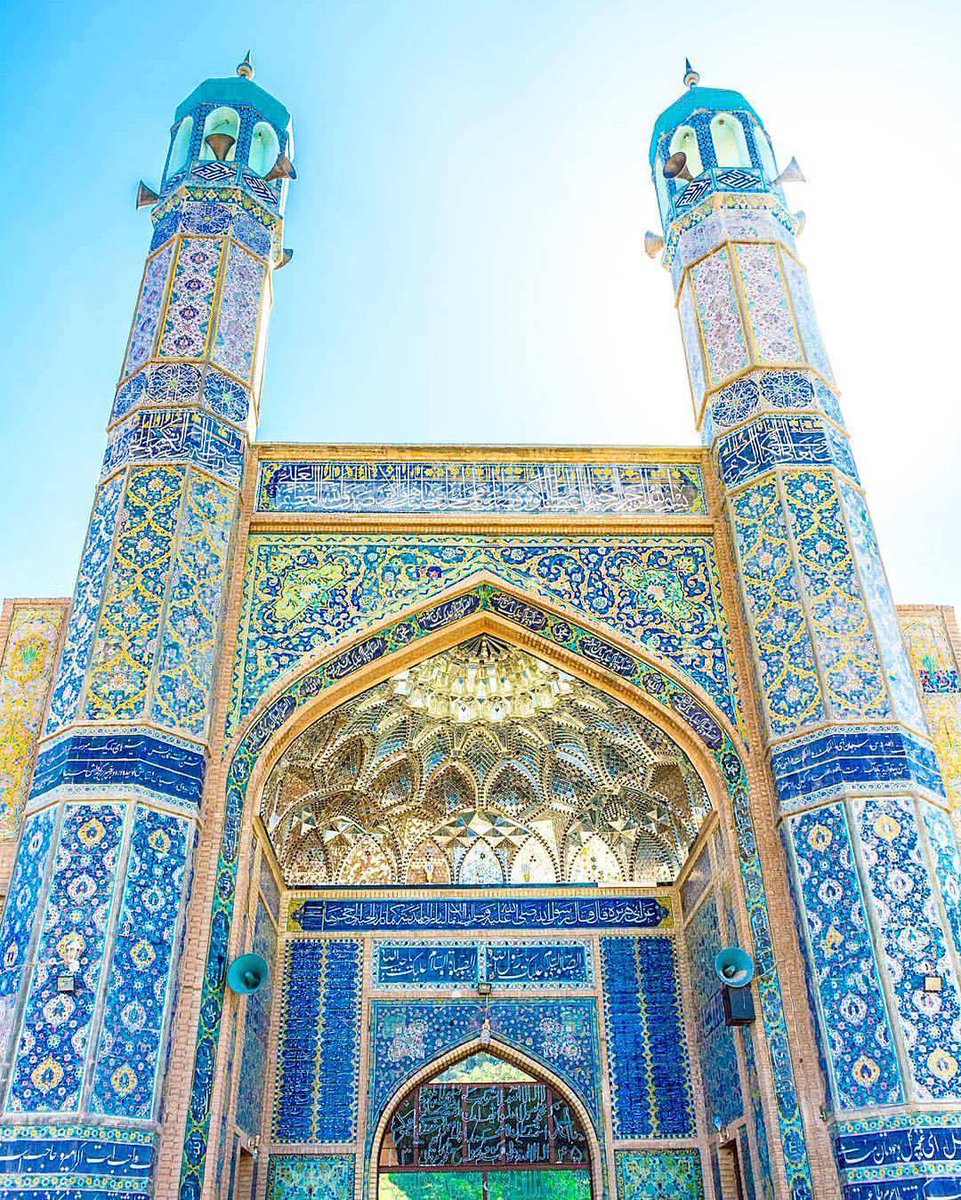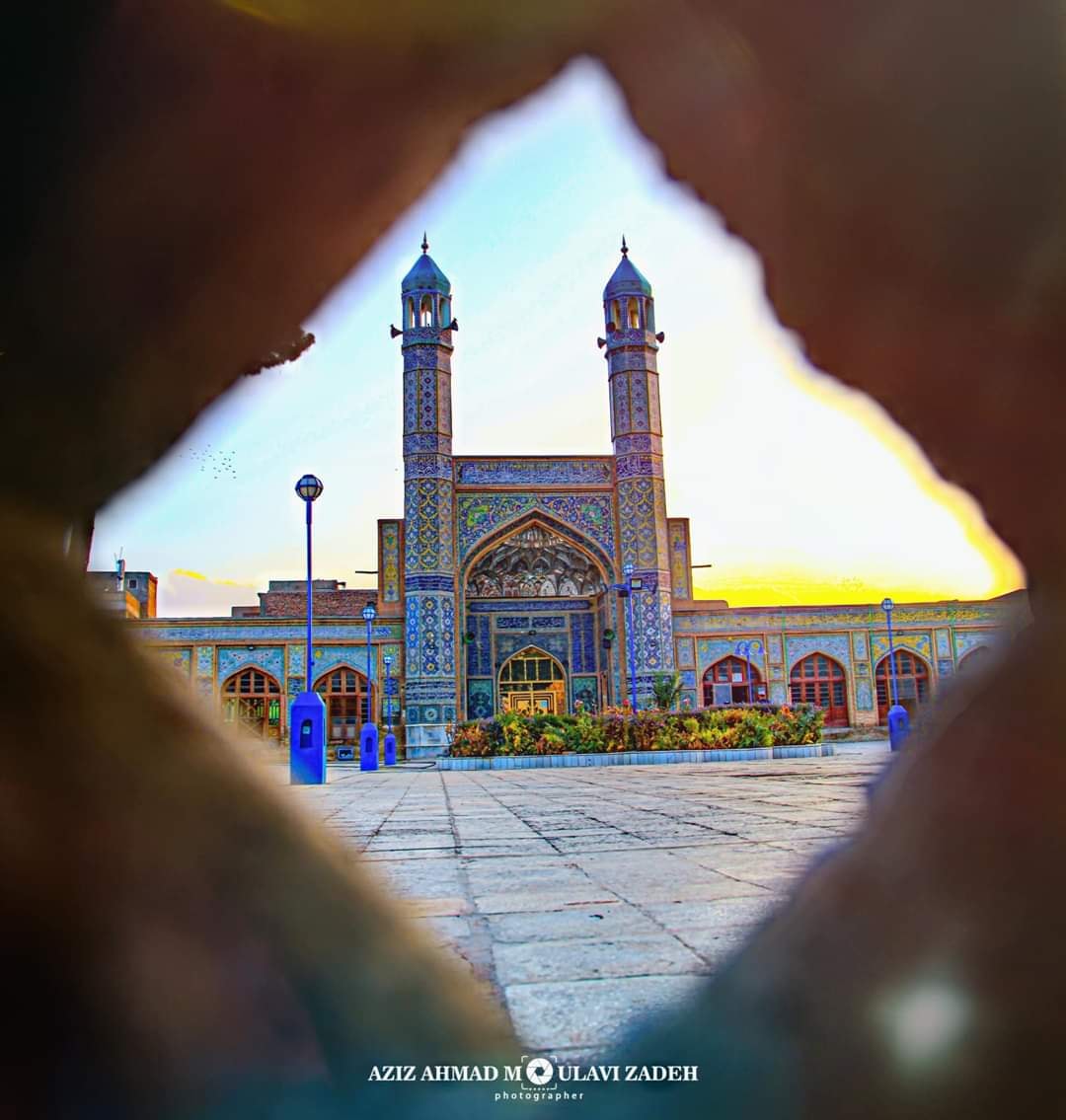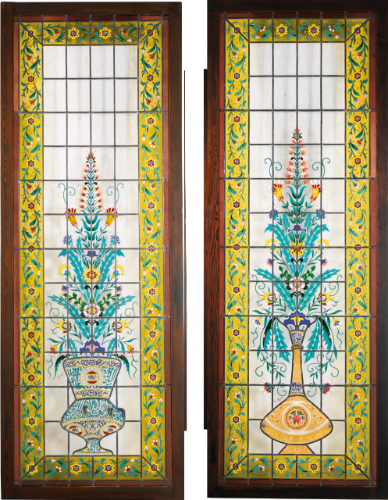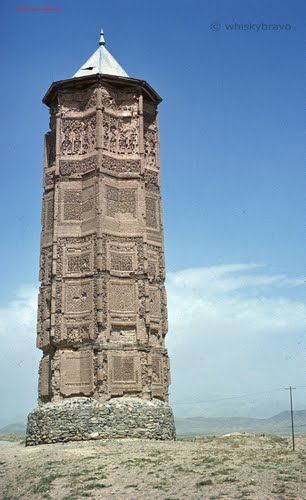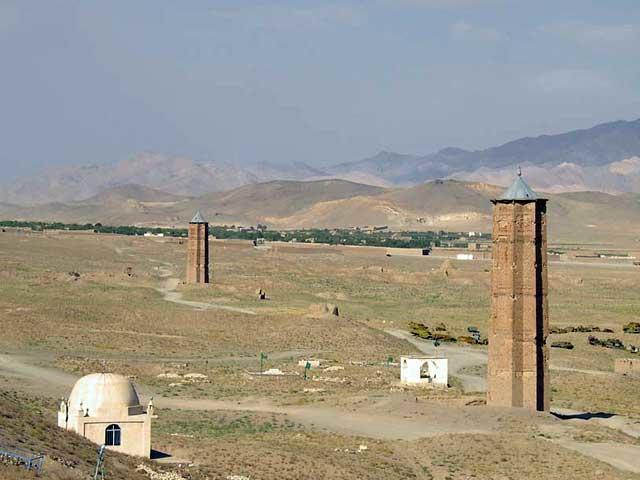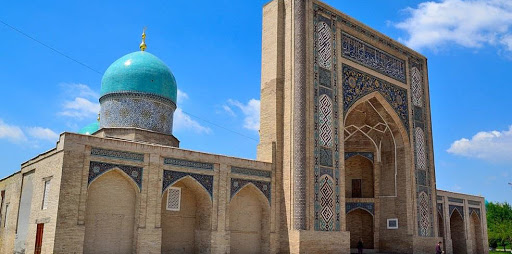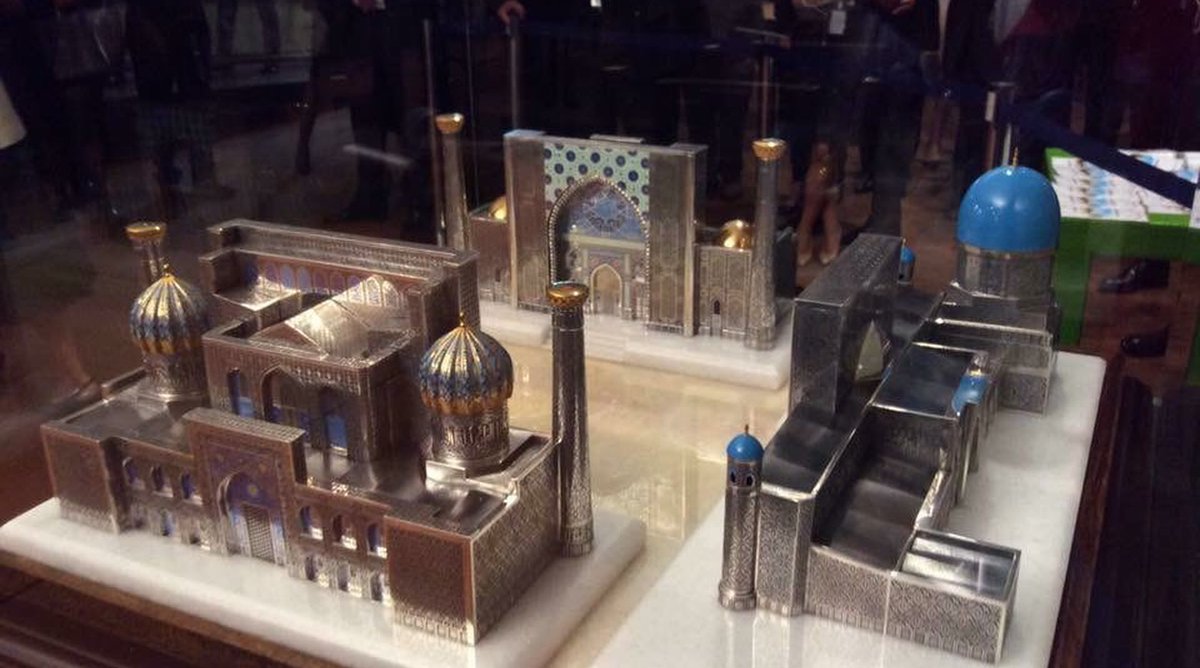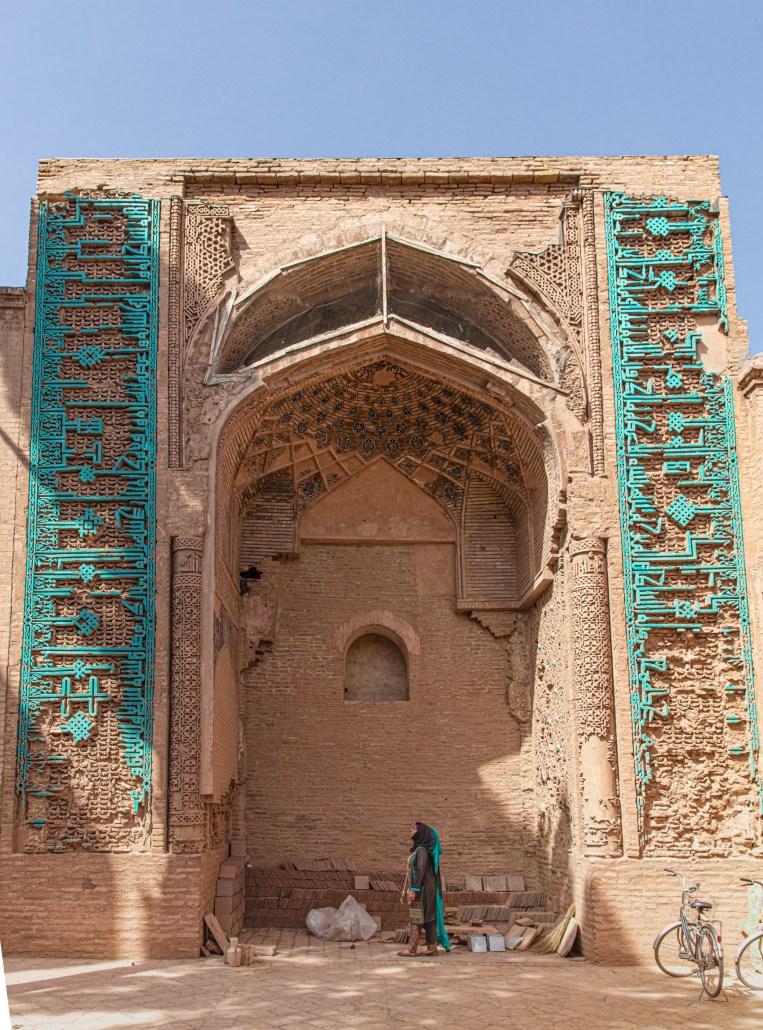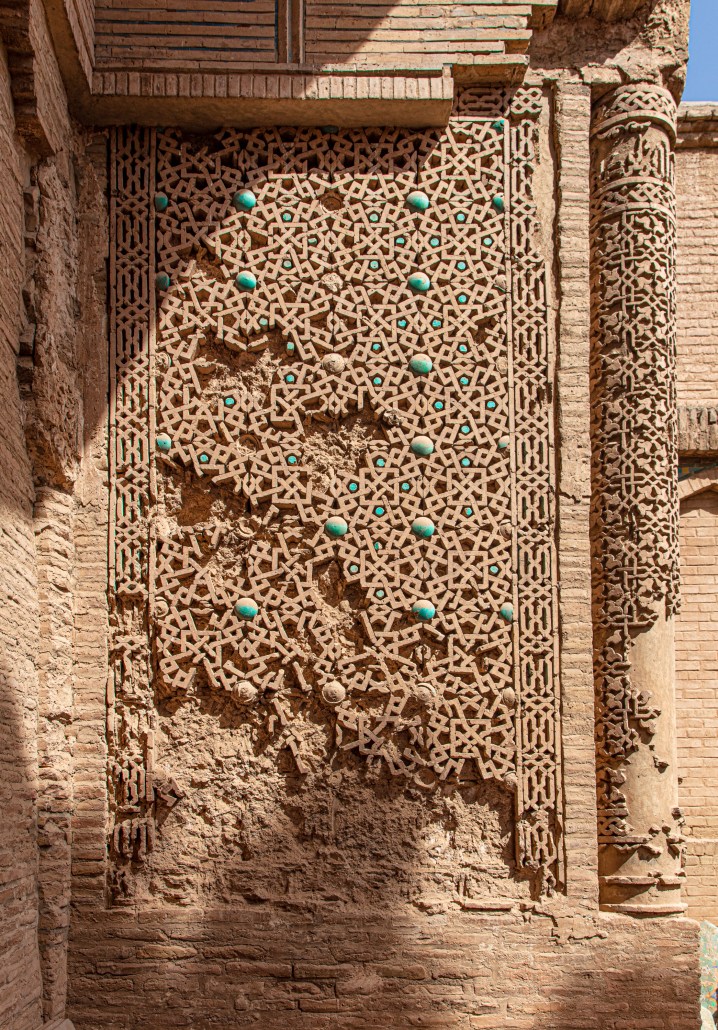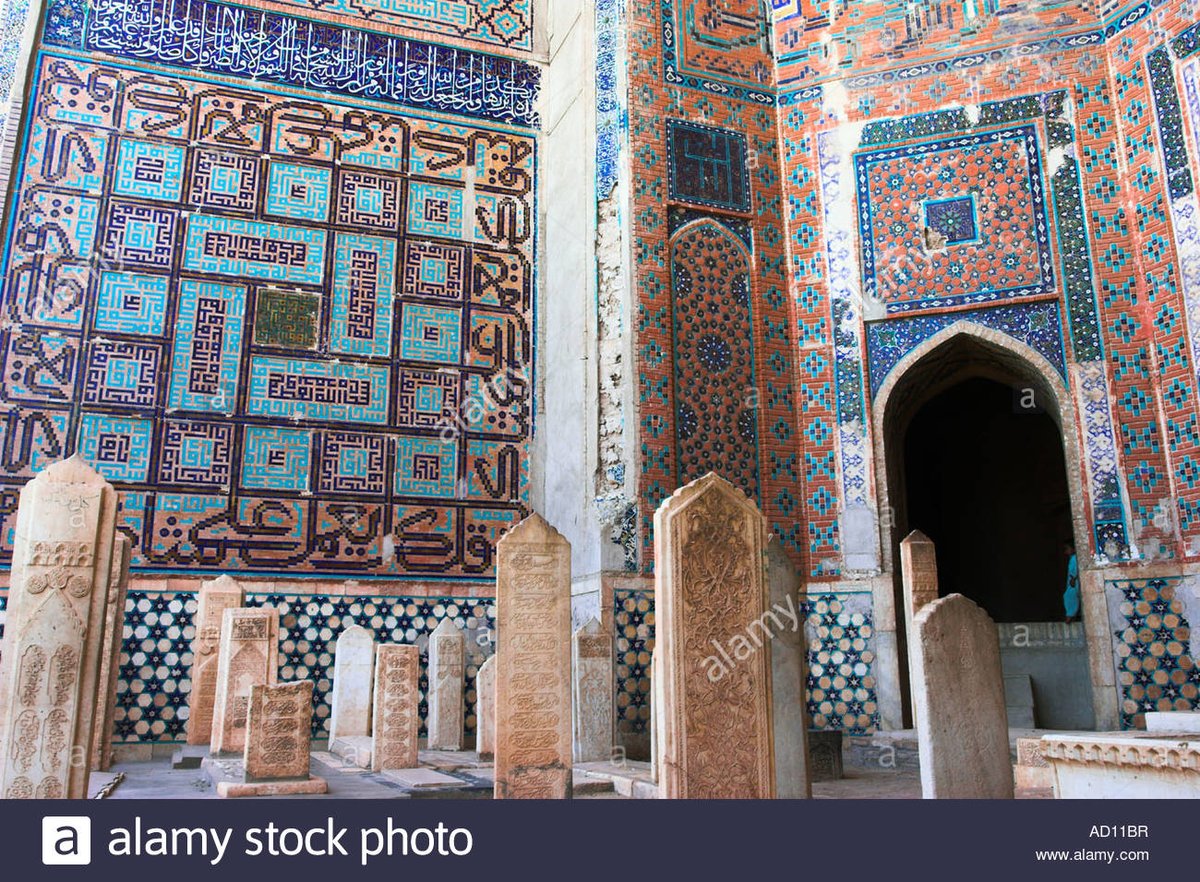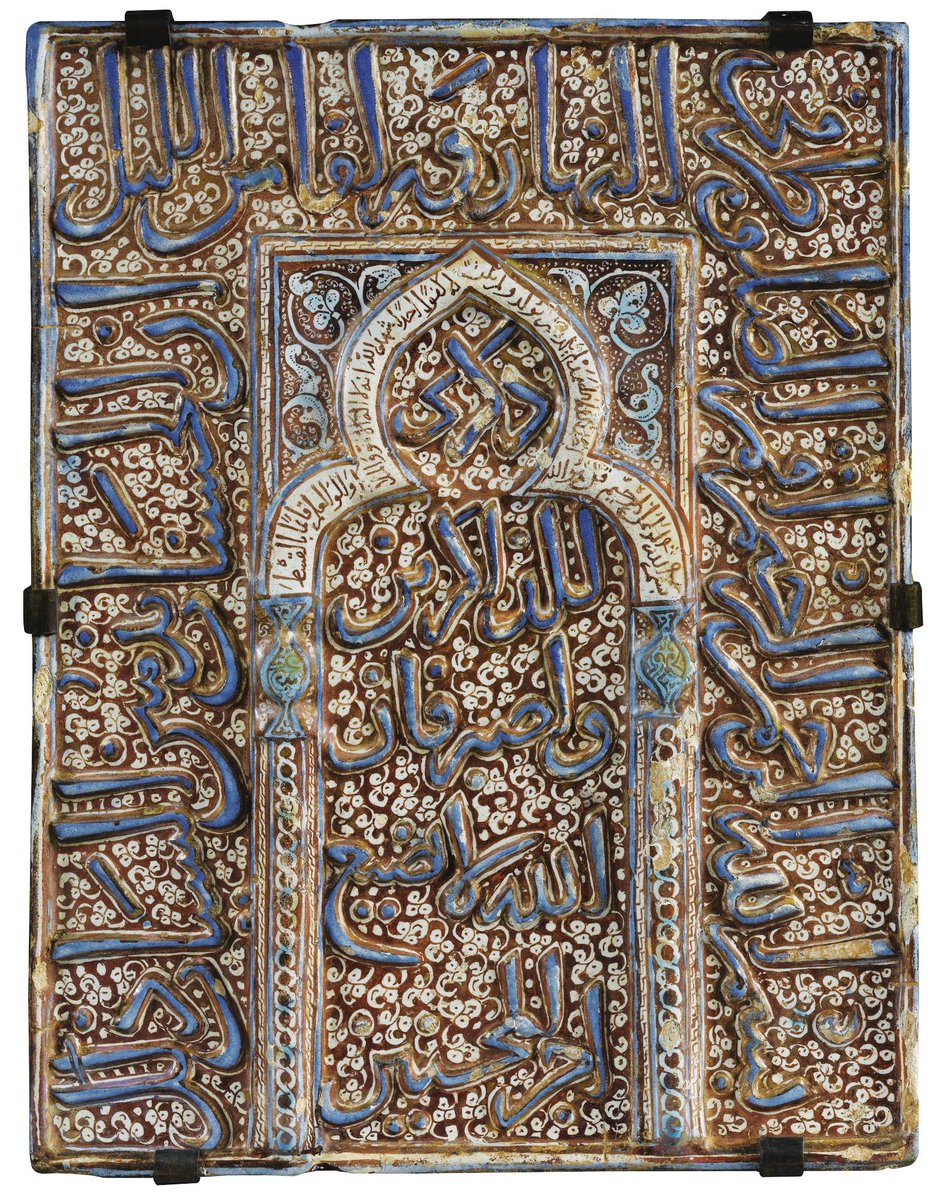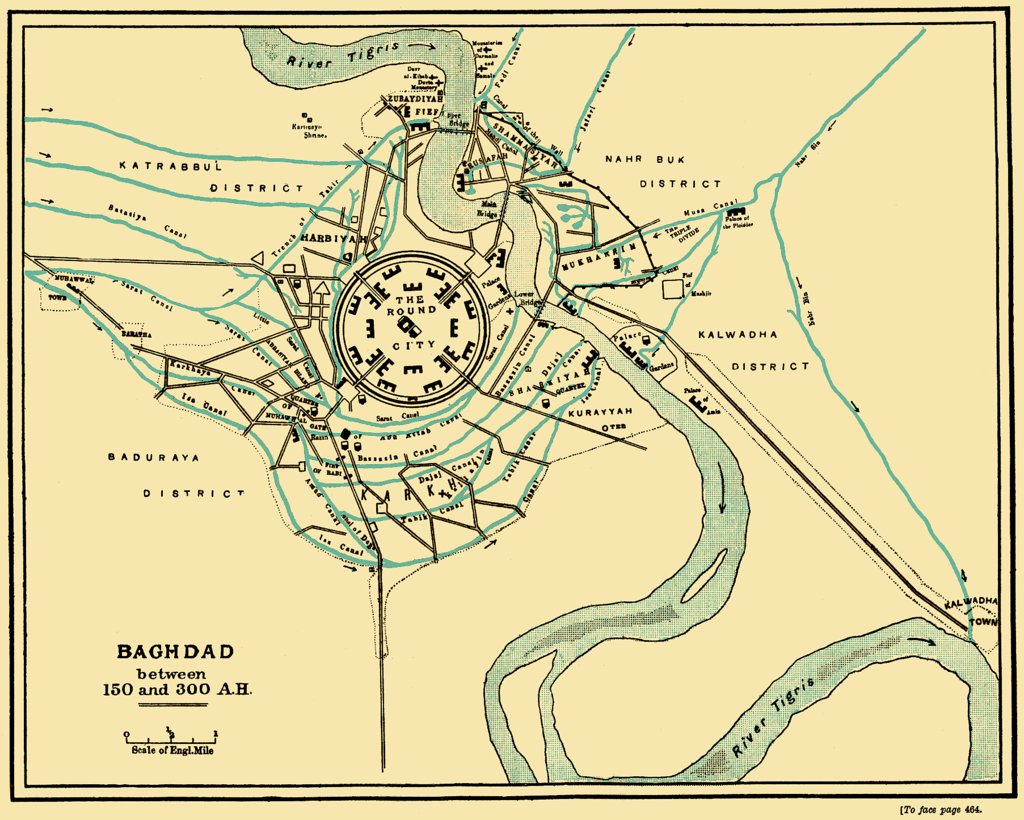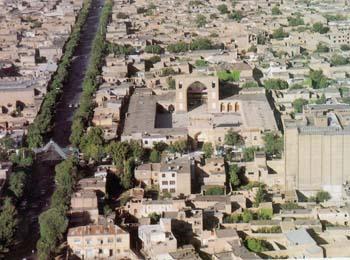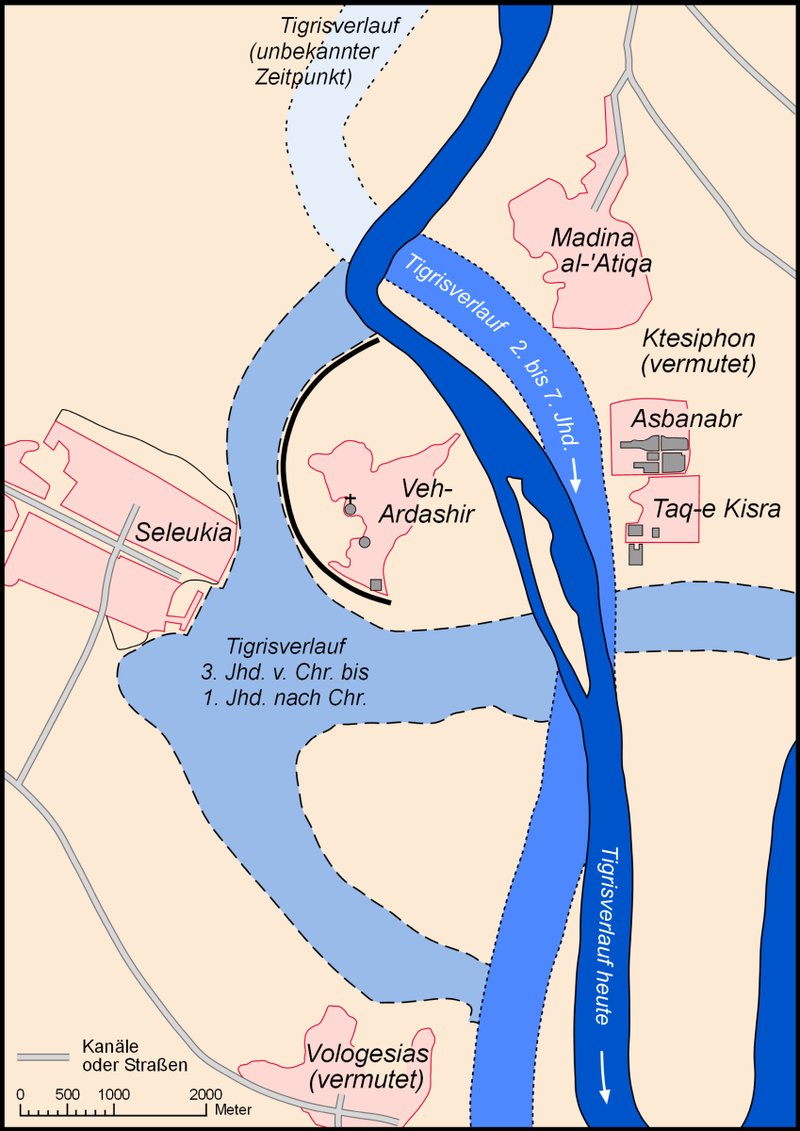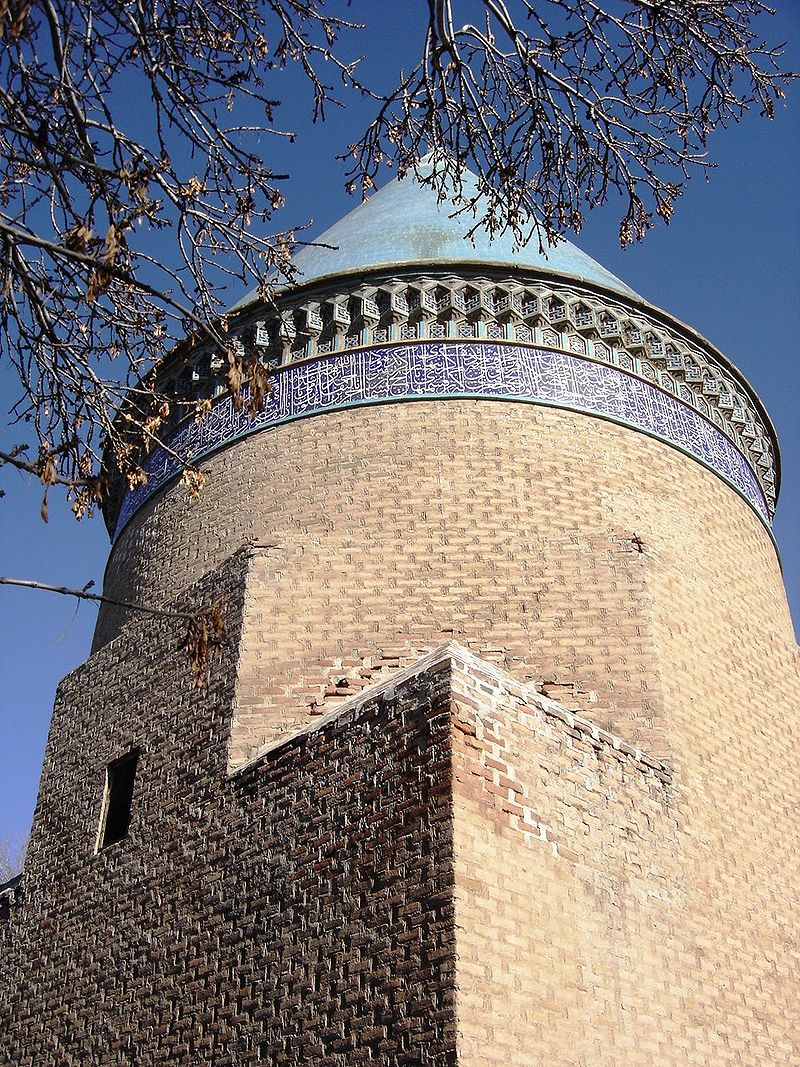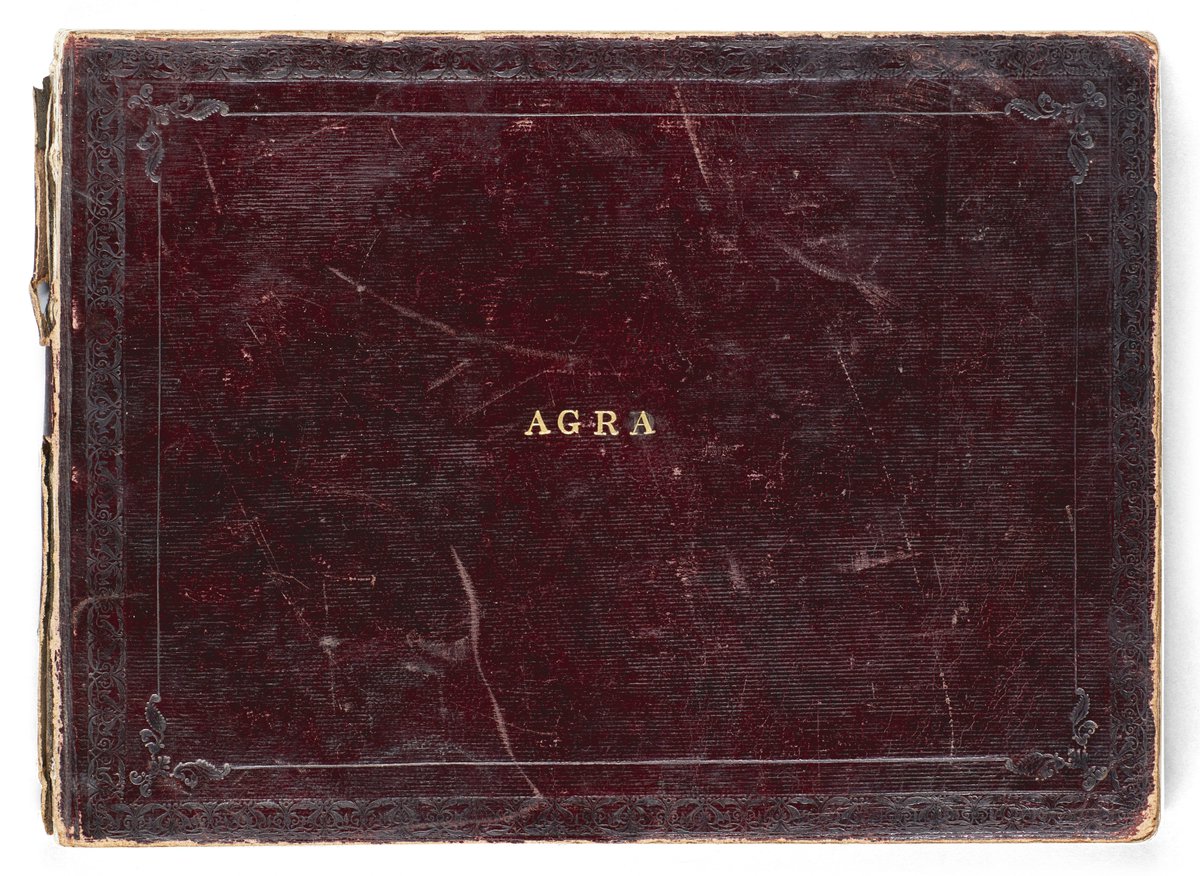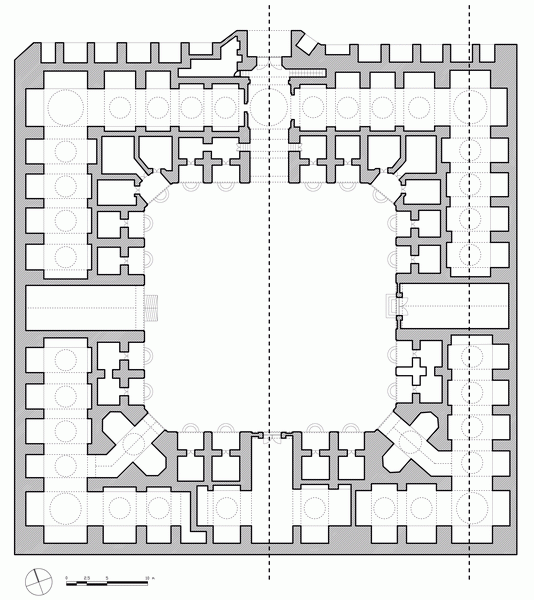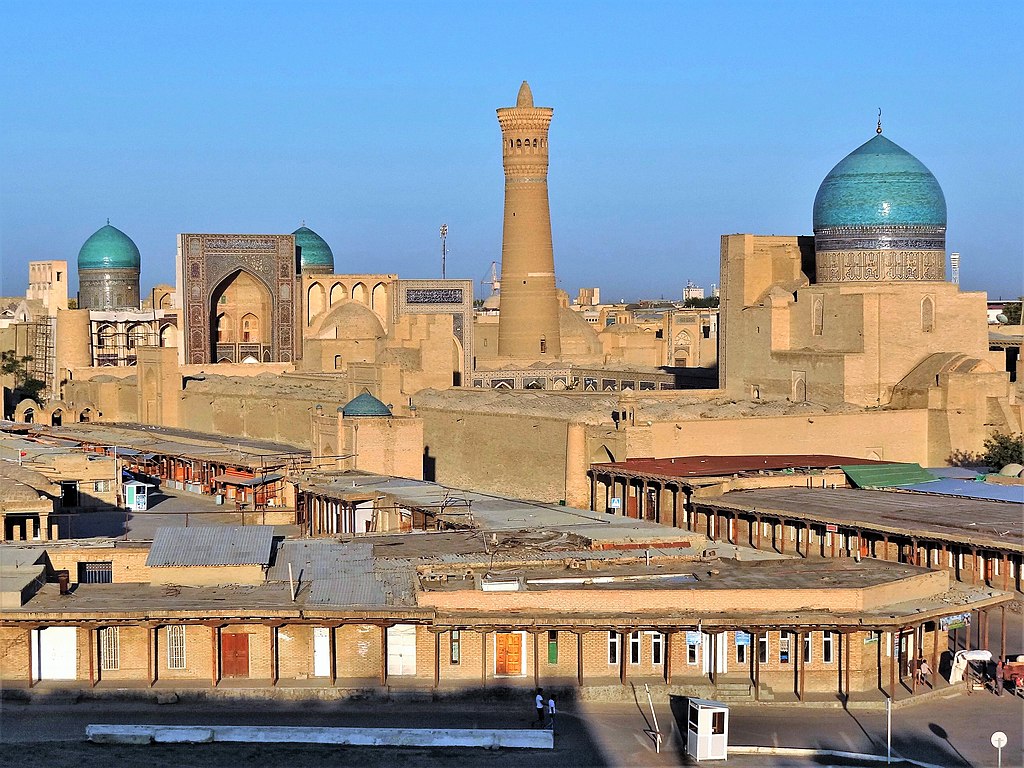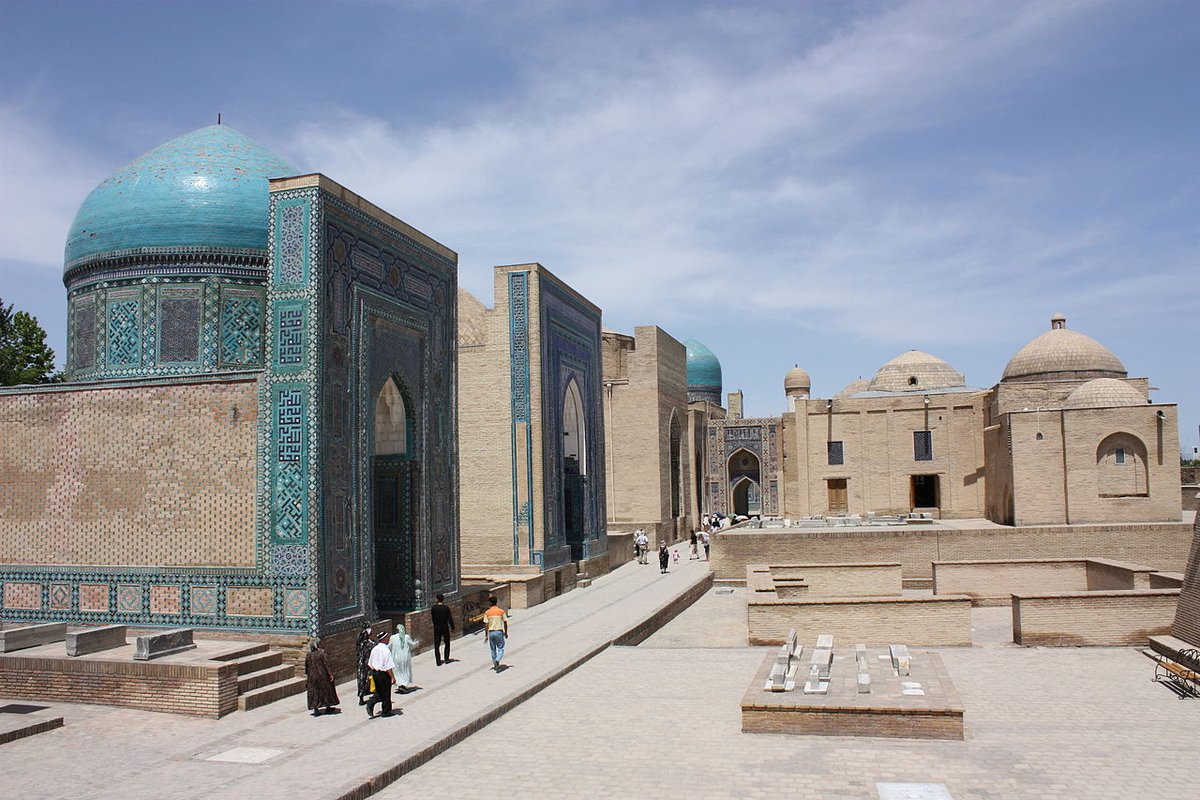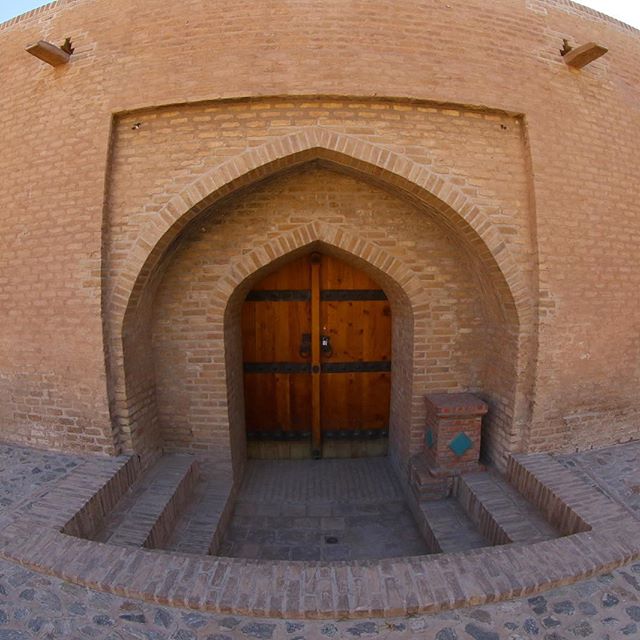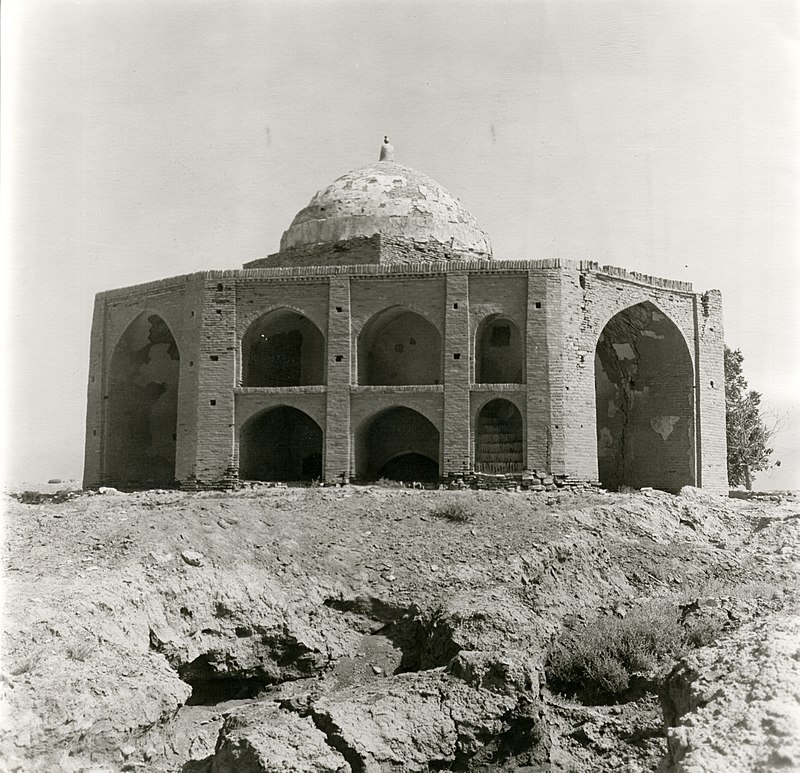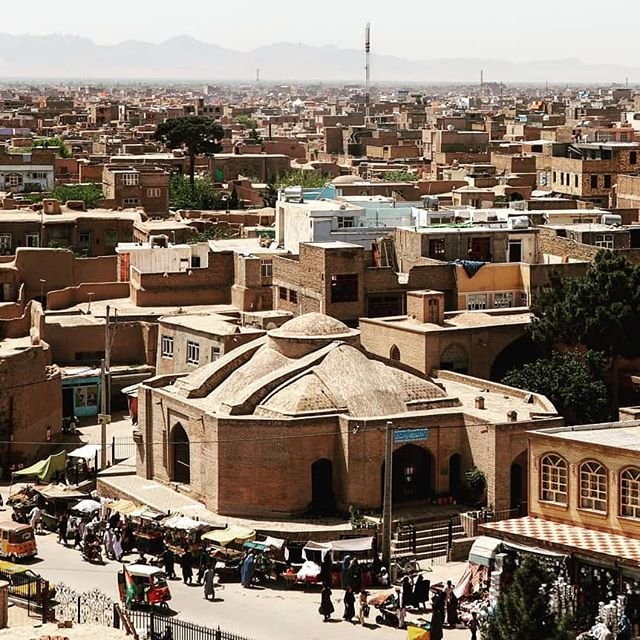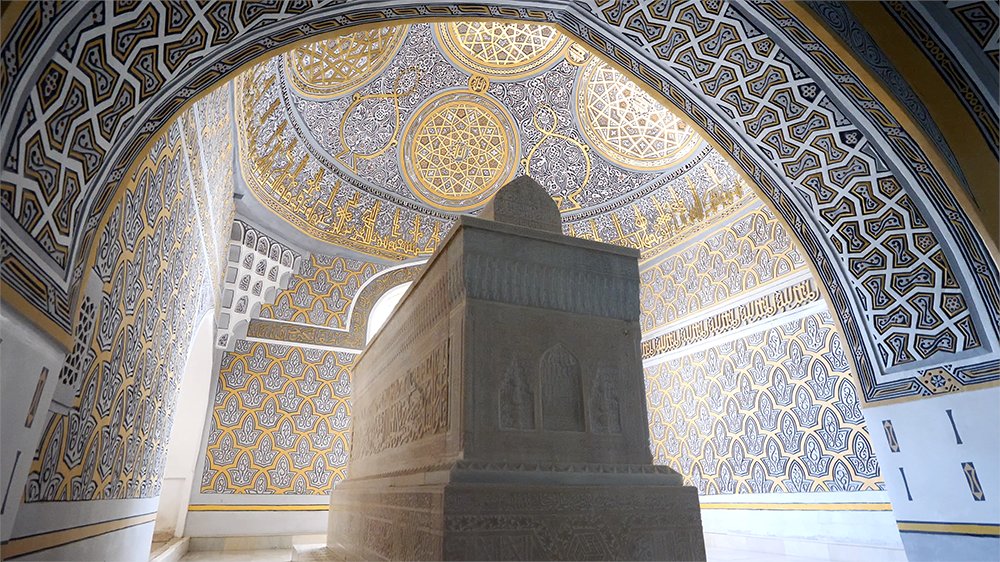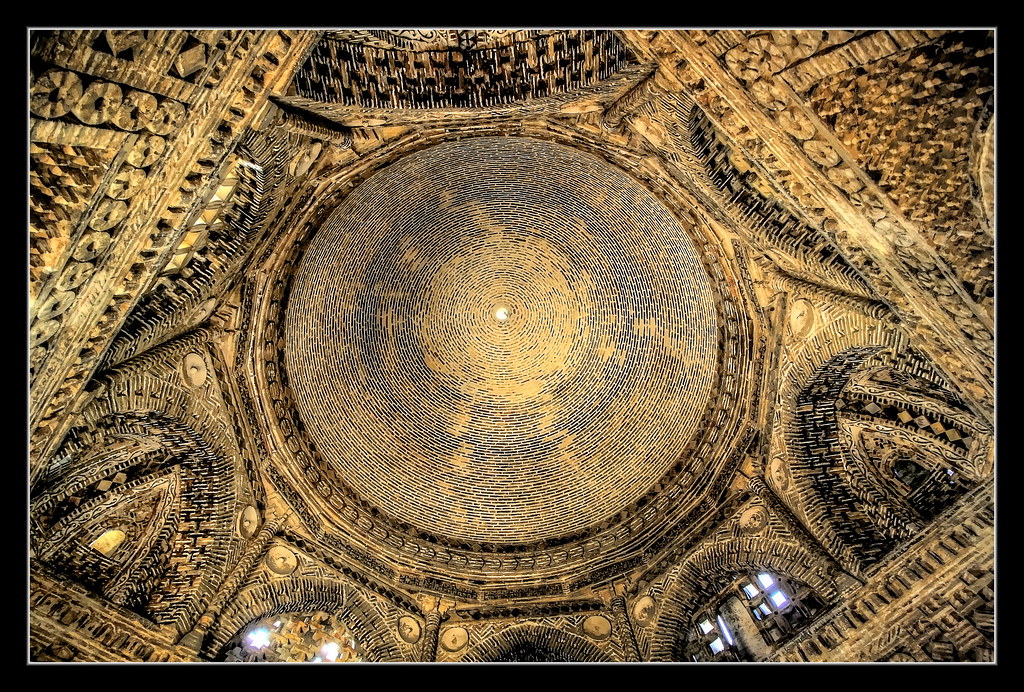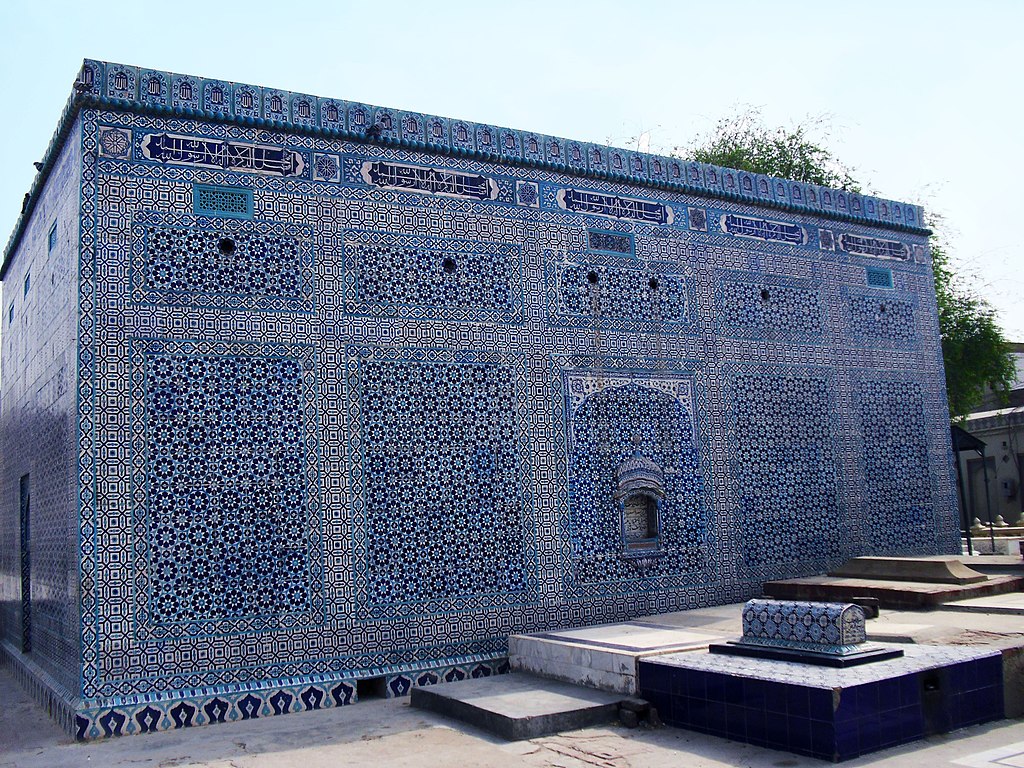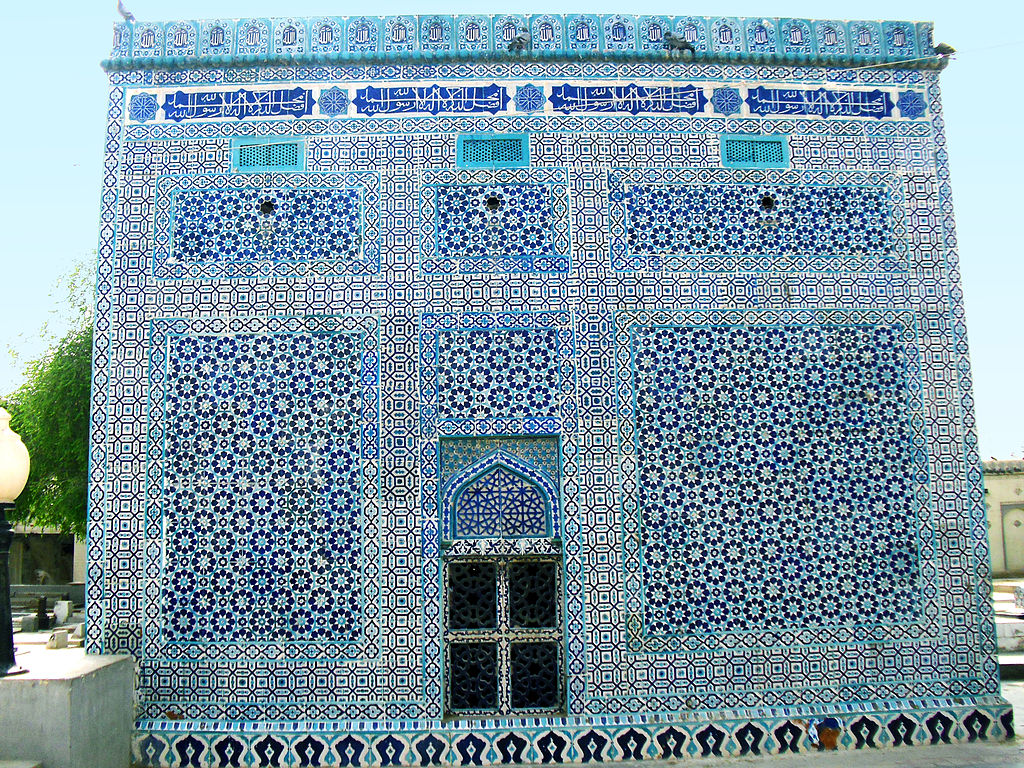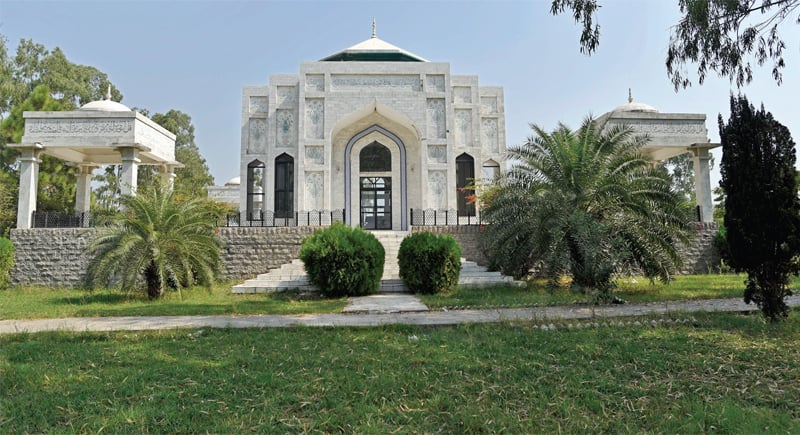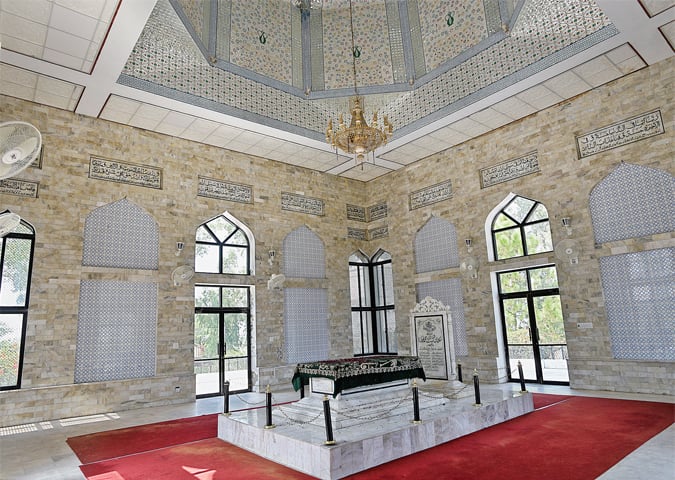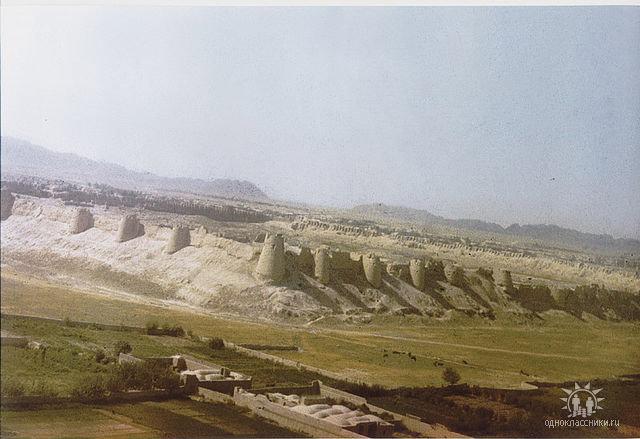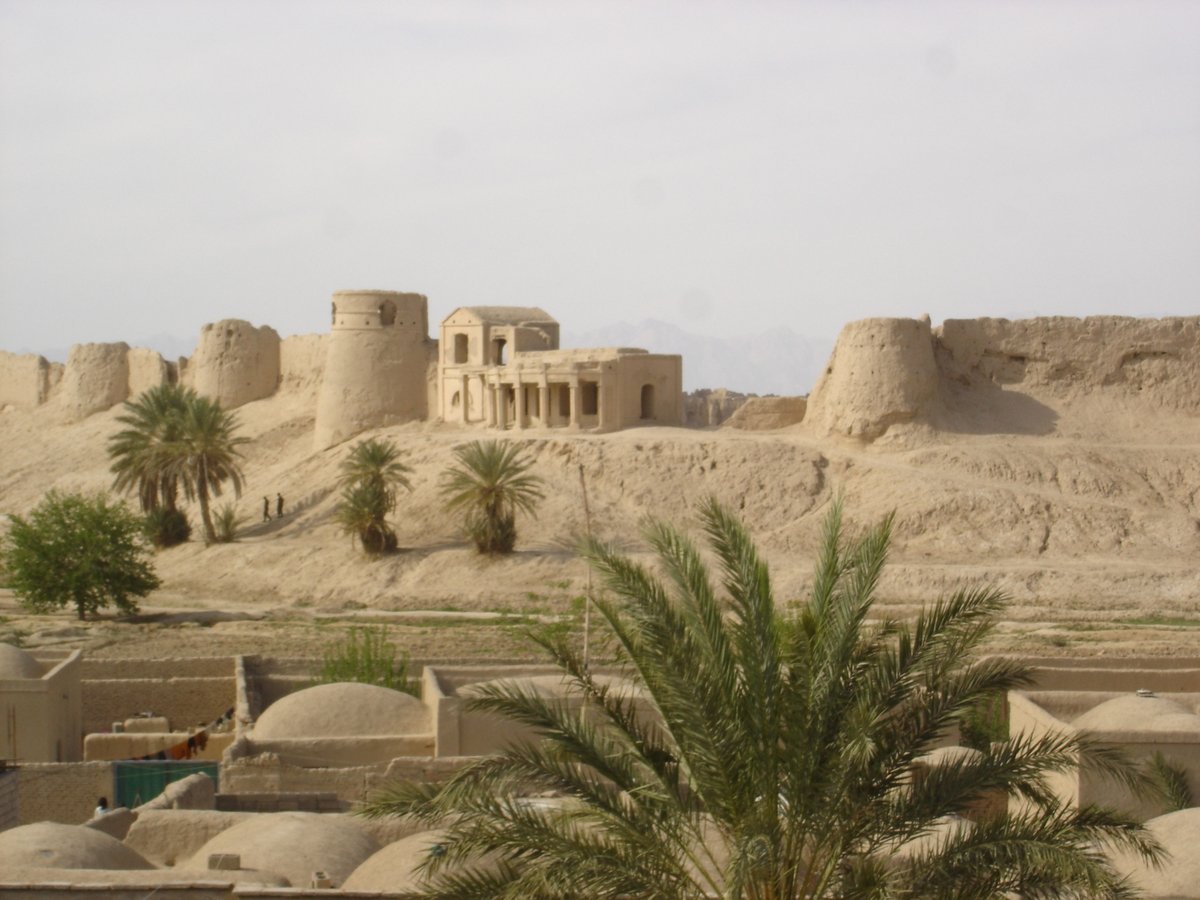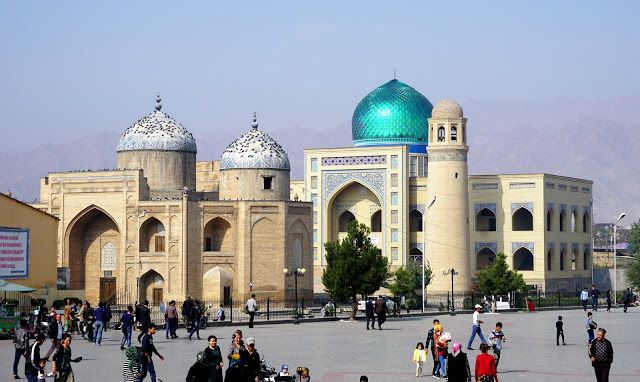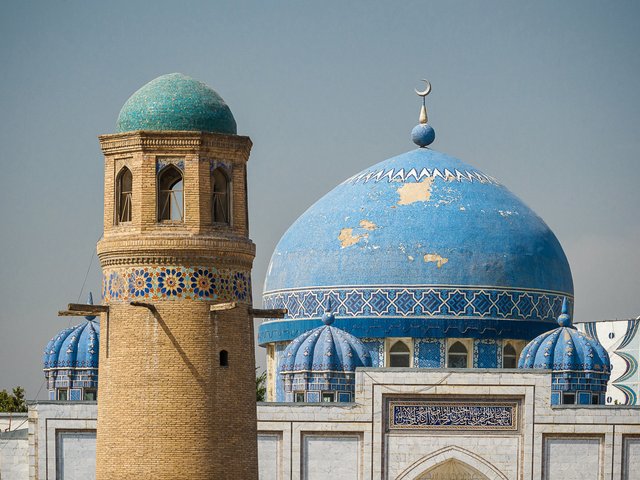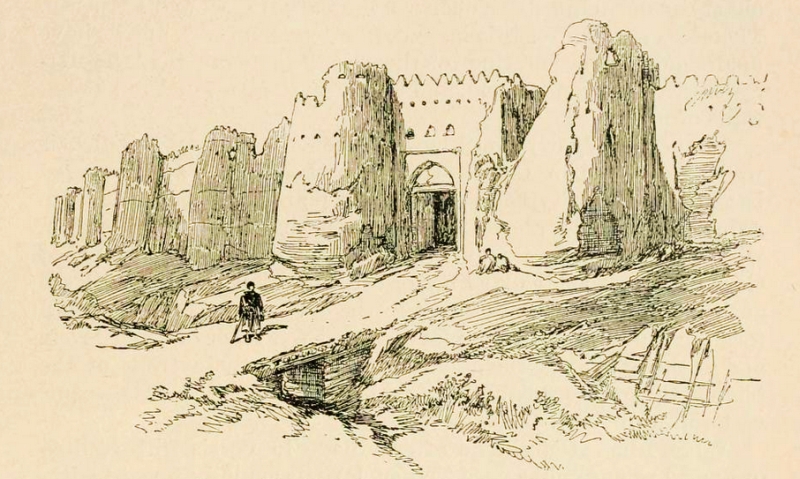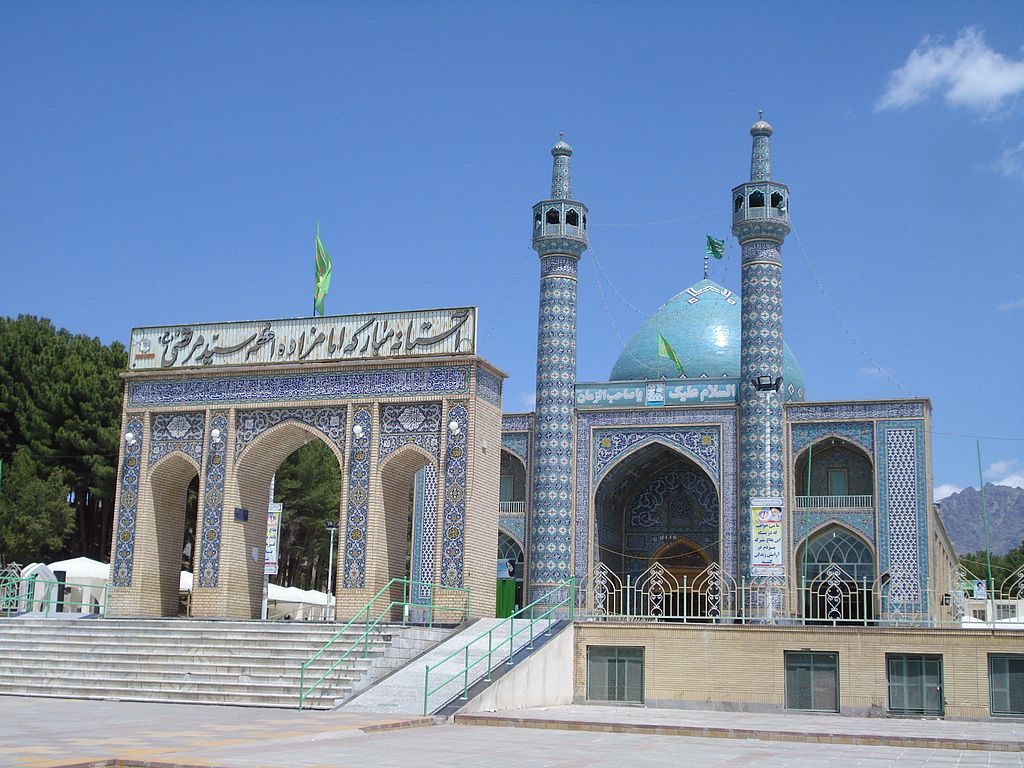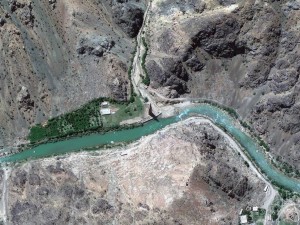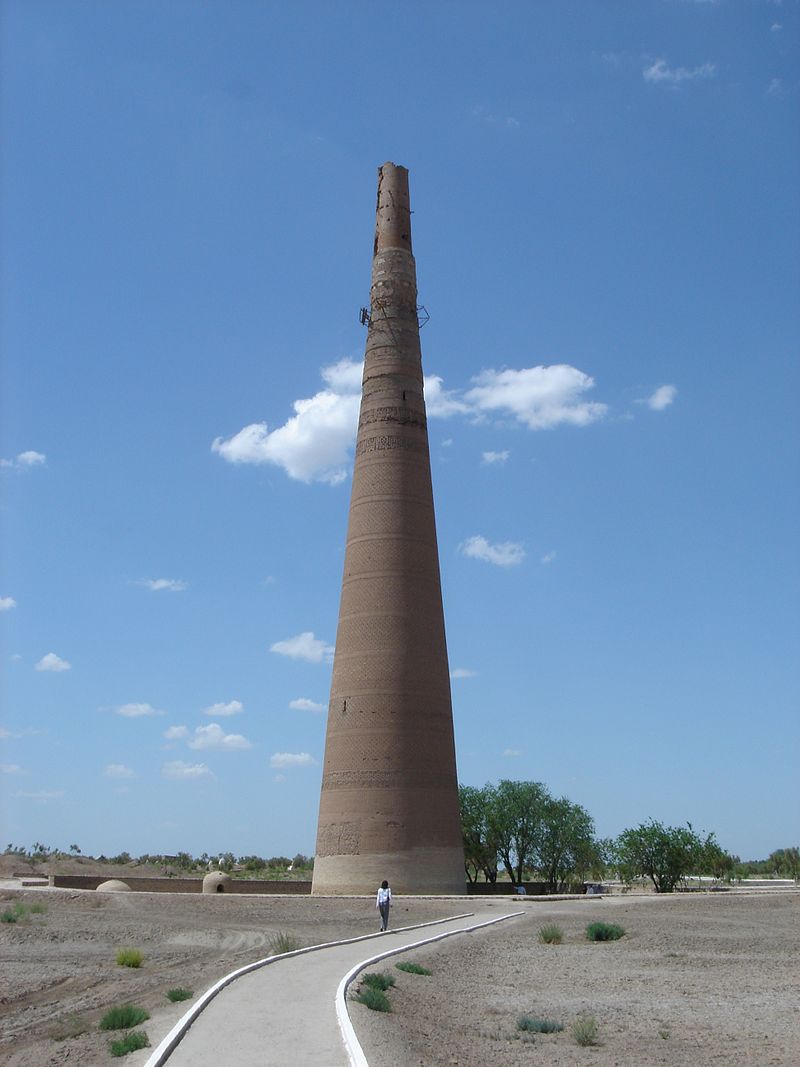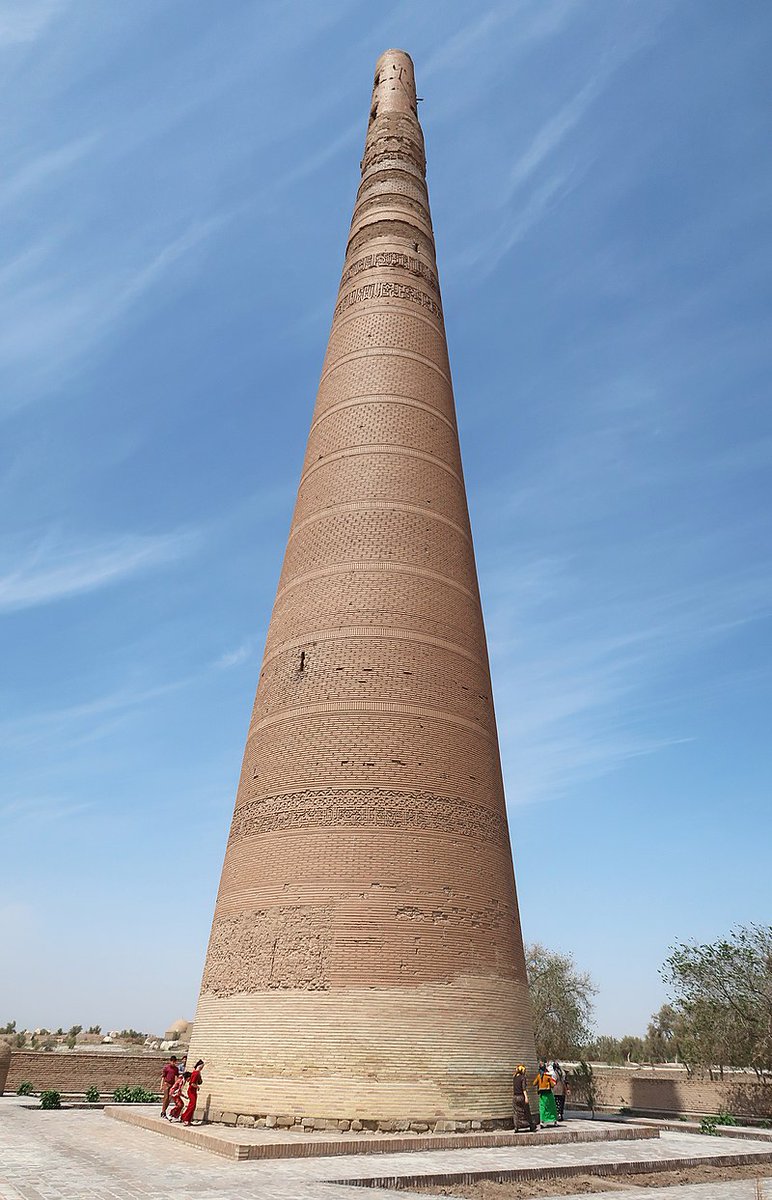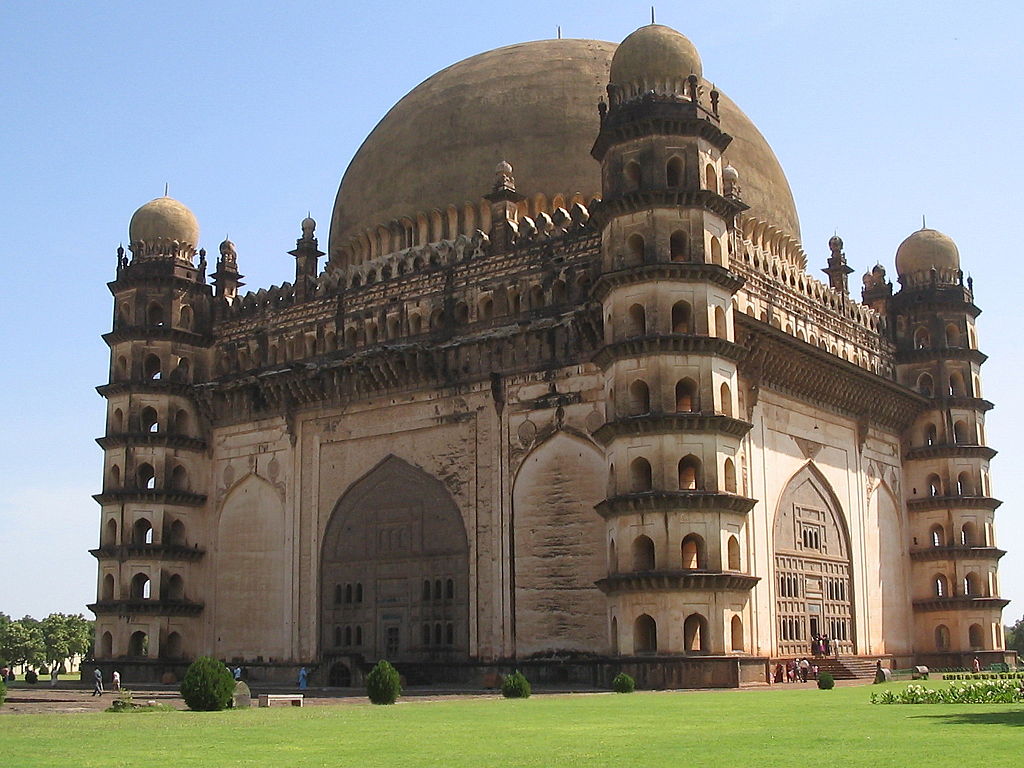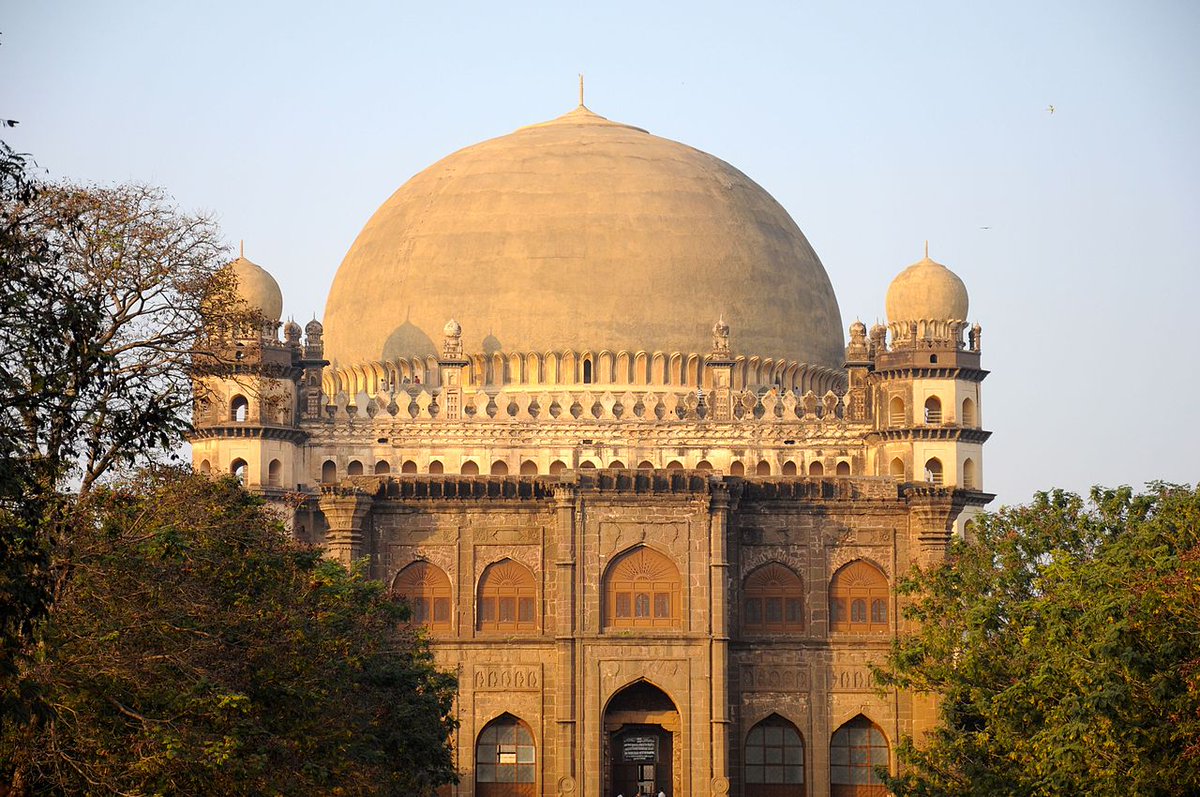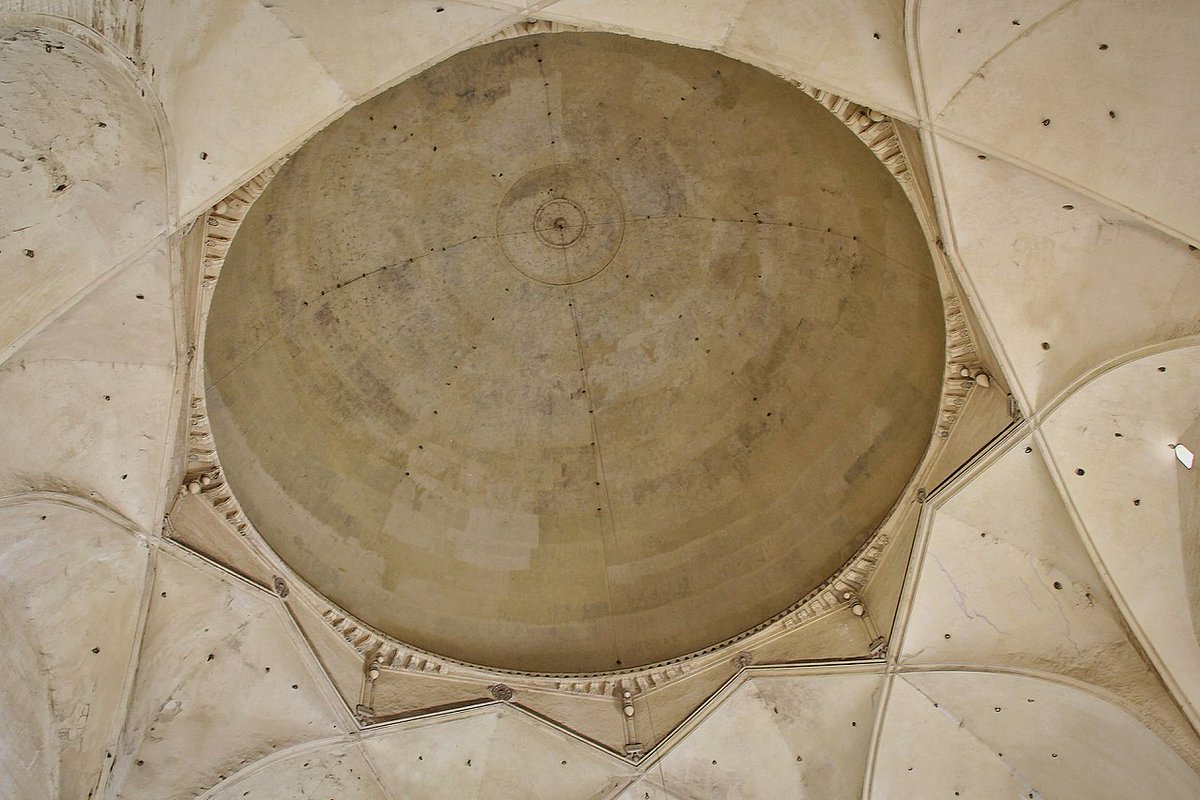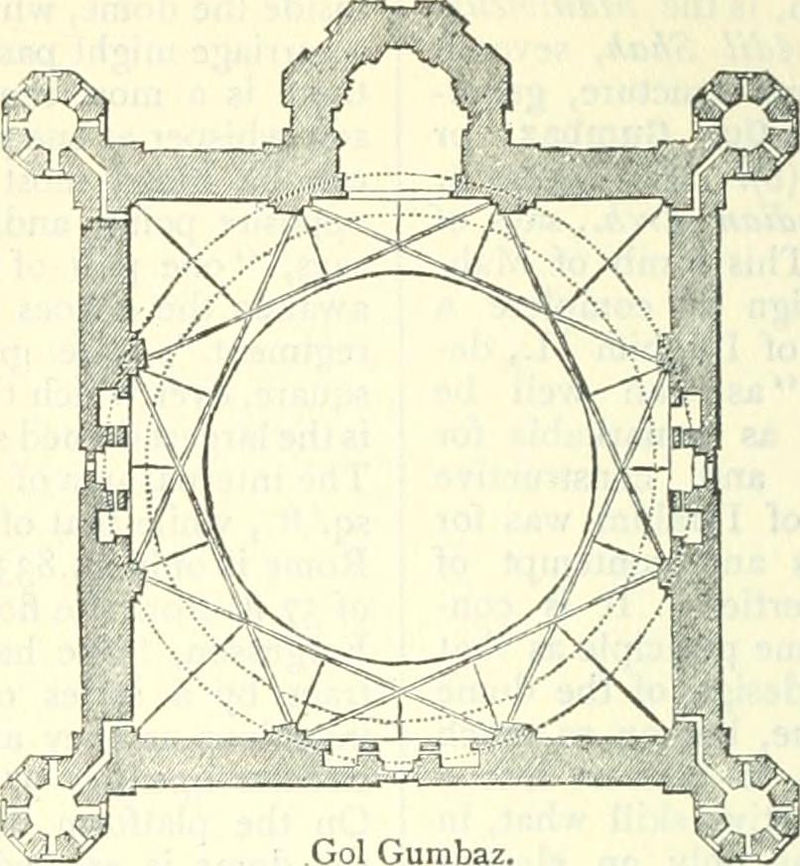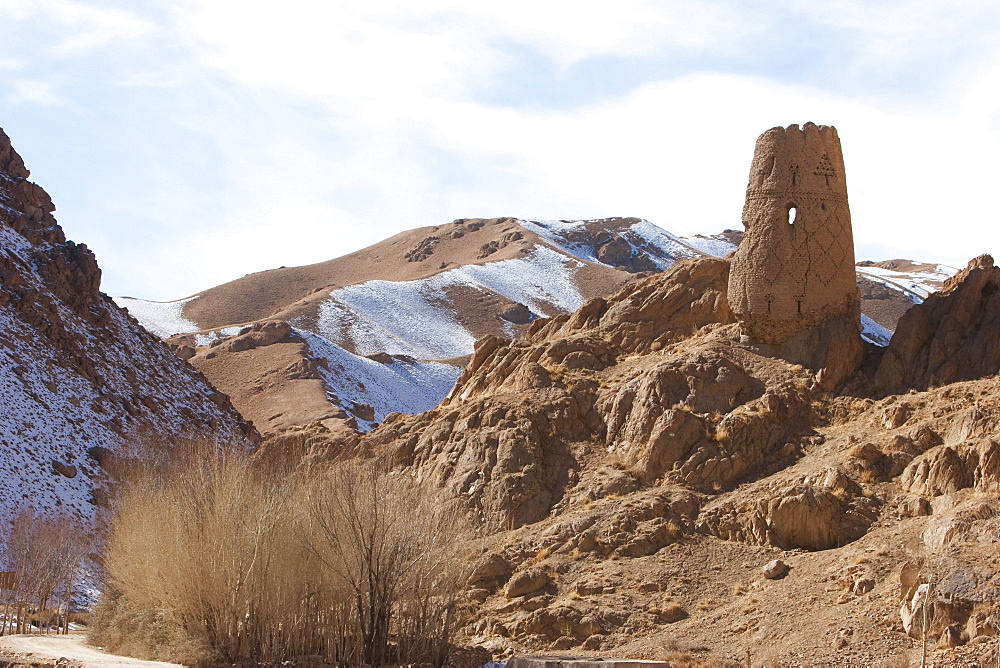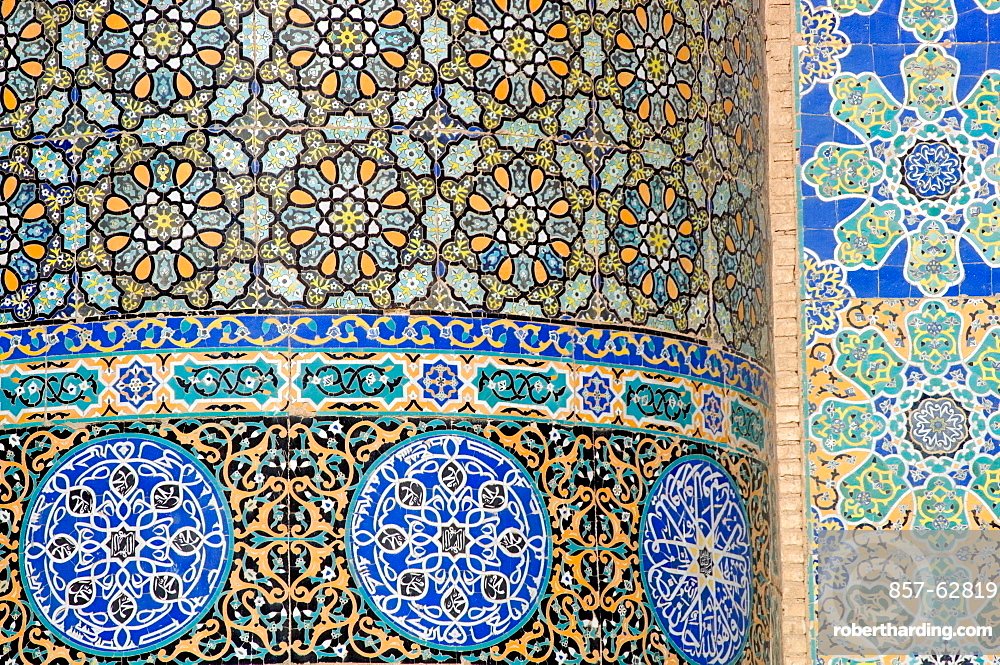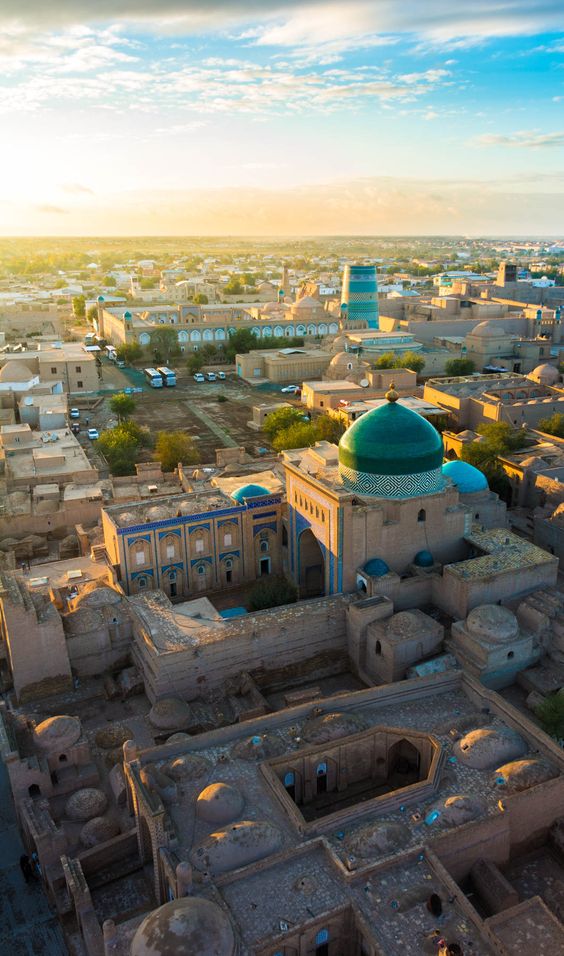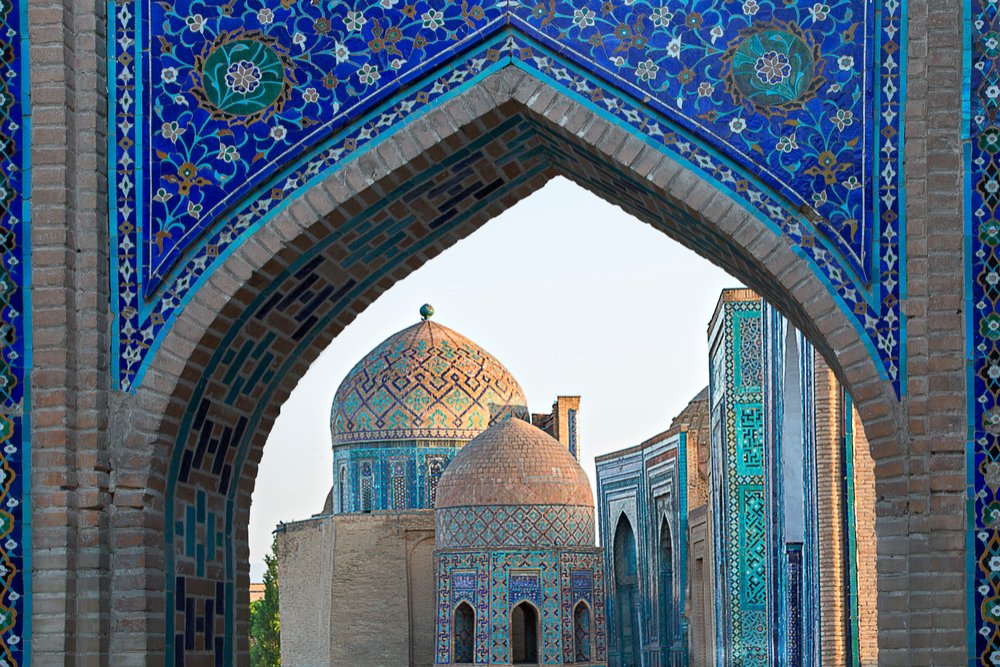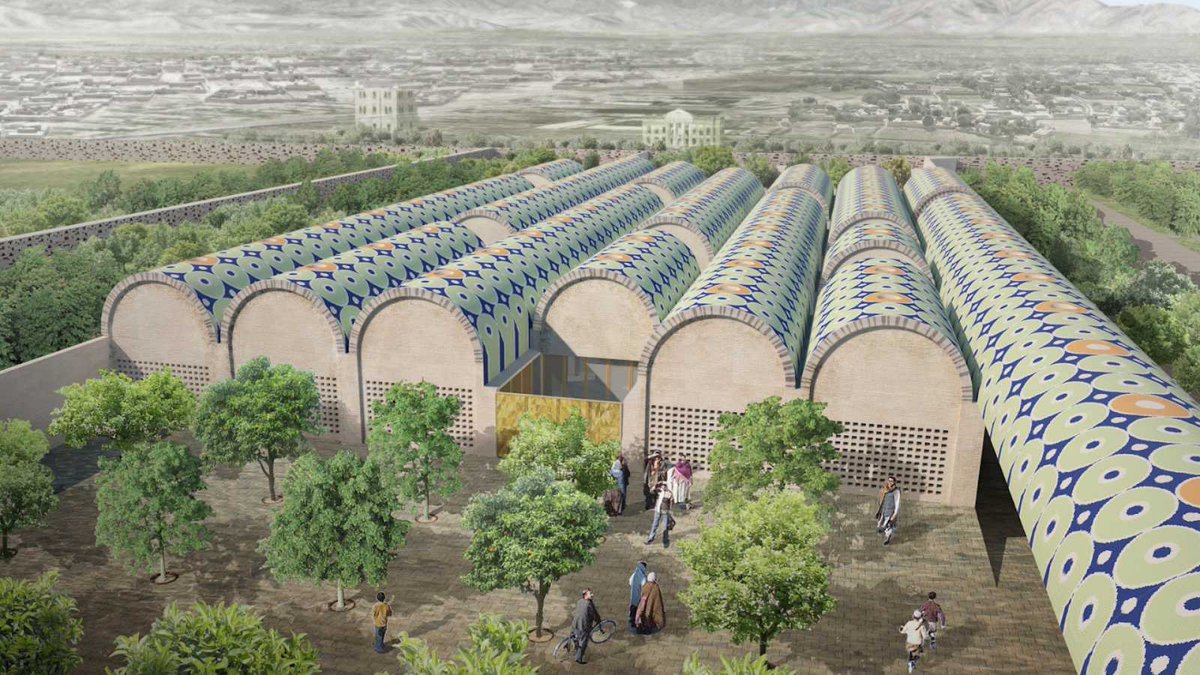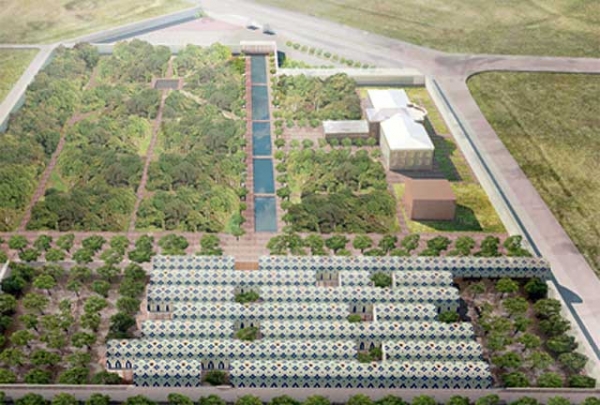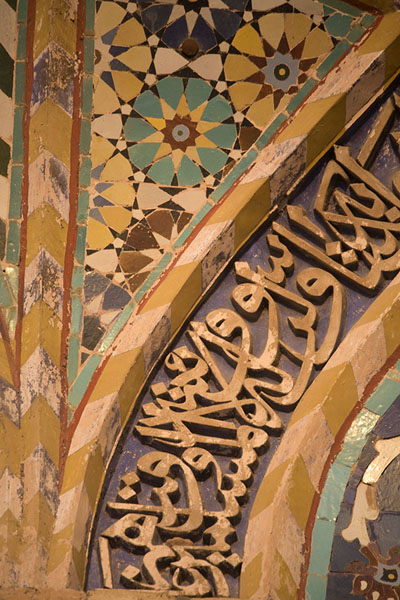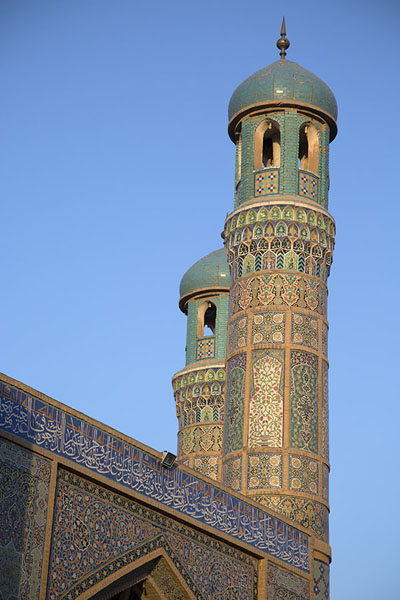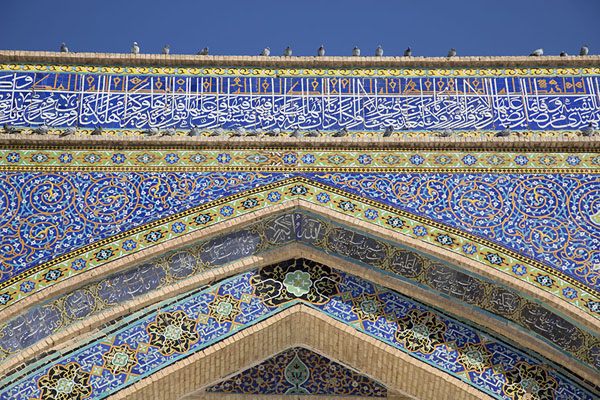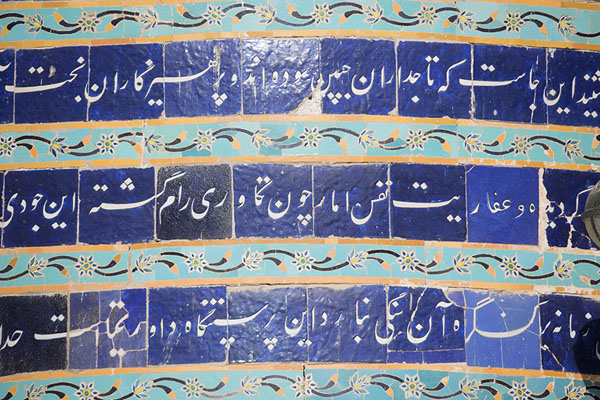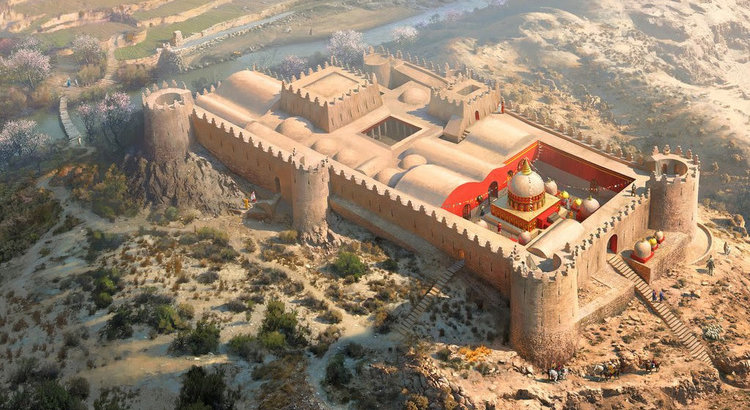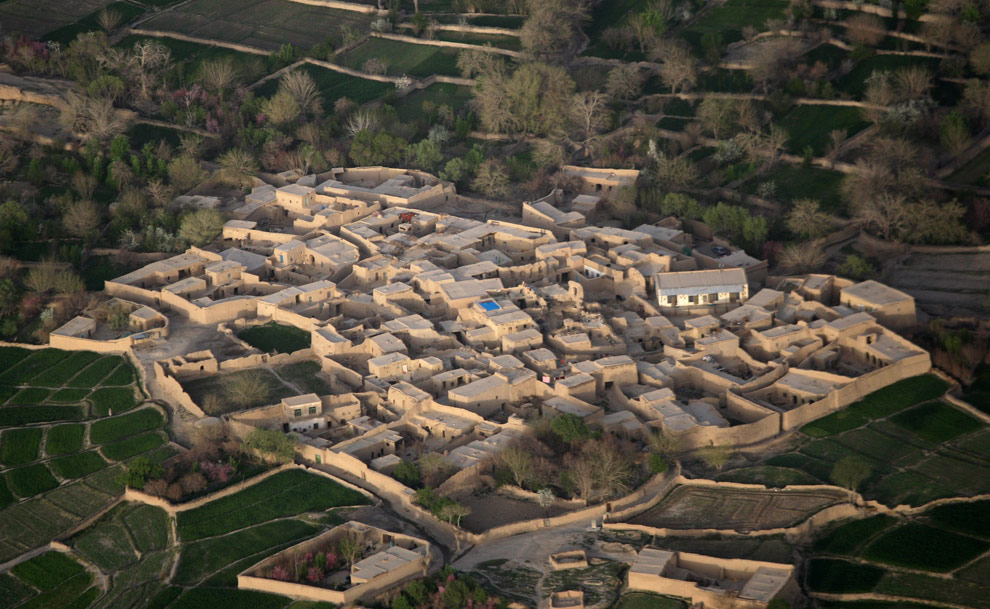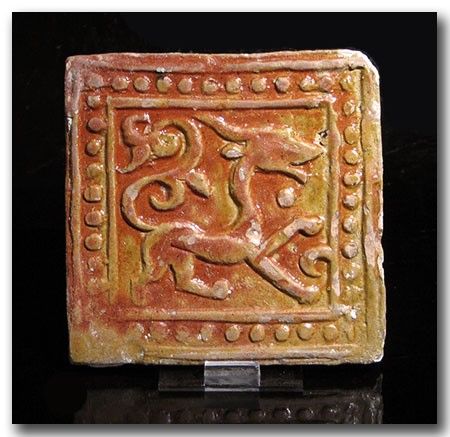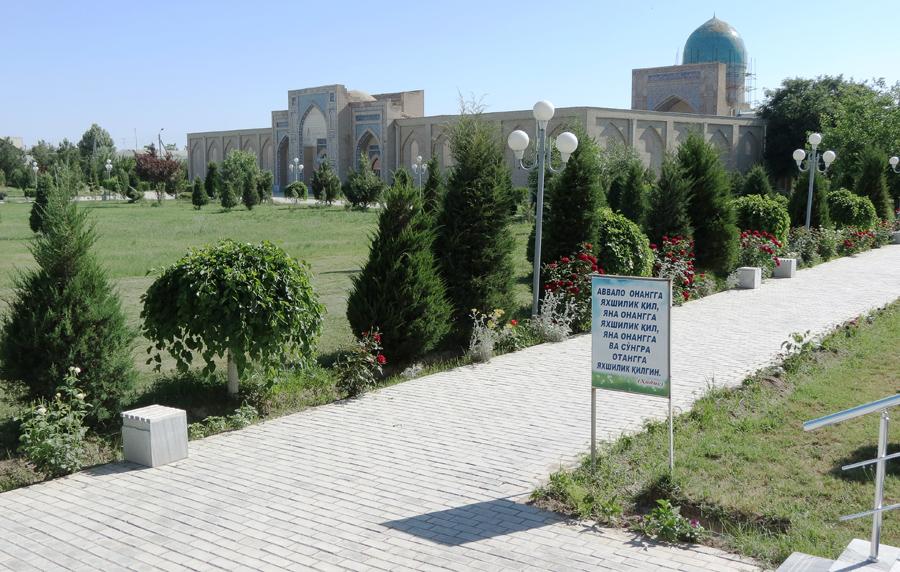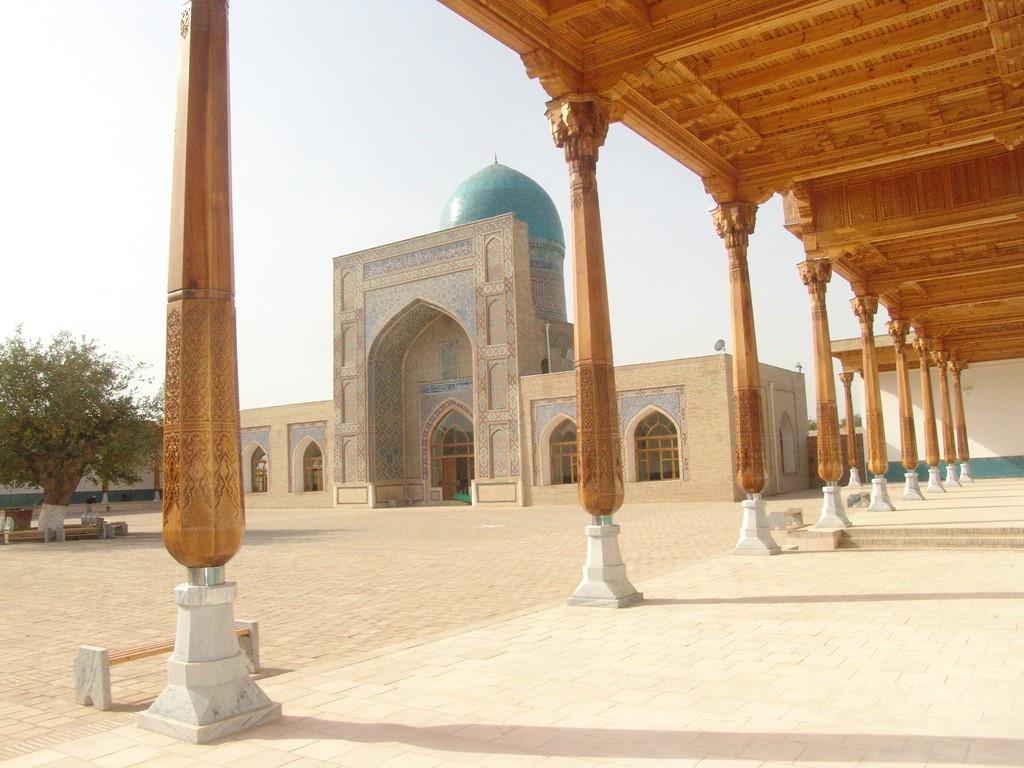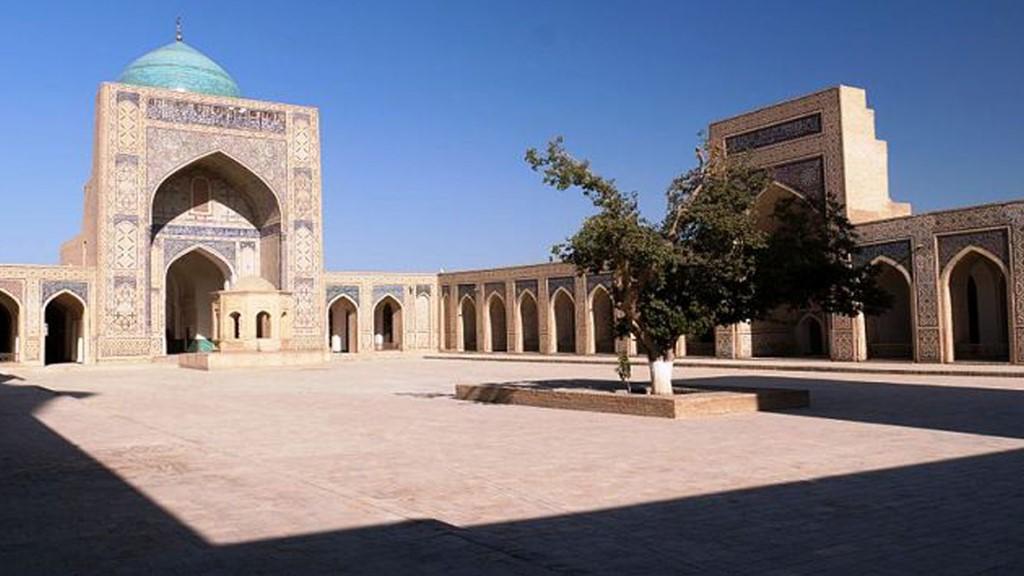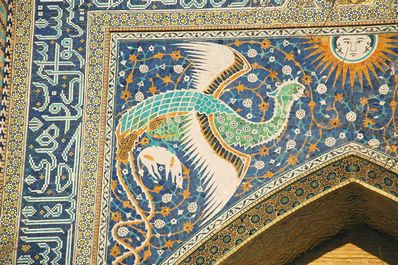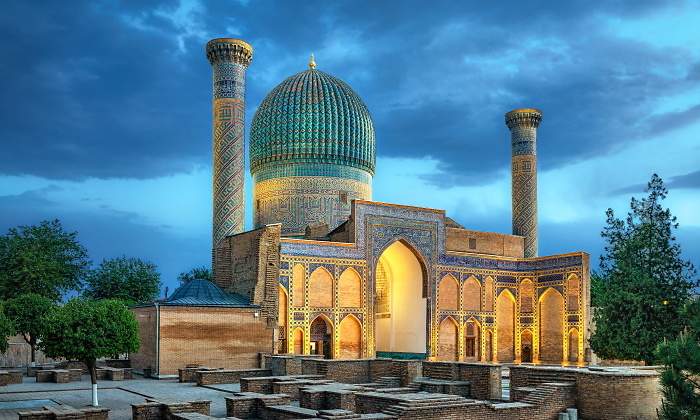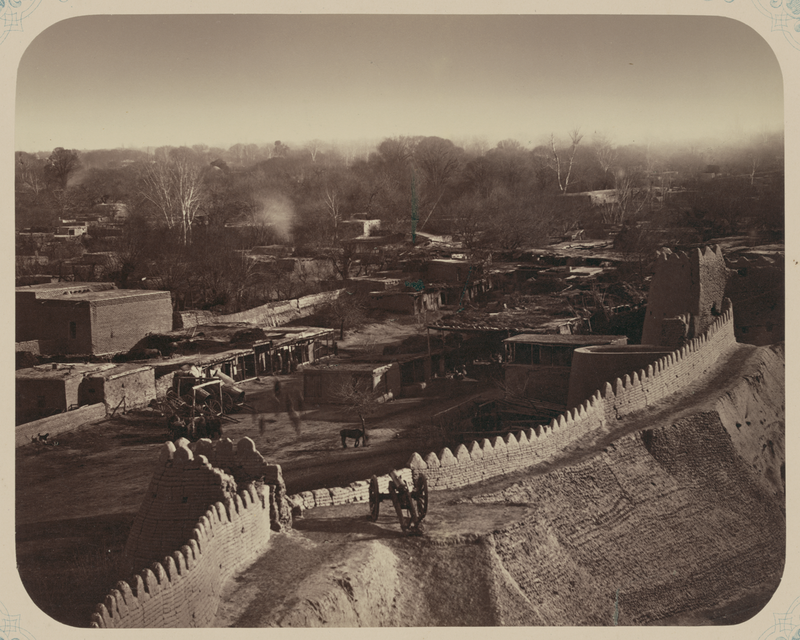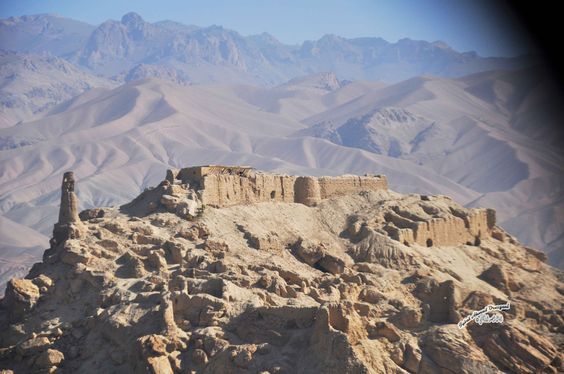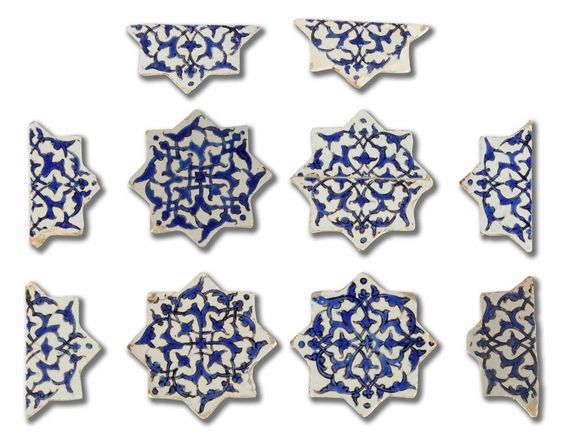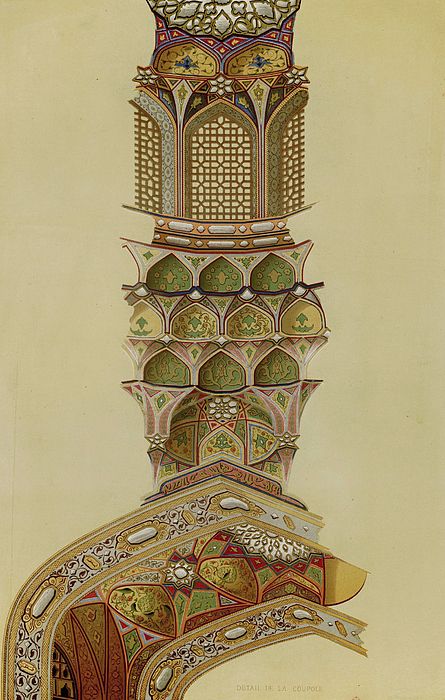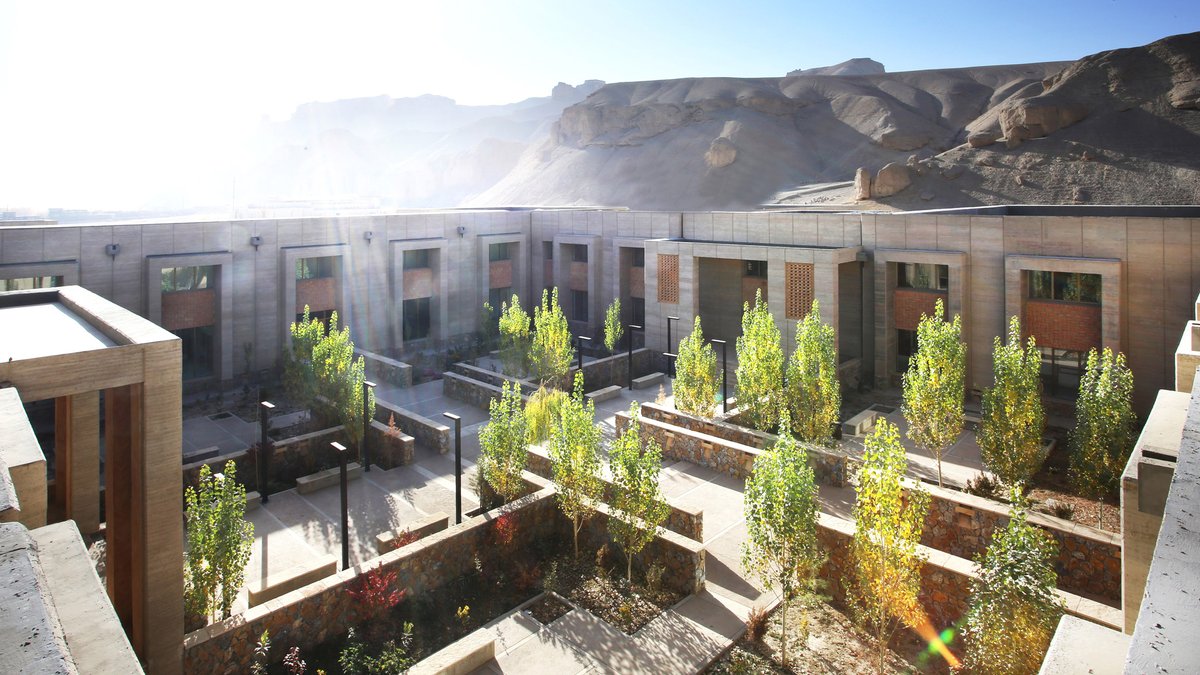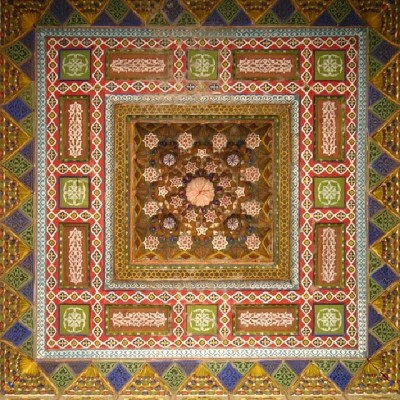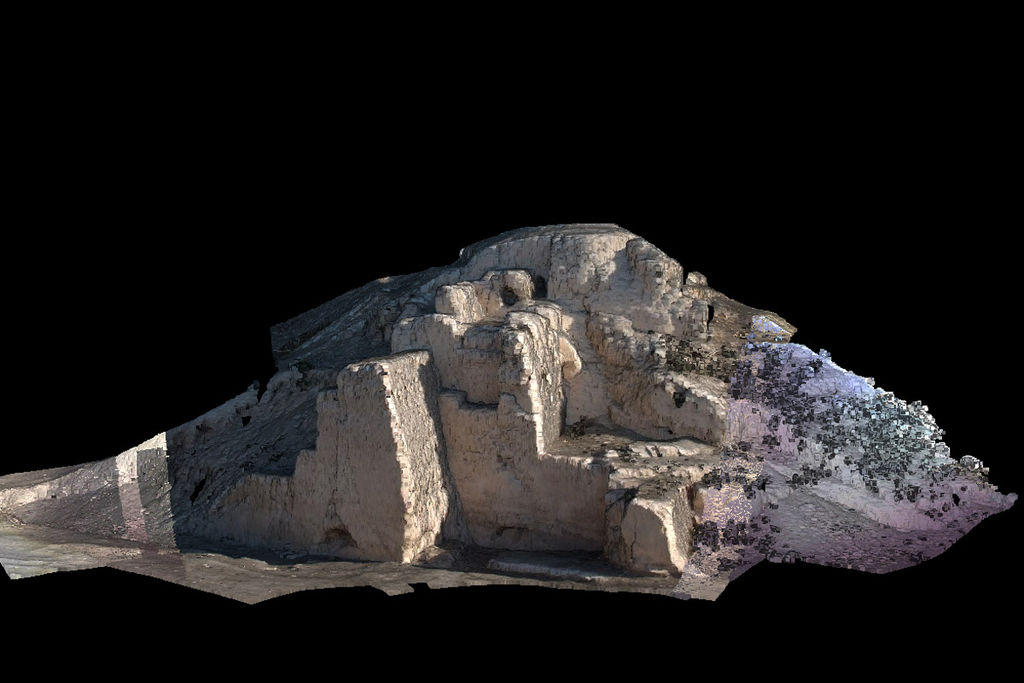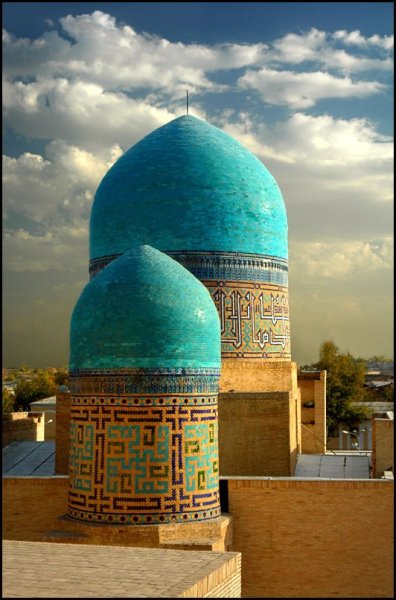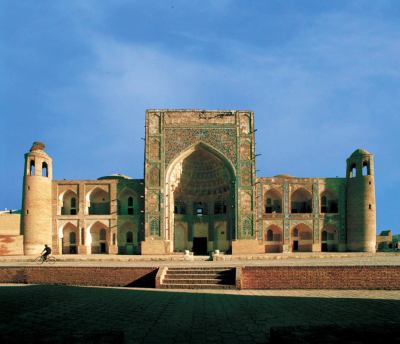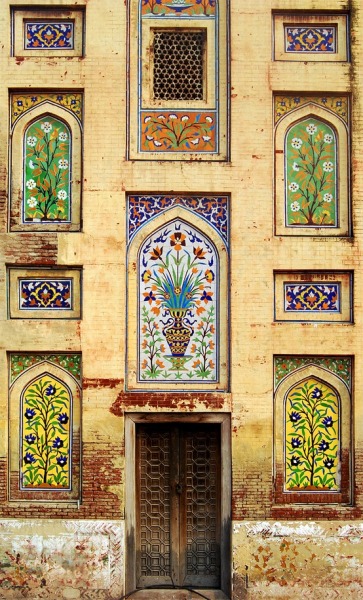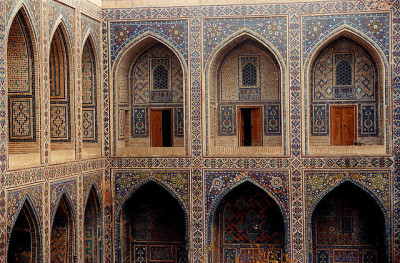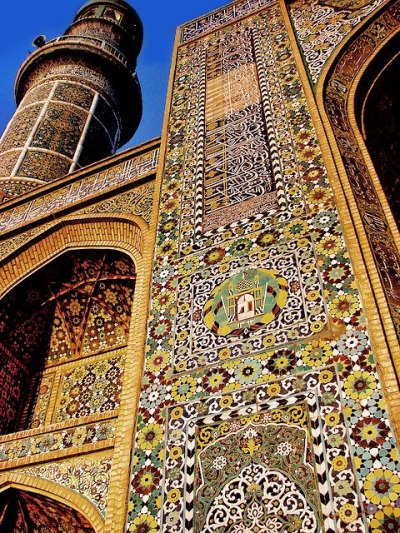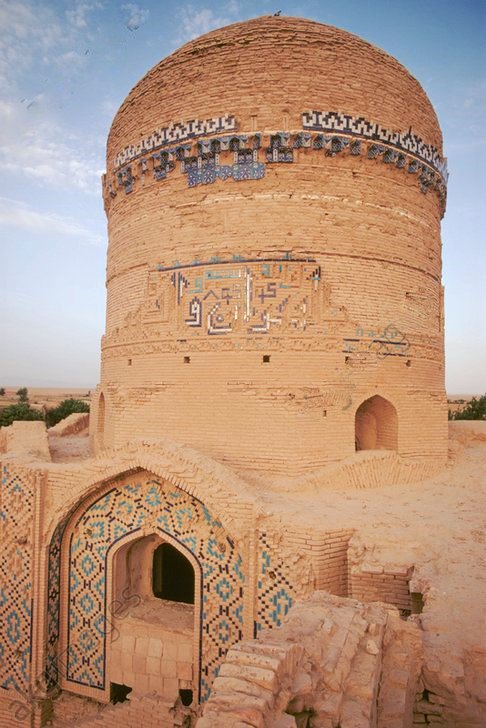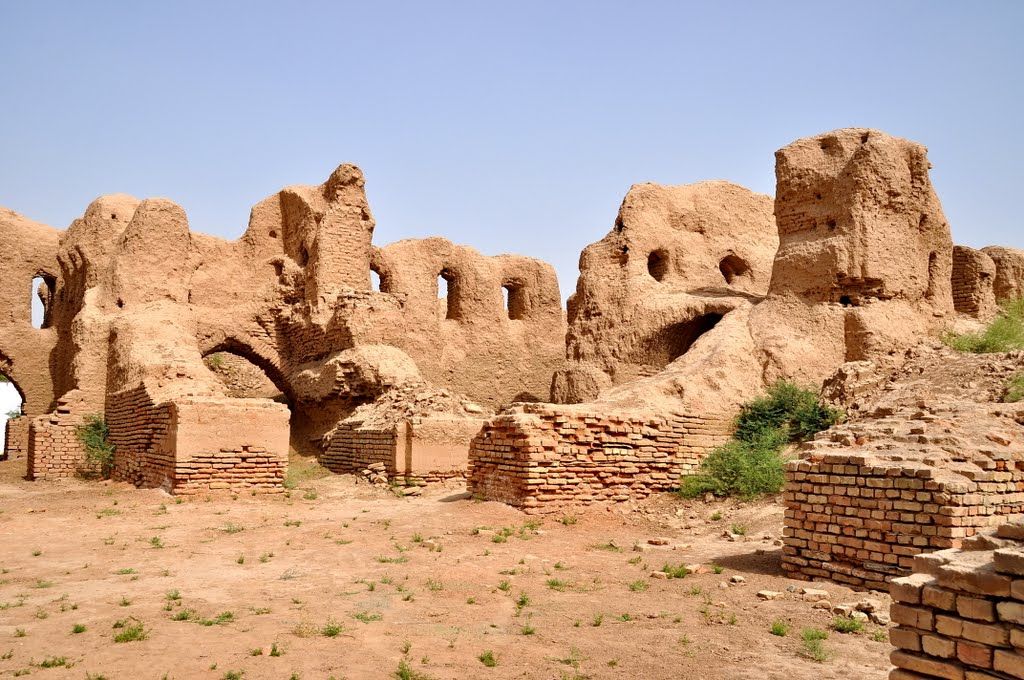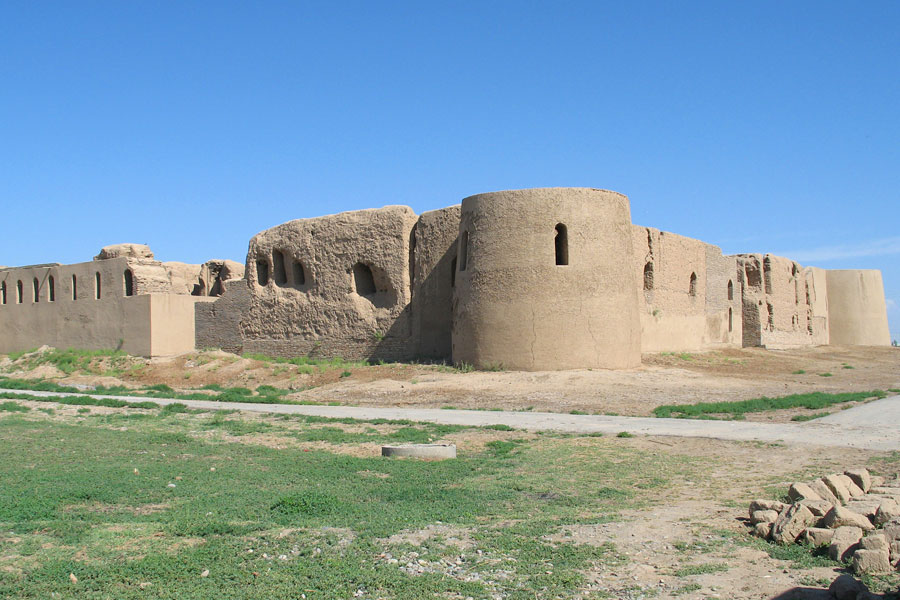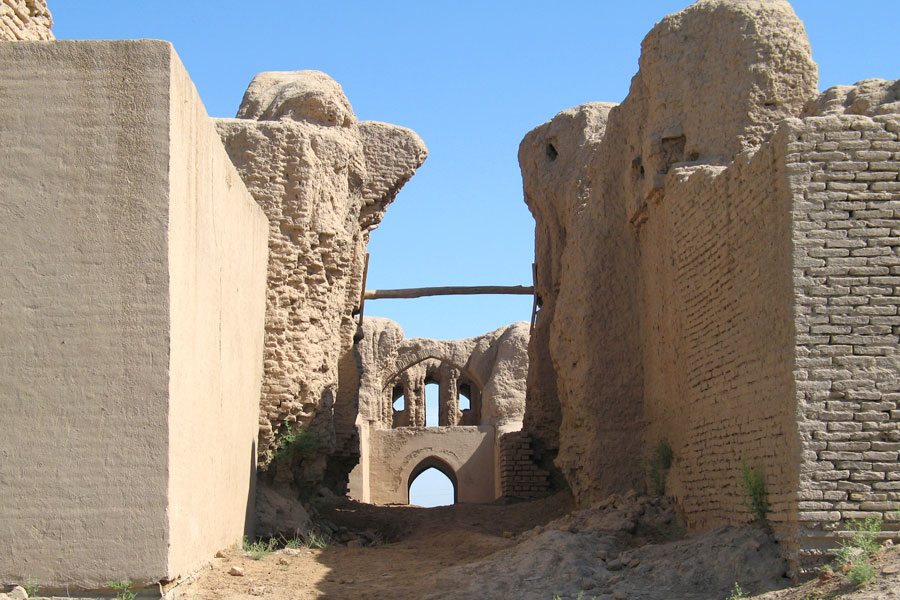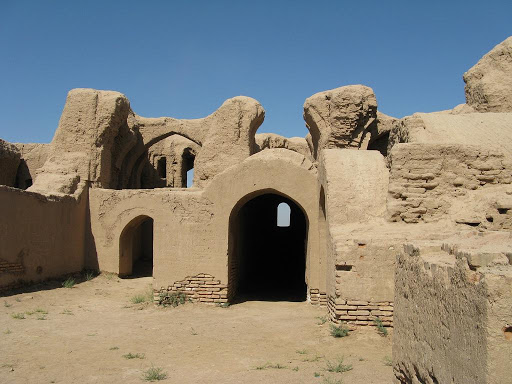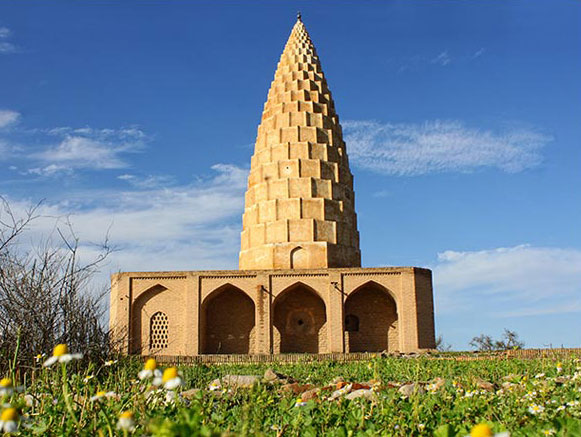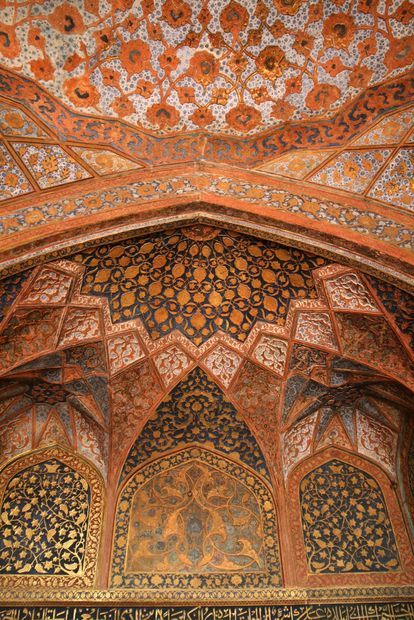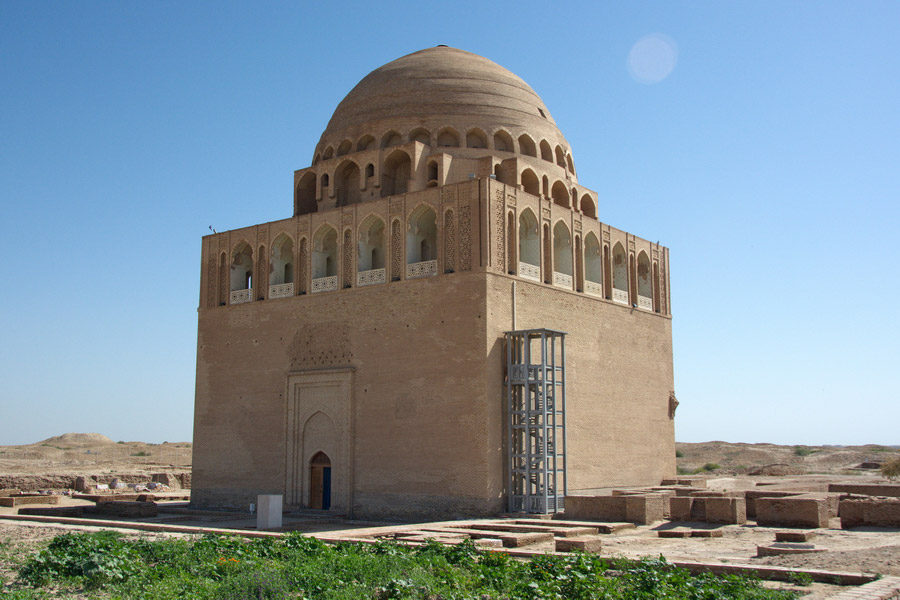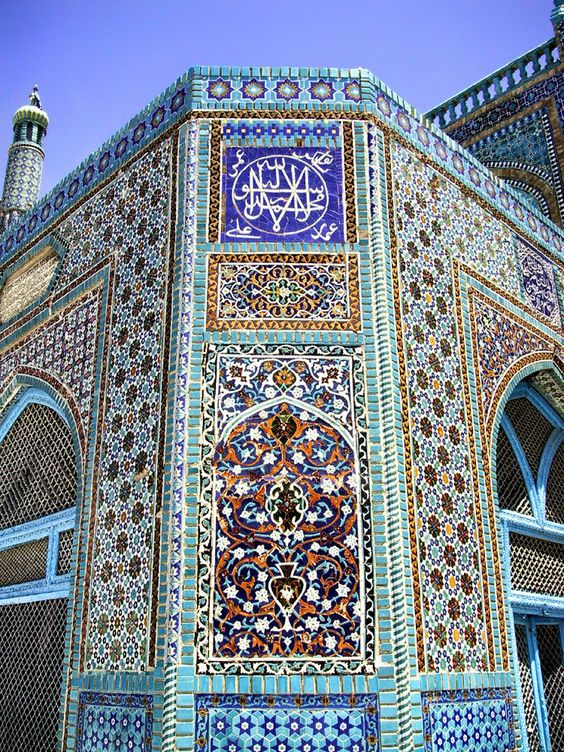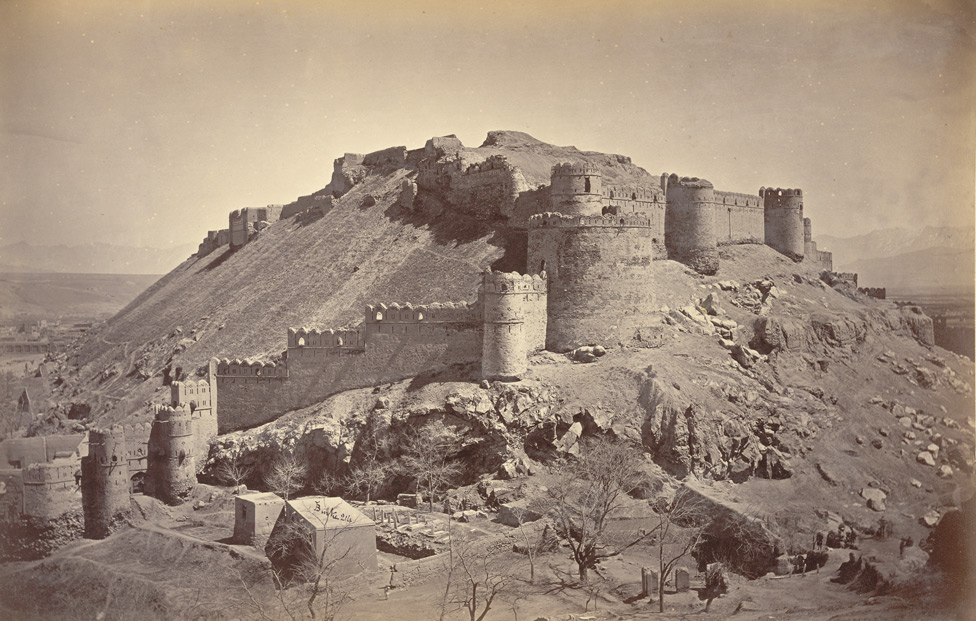Going to start a thread about architecture in Khorasan and Khwarezm and also its offshoot, India:
The Tilla Kari madrasa was commissioned a decade after the adjacent Shir Dar madrasa (1619-1636) by the same patron, Shaybanid feudal general, Alchin Yalantush Bahadur (1646-60).
The Tilla Kari madrasa was commissioned a decade after the adjacent Shir Dar madrasa (1619-1636) by the same patron, Shaybanid feudal general, Alchin Yalantush Bahadur (1646-60).
The Great Mosque of Herat was built by the Ghurids, under the rule of the Sultan Ghiyath al-Din Muhammad Ghori, in 1200 CE, and later extended by several rulers such as the Timurids, the Safavids, the Uzbeks, etc all of whom supported the mosque.
TM was commissioned by Shah Jahan in 1631, to be built in the memory of his wife Mumtaz Mahal, a Persian princess who died that year. It incorporates and expands on design traditions of Persian architecture. Specific inspiration came from successful Timurid and Mughal buildings.
Taj Mahal construction was led by two Persian architectures: Ustad Ahmad Lahori from Badakhshan and Ustad Isa from Shiraz. The Taj Mahal was designated as a UNESCO World Heritage Site in 1983 for being "the jewel of Muslim art in India and one of the universally...
admired masterpieces of the world& #39;s heritage". It is regarded by many as the best example of Mughal architecture and a symbol of India& #39;s rich history. The Taj Mahal attracts 7–8 million visitors a year.
The Qutb complex are monuments and buildings from the Delhi Sultanate at Mehrauli in Delhi in India. The Qutub Minar "victory tower" in the complex, named after the religious figure Sufi Sant Khwaja Qutbuddin Bakhtiar Kaki, was begun by Qutb-ud-din Aibak, who...
later became the first Sultan of Delhi of the Mamluk dynasty( Gulam Vansh). Construction was continued by his successor Iltutmish (a.k.a. Altamash), and finally completed much later by Firoz Shah Tughlaq.
Many subsequent rulers, including the Tughlaqs, Alauddin Khalji and the British added structures to the complex. Apart from the Qutb Minar and the Quwwat ul-Islam Mosque, other structures in the complex include the Alai Darwaza gate, the Alai Minar and the Iron pillar.
The Qutb Minar complex, which drew 3.9 million visitors in 2006, was India& #39;s most visited monument that year, ahead of Taj Mahal.
Chahar Bagh (Persian: چهارباغ, meaning "four gardens") is a Persian quadrilateral garden layout based on the four gardens of Paradise mentioned in the Qur& #39;an. The quadrilateral garden is divided by walkways or flowing water into four smaller parts.
Pic of Bagh-e Babur in Kabul.
Pic of Bagh-e Babur in Kabul.
And for him, who fears to stand before his Lord, are two gardens. (Chapter 55: Verse 46)
And beside them are two other gardens. (Chapter 55: Verse 62)
And beside them are two other gardens. (Chapter 55: Verse 62)
Four central axial water courses define the char bagh& #39;s quadrilateral layout at Humayun& #39;s Tomb, Delhi, India (1572).
Naghsh-i Jahan square, the charbagh Royal Square (Maidan) in Isfahan, constructed between 1598 and 1629.
The "Khorasani style" (Persian: شیوه معماری خراسانی) is a style of architecture appearing after the Muslim conquest of Iran, but is highly influenced by pre-Islamic designs. Landmarks of this style appear in the late 7th century, and span through the end of the 10th century CE.
The Khorasani architecture appeared in the eastern province of Khorasan.
Picture shows Nain´s Friday Mosque, built in the 9th century following the Khorasani style. Its one of the oldest mosques in Iran.
Picture shows Nain´s Friday Mosque, built in the 9th century following the Khorasani style. Its one of the oldest mosques in Iran.
The paradise garden is a form of garden of Old Iranian origin, specifically Achaemenid. Originally denominated by a single noun denoting "a walled-in compound or garden", from "pairi" ("around") and "daeza" or "diz" ("wall", "brick", or "shape"), Xenophon Grecized...
the Persian phrase "pairi-daeza" into "paradeisos". The idea of the enclosed garden is often referred to as the paradise garden because of additional Indo-European connotations of "paradise".
The fundamental quality is enclosure of the cultivated area, which excludes the wildness of nature and includes cultivated and irrigated greenery, providing privacy and security. Another common quality is the elaborate use of water, often in canals, ponds, or rills.
Many of the Islamic horticultural traditions and later European traditions derive from that of the paradise garden. Examples of its derivations are present in many of the historic gardens of Islamic and European nations. The Persian garden gave rise to the Mughal gardens of India
The Hiran Minar complex in Sheikhupura, Pakistan embodies the Mughal relationship between humans, pets, and hunting.
The Gardens of Shalimar are divided into three distinct terraces. The area in red is the uppermost terrace, and was reserved for the Queen´s harem, while the area in blue was reserved for the King. The area in green is the lowest terrace, and was occasionally open to the public.
Restoration of "Rambu House" ("Seh Dokan") in old city of Kabul. 2007 by Foundation Aga Khan.
"Seh Dokan" is one of the finest homes in the "Asheqan wa Arefan" quarter of Kabul’s old city and one of a few remaining homes that retain timber patai screens.
"Seh Dokan" is one of the finest homes in the "Asheqan wa Arefan" quarter of Kabul’s old city and one of a few remaining homes that retain timber patai screens.
The ancient Palace of Ardashir, constructed in 224 during the Sassanid Dynasty. The building has three large domes, among the oldest examples of such large-scale domes in the World.
The "Razi style" is a style of architecture when categorizing Iranian architecture development in history. The Dictionary of Traditional Iranian Architecture defines the Razi Style as:
"A style of architecture dating from the 11th century to the Mongol invasion period,...
"A style of architecture dating from the 11th century to the Mongol invasion period,...
which includes the methods and devices of the Samanids, Ghaznavids, and Seljukids"
The Razi style emerged during the Iranian Intermezzo in Khorasan.
The Razi style emerged during the Iranian Intermezzo in Khorasan.
Masjid-e Magok-e Attari ("Attari Tomb Mosque") in Bukhara, modern Uzbekistan. Its the oldest mosque in Uzbekistan and one of the oldest in Central Asia.
At the top of a portal in Sharesabz ("Green City" in Persian), in modern Uzbekistan, there is an incomplete but still decipherable mantra of the Timurids that reads:
"Let he who doubts our power and munificence, look upon our buildings."
"Let he who doubts our power and munificence, look upon our buildings."
Development of the pre-Mongol Khwarezmian city of Gurganj.
"Seven times destroyed and seven times rebuilt" is the legend attached to this city, capital of the Khwaremshah Empire.
"Seven times destroyed and seven times rebuilt" is the legend attached to this city, capital of the Khwaremshah Empire.
Mausoleum of Khwaja Maudood Chisti ("Ziarat e Dargah Khwaja Maudood Chishti") in Chisti Sharif, Herat (Afghanistan).
Two historic domes ("gumbads") built by Ghiyath al-Din Muhammad of the Ghurid Dynasty in Herat, Afghanistan.
The Razi style is a type of architecture (from the 11th century to the Mongol invasion period) which includes the methods and devices of the following periods:
-Samanid period, e.g. Samanid Mausoleum.
-Ziyarid period, e.g. Gonbad-e Qabus.
-Seljukid period, e.g. Kharraqan towers.
-Samanid period, e.g. Samanid Mausoleum.
-Ziyarid period, e.g. Gonbad-e Qabus.
-Seljukid period, e.g. Kharraqan towers.
Razi style emerged in Khorasan. The Dictionary of Traditional Iranian Architecture defines the Razi Style as:
"A style of architecture dating from the 11th century to the Mongol invasion period, which includes the methods and devices of The Samanids, Ghaznavids, and Seljukids."
"A style of architecture dating from the 11th century to the Mongol invasion period, which includes the methods and devices of The Samanids, Ghaznavids, and Seljukids."
Satellite image of ancient and modern Balkh cities, in Afghanistan. Base image courtesy Google Earth.
Imagen satélite de la antigua y moderna ciudad de Balkh, en Afganistán. Cortesía de Google Earth.
Imagen satélite de la antigua y moderna ciudad de Balkh, en Afganistán. Cortesía de Google Earth.
Bukhara? Herat? Samarkand? Neyshabur? No, Bidar in India. The Madrassah of Mahmud Gawan, built following the Khorasani Timurid architecture.
Gawan, a Persian vizir at the Bahmani court, wanted to attract the brightest people from the Persianate world to this place.
Gawan, a Persian vizir at the Bahmani court, wanted to attract the brightest people from the Persianate world to this place.
Great Friday Mosque and the Gulbarga Fort, Gulbarga city (India).
The Mosque built later, within the fort, in 1367, is a unique structure built in Persian architectural style. It was built to commemorate the establishment of the dynastic rule of the Bahmani kingdom at Gulbarga.
The Mosque built later, within the fort, in 1367, is a unique structure built in Persian architectural style. It was built to commemorate the establishment of the dynastic rule of the Bahmani kingdom at Gulbarga.
Mihrab, Tilla-Kari Madrassa. Timurid Khorasani style.
One of the three great structures of the Registan, the Tilla-Kari (Persian "Gold Covered") Madrassa is a 17th century splendor built to highlight the region& #39;s wealth.
One of the three great structures of the Registan, the Tilla-Kari (Persian "Gold Covered") Madrassa is a 17th century splendor built to highlight the region& #39;s wealth.
The British Member of Parliament and future viceroy of India, George Curzon, saw Samarkand´s Registan during the 1880s and called it "the nobles public square in the world."
The Goharshad Mosque in Mashhad, Iran´s Khorasan Province. A grand congregational mosque built by the order of the Timurid Empress Goharshad and now part of the massive Imam Reza Complex.
Originally it was Sunni mosque but was turned into a Shia one by the Safavid Empire.
Originally it was Sunni mosque but was turned into a Shia one by the Safavid Empire.
The Goharshad Mosque was built following traditional Khorasanian/Khwarezmian patterns although the architectural and decorative manpower was supplied from Shiraz and Isfahan. For example the portal has a clear Samarkandi style. Beautiful building.
Abbasid Ivan in Atiq yard, Imam Reza complex, Mashhad. Iran. Part of the Goharshad Mosque. Timurid architecture was so beautiful and unique.
Aga Khan Historic Cities Programme
Urban Conservation and Area Development in Afghanistan
Amazing piece. So much information about historical sites in Afghanistan. Check it out!
https://www.akdn.org/sites/akdn/files/media/publications/2007_05_-_akhcp_-_afghanistan_-_urban_conservation_area_dvlpt_-_low_res.pdf">https://www.akdn.org/sites/akd...
Urban Conservation and Area Development in Afghanistan
Amazing piece. So much information about historical sites in Afghanistan. Check it out!
https://www.akdn.org/sites/akdn/files/media/publications/2007_05_-_akhcp_-_afghanistan_-_urban_conservation_area_dvlpt_-_low_res.pdf">https://www.akdn.org/sites/akd...
Keeping History Alive
Safeguarding Cultural Heritage in Post-Conflict Afghanistan
http://openarchive.icomos.org/1887/1/232932e.pdf">https://openarchive.icomos.org/1887/1/23...
Safeguarding Cultural Heritage in Post-Conflict Afghanistan
http://openarchive.icomos.org/1887/1/232932e.pdf">https://openarchive.icomos.org/1887/1/23...
Akhangan tomb, where Gawhar Shad& #39;s sister Gowhar-Taj is buried. The architecture is a fine example of the Timurid era of Khorasan. Akhangan, Khorasan province in Iran.
An example of quadrangular to circle transition. MOdern Persian architecture. The mosque of Isfahan international conference center.
Reconstructed pairi-daeza ("paradise", early Persian Gardens, "bagh" باغ) of Cyrus at Pasargard, 6th c. BC.
Sultan Sadat Necropolis:
Originally formed between the 11th and 17th centuries for the tombs of the Sayyid dynasty of Termez, it presently consists of several mausoleums around an elongated courtyard.
Originally formed between the 11th and 17th centuries for the tombs of the Sayyid dynasty of Termez, it presently consists of several mausoleums around an elongated courtyard.
“Wagner” "Chahar Bagh" Garden Carpet, Central Iran. Burrell Collection, Glasgow. Safavid Period, 17th c.
https://twitter.com/BiruniKhorasan/status/1205180552032215041">https://twitter.com/BiruniKho...
Miniature shows Babur "inspecting" one of his legendary "Chahar Bagh" gardens. Baburnama, 16th c. British Library.
Tash Rabat is a well-preserved 15th century stone caravanserai in At Bashy district, Naryn Province, Kyrgyzstan. Tash Rabat was originally built as a Nestorian monastery in the tenth century.
Villa Farnesina. Post Renaissance Garden, Rome (P. Hunt photo 2011) Garden was built as a Khorasanian "Chahar Bagh".
"Tarikhane Temple" (Persian پرستشگاه تاریخانه) is located in Damghan, northern Iran. It was originally a Zoroastrian fire temple turned into mosque in 8th century. Its Iran´s oldest mosque.
Erk Gala (Persian "The Citadel Fort") is the oldest part of the city of Merv complex. Built in the 7th century BC it was built as a Persian style fortress controlling the oasis on the Murghab River.
Did you know Kashmir´s traditional wooden architecture was originally developed by a Central Asian architecture named Sadr al-Din Khurassani?
Hellenistic city in afghanistan أي خانوم
(Ai-Khanoum) is presumed to be (Alexandria-Oxiana), founded by Alexander. https://www.youtube.com/watch?v=5tka9TFyWIw">https://www.youtube.com/watch...
(Ai-Khanoum) is presumed to be (Alexandria-Oxiana), founded by Alexander. https://www.youtube.com/watch?v=5tka9TFyWIw">https://www.youtube.com/watch...
Ai Khanum is an example of genuine, solid Hellenistic city with Greek architecture and institutions, a huge majestic structure with the characteristic central avenue, an Acropolis, Temple of Zeus, Palace, Theatre, Gymnasium dedicated to Hercules, Library, public fountains,...
statues, Greek pillars, and philosophical epigrams carved on the city& #39;s monuments, based on Delphic maxims. The city cleverly blended the local elements with the Hellenic civilization.
Courtyard at Po-i-Kalyan (Persian پای کلان Pā-i Kalān, "The Foot of the Great"), a huge Islamic complex built over several centuries by several dynasties. Originally, this was a Zoroastrian complex. It´s said that the greatness of the structures so amazed Genghis Khan, he...
mistakenly believed the mosque to be a khans& #39; palace. Nevertheless, the building of the mosque was not spared by the fire, and for many years after the conflagration it lay in ruins. All that remained intact of the original building was the minaret Kalan (Minara-yi-Kalan).
Prior to their recent destruction by the terrorist Taliban movement, the 6th-7th century, rock-cut Buddha sculptures in the Bamiyan Valley of central Afghanistan were considered the largest in the world.
Like many of the world’s great ancient monuments, little is known about who commissioned the Bamiyan Buddhas or the sculptors who carved them. However, their very existence points to the importance of the Buddhist faith and the Bamiyan Valley during this period.
Bamiyan is located between the Indian subcontinent and Central Asia, which made it an important location close to one of the most important branches of the Silk Route. Buddhism had long been an important religion in the region,having been introduced during the early Kushan period
Buddhism spread, in part, because it was not location specific. Worship could take place anywhere and at anytime. This freedom resulted in the emergence of Buddhist cave architecture throughout Asia. If one visits Bamiyan today, one will see nearly 1000 Buddhist caves.
East Buddha (detail with drapery in 1975), c. 6th-7th c C.E., stone, stucco, painted, 120 feet high, Bamiyan, Afghanistan, destroyed 2001 (photo: Pierre Le Bigot, CC BY-NC-ND 2.0)
Hassan Kharaqani´s mausoleum is located 24 kilometers outside of Shahrud (Semnan, Iran. Khorasan back then) inside a garden. The original mausoleum was a simple brick structure that was replaced by a new one in 1974.
Today, the complex includes a library, which houses reference books on mysticism, and rooms where pilgrims can stay.
Ancient Persian Art and Architecture https://www.ancient.eu/Ancient_Persian_Art_and_Architecture/">https://www.ancient.eu/Ancient_P...
The Great Mosque (or Masjid-e Jameh) of Isfahan, Iran.
Very interesting article, with nice pictures. Check it out. https://www.khanacademy.org/humanities/ap-art-history/west-and-central-asia/a/the-great-mosque-or-masjid-e-jameh-of-isfahan">https://www.khanacademy.org/humanitie...
Very interesting article, with nice pictures. Check it out. https://www.khanacademy.org/humanities/ap-art-history/west-and-central-asia/a/the-great-mosque-or-masjid-e-jameh-of-isfahan">https://www.khanacademy.org/humanitie...
Going Where Archaeologists Cannot, Spy Satellites Reveal Thousands of Forgotten Ancient Sites in Afghanistan
Very interesting stuff found by satellite in Afghanistan from the Parthian, Kushan and Medieval times. Check it out! https://www.ancient-origins.net/news-history-archaeology/going-where-archaeologists-cannot-spy-satellites-reveal-thousands-forgotten-021763">https://www.ancient-origins.net/news-hist...
Very interesting stuff found by satellite in Afghanistan from the Parthian, Kushan and Medieval times. Check it out! https://www.ancient-origins.net/news-history-archaeology/going-where-archaeologists-cannot-spy-satellites-reveal-thousands-forgotten-021763">https://www.ancient-origins.net/news-hist...
Aerial view of Gonor-Tepe, in northern Afghanistan. An important urban area part of the complex network of cities built along the Oxus/Amu Darya river. Part of the Bactrian Margiana Archeological Complex (BMAC civilization). 1700BC
Creating a digital geospatial inventory of sites across Central Asia. https://twitter.com/UZAmbassador/status/1223921654369345537">https://twitter.com/UZAmbassa...
The sad story of the Musalla Complex: art crime and destruction https://squarekufic.com/2017/11/16/musalla-complex-herat/">https://squarekufic.com/2017/11/1...
Afghanistan began building a massive administrative complex, inspired in classical Khorasanian architecture (mostly Timurid, Ghorid and Ghaznavid). https://twitter.com/BiruniKhorasan/status/1150546971268124672">https://twitter.com/BiruniKho...
Building the Great Mosque of Samarkand. Illustration by Kemal Behzad for the Zafar-Nameh. Text copied in Herat in 1467–68 and illuminated c. the late 1480s. John Work Garret Collection, Milton S. Eisenhower Library, Johns Hopkins University, Baltimore. Fols. 359v-36or.
The new Great Mosque of Dushanbe, Tajikistan. https://twitter.com/BiruniKhorasan/status/1158488695600795649">https://twitter.com/BiruniKho...
An iwan (Persian: ایوان) is a rectangular hall or space, usually vaulted, walled on three sides, with one end entirely open. The gateway to the iwan is called pishtaq, a Persian term for a portal projecting from the facade of a building, usually decorated with calligraphy...
bands, glazed tilework, and geometric designs. Iwans are most commonly associated with Islamic architecture; however, the form is Iranian in origin and was invented much earlier and fully developed in Mesopotamia around the third century CE, during the Parthian period of Iran.
Pictures shows Masjid-i Sayyid in Isfahan and Mir-i-Arab madrasa, Bukhara and their iwans.
Our architecture is definitely one of the most beautiful and sophisticated in history.
Our architecture is definitely one of the most beautiful and sophisticated in history.
https://twitter.com/BiruniKhorasan/status/1171731305450672129">https://twitter.com/BiruniKho...
Shah-i-Zinda (Persian: شاه زنده, meaning "The Living King"), a necropolis in the north-eastern part of Samarkand.
The Shah-i-Zinda complex was formed over eight (from 11th till 19th) centuries and now includes more than twenty buildings.
The Shah-i-Zinda complex was formed over eight (from 11th till 19th) centuries and now includes more than twenty buildings.
A Deccan story: Mahmud Gawan
Very cool story about the Persian Vizir of Gilan Mahmud Gawan who ran the Tajik Bahmanid Empire in India.
https://timesofindia.indiatimes.com/blogs/HiddenHeritage/a-deccan-story-mahmud-gawan/">https://timesofindia.indiatimes.com/blogs/Hid...
Very cool story about the Persian Vizir of Gilan Mahmud Gawan who ran the Tajik Bahmanid Empire in India.
https://timesofindia.indiatimes.com/blogs/HiddenHeritage/a-deccan-story-mahmud-gawan/">https://timesofindia.indiatimes.com/blogs/Hid...
A "liwan" (from Persian "eyvān") a long narrow-fronted hall or vaulted portal that is often open to the outside. It is mostly found in Levantine houses.
Liwan of the Mosque of Almonaster (Huelva, Spain) and an architectural drawing of a typical Levantine house.
Liwan of the Mosque of Almonaster (Huelva, Spain) and an architectural drawing of a typical Levantine house.
The entrance to the Mosque of the Cloak of the Prophet in Herat, Afghanistan.
Built during the monarchy of King Zahir Shah (1933-1973).
Built during the monarchy of King Zahir Shah (1933-1973).
A large and impressive pair of French enamelled & #39;Persian-style& #39; leaded-glass double-doors signed by J.P.Imberton. Paris, France. Dated 1886.
The minaret of Bahram Shah is one of two monumental towers at Ghazni. It is located in a ruin field that also contains a number of Ghaznavid tombs and palaces. An inscription on the minaret states that Bahram Shah, a Ghaznivid ruler who reigned from 1117-1153/511-547 AH.
"Kök Gumbaz" madrasa complex, commissioned by the Timurid ruler Sulan Abdul-Latif. Mid-fifteenth century. Istaravshon, modern Tajikistan.
Maquette of the Registan Square, which is located in the center of Samarkand city, at UN headquarters in New York.
The Ghorid Portal and some of the design inside the Portal that was uncovered at the Great Mosque of Herat, Afghanistan.
Ghorid´s architecture was quite impressive.
Ghorid´s architecture was quite impressive.
How war and greed decimated vernacular architecture in Afghanistan
http://colabradio.mit.edu/how-war-and-greed-decimated-vernacular-architecture-in-afghanistan/">https://colabradio.mit.edu/how-war-a...
http://colabradio.mit.edu/how-war-and-greed-decimated-vernacular-architecture-in-afghanistan/">https://colabradio.mit.edu/how-war-a...
A large and impressive Ilkhanid lustre mihrab tile. Iran, 13th/14th century.
Following the devastating invasion of the Mongol hordes in the 1220s, the ceramic industry in the Persianate world declined momentarily, only to be revived soon by a fresh approach.
Following the devastating invasion of the Mongol hordes in the 1220s, the ceramic industry in the Persianate world declined momentarily, only to be revived soon by a fresh approach.
Ghazni: the City of Diverse Islamic Architecture https://en.shafaqna.com/67489/ghazni-the-city-of-diverse-islamic-architecture/">https://en.shafaqna.com/67489/gha...
The city of Baghdad between 150 and 300 AD. Notice the circular form of the city. Baghdad was founded following a tradition pre-Islamic Iranian urban model.
Nishabur´s Friday Mosque. Khorasan province, Iran.
The mosque was founded by Pahlavan Ali Karkhi in 1493 during the rule of Husayn Bayqarah of the Timurid dynasty.
The mosque was founded by Pahlavan Ali Karkhi in 1493 during the rule of Husayn Bayqarah of the Timurid dynasty.
Map of Seleucia-Ctesiphon in the Sassanid era.
Ctesiphon, 35 kilometres southeast of modern Baghdad, was founded by Parthians in 120 AD. Ctesiphon measured 30 square kilometers, more than twice the surface of 13.7-square-kilometer fourth-century imperial Rome.
Ctesiphon, 35 kilometres southeast of modern Baghdad, was founded by Parthians in 120 AD. Ctesiphon measured 30 square kilometers, more than twice the surface of 13.7-square-kilometer fourth-century imperial Rome.
Mausoleum of Hamdollah Mostowfi, a 13th century Persian historian, geographer and epic poet. Qazvin, Iran.
Herat’s Historical Sites Need Renovation: Officials
This article is from November 2019 but I recommend it because there are pictures of amazing archeological sites in Herat´s rural areas. Check it out. https://tolonews.com/arts-culture/herat%E2%80%99s-historical-sites-need-renovation-officials">https://tolonews.com/arts-cult...
This article is from November 2019 but I recommend it because there are pictures of amazing archeological sites in Herat´s rural areas. Check it out. https://tolonews.com/arts-culture/herat%E2%80%99s-historical-sites-need-renovation-officials">https://tolonews.com/arts-cult...
An album of architectural and floral studies. India, Agra, Company School, mid-19th century.
Written in English, it is most likely one of the first Brit-Mughal cultural works in history. 29 leaves, comprising 27 architectural and floral studies plus 3 photographs.
Written in English, it is most likely one of the first Brit-Mughal cultural works in history. 29 leaves, comprising 27 architectural and floral studies plus 3 photographs.
A Safavid caravanserai plan.
"Caravanserai" comes from the Persian word kārvānsarāy (کاروانسرای), which combines kārvān ("caravan") with sarāy ("palace", "home"). A caravanserai was a roadside inn where travelers (caravaners) could rest and recover from the day& #39;s journey.
"Caravanserai" comes from the Persian word kārvānsarāy (کاروانسرای), which combines kārvān ("caravan") with sarāy ("palace", "home"). A caravanserai was a roadside inn where travelers (caravaners) could rest and recover from the day& #39;s journey.
"The people of Bukhara are distinguished by all others of Khurasan for their culture, their religious sciences, their knowledge in the juridical field, their devotion, their faithfulness, their sober habits, the perfection of their social relationships, the absence of mean...
intentions, the propensity to good, their zeal for positive actions and the purity and openess of their feelings"
-Ibn Hawqal, an Arab geographer and historian from northern Mesopotamia.
-Ibn Hawqal, an Arab geographer and historian from northern Mesopotamia.
He goes one:
"I have not seen nor heard in the Islamic territory about a region more beautiful than Bukhara. From the heights of its citadel anywhere the sight is worth the looking, and there is a great extension of vegetation which is mixed with the blue of the...
"I have not seen nor heard in the Islamic territory about a region more beautiful than Bukhara. From the heights of its citadel anywhere the sight is worth the looking, and there is a great extension of vegetation which is mixed with the blue of the...
sky as if the firmament was blue cover above a green carpet"
Ibn Hawqal visited Samanid Samarkand too. This is what he said:
"From the top of the citadel, where i have been, one can enjoy the best show ever imagined or dreamt about: green trees, resplendent castles, fast-flowing small rivers and wonderful cultivations. There is no point..
"From the top of the citadel, where i have been, one can enjoy the best show ever imagined or dreamt about: green trees, resplendent castles, fast-flowing small rivers and wonderful cultivations. There is no point..
at which the eye is not satisfied, there is no garden where beauty is not evident: the whole is divided by well-designed buildings and the splendour is infinite. The cypresses have been cut in order to look...
like animals such as elephants, camels, oxen, confronting beasts as if they were talking to each other or fighting"
Tomb of Hasan Ghaznavi in Azadvar, Khorasan province of Iran.
Hasan Ghaznavi was a popular poet under the Ghaznavi dynasty. His divan contains 83 ghazals. He died in 1160 AD. His tomb needs serious repair.
Hasan Ghaznavi was a popular poet under the Ghaznavi dynasty. His divan contains 83 ghazals. He died in 1160 AD. His tomb needs serious repair.
Malik cistern in Herat, the oldest one in Afghanistan. It date back to 1200 (most likely built by the Ghorid Dynasty).
The Blue Mosque of Mazar-e Sharif, Afghanistan.
Originally built during the Seljuq Dynasty, it was expanded by diverse dynasties. It took its current form under the Timurids. One of Afg´s most iconic architectural buildings. Pure Khorasani style. https://www.youtube.com/watch?v=l_rpqV82gO0">https://www.youtube.com/watch...
Originally built during the Seljuq Dynasty, it was expanded by diverse dynasties. It took its current form under the Timurids. One of Afg´s most iconic architectural buildings. Pure Khorasani style. https://www.youtube.com/watch?v=l_rpqV82gO0">https://www.youtube.com/watch...
Inside Imam Termidhi´s shrine, in the city of Termez.
Imam Termidhi was one of the greatest Islamic scholar and one of the main compilers of the sayings of the Prophet (hadith). Like most of the classical Islamic scholars, he was an ethnic Tajik from Khorasan.
Imam Termidhi was one of the greatest Islamic scholar and one of the main compilers of the sayings of the Prophet (hadith). Like most of the classical Islamic scholars, he was an ethnic Tajik from Khorasan.
The "Green Mosque of Balkh" (Persian: "Masjid-e Sabz Balkh"), built most likely at the Timurid´s king Shahrukh and his wife Gowarshad in 1421 AD.
Beautiful video. Check it out! https://www.youtube.com/watch?v=I_PVMAIFspM">https://www.youtube.com/watch...
Beautiful video. Check it out! https://www.youtube.com/watch?v=I_PVMAIFspM">https://www.youtube.com/watch...
The name of Turkmenistan´s capital, Ashgabat, comes from the Persian word Ešq-ābād (عشقآباد), which literally means "city of love".
Short thread about Iran´s mosques/palaces domes. https://twitter.com/BiruniKhorasan/status/1247837094694850561">https://twitter.com/BiruniKho...
Restoration of Chahar Suq, one of the biggest water cisterns in Asia. Herat, Afghanistan. https://archnet.org/sites/6411 ">https://archnet.org/sites/641...
Interior of Ismael Samani´s mausoleum, Bukhara.
The mausoleum is considered to be one of the most highly esteemed work of Khorasani architecture, and was built between 892 and 943 CE.
Ismael Samani is the rightful father of the Tajik nation.
The mausoleum is considered to be one of the most highly esteemed work of Khorasani architecture, and was built between 892 and 943 CE.
Ismael Samani is the rightful father of the Tajik nation.
Shah Yousuf Gardezi Tomb (built c. 1152, rebuilt 1548), located about 600 meters southwest of the former fort of Multan, modern Pakistan.
Architecture is clearly Khorasanian.
Architecture is clearly Khorasanian.
Sultan Muhammad Ghori´s tomb in Punjab province, Pakistan. Beautiful place.
Muhammad Ghori and his brother Ghiyath founded the Tajik Ghorid empire. Though the Ghorid dynasty was short-lived laid the foundations of almost 800 years of Muslim/Persianate rule in India.
Muhammad Ghori and his brother Ghiyath founded the Tajik Ghorid empire. Though the Ghorid dynasty was short-lived laid the foundations of almost 800 years of Muslim/Persianate rule in India.
The Citadel of Farah, also known as "Qala-e Fereidoon", is a huge fortress located outside the city of Farah (Western AFG). It was built 2500 years ago by the Achaemenid Empire. Some Westerners claim it was built by Alexander the Great but there is no consensus on who built it.
Khujand´s (Tajikistan) Friday Mosque.
Can anyone give me some information about this mosque? Who built it and when?
Can anyone give me some information about this mosque? Who built it and when?
https://twitter.com/BiruniKhorasan/status/1250104520488693760">https://twitter.com/BiruniKho...
Satellite image of the Minarete of Jam built by the Ghorids in 1190 AD.
The minarets are thought to have been built as symbols of Islam& #39;s victory and might in the Indian Subcontinent.
The minarets are thought to have been built as symbols of Islam& #39;s victory and might in the Indian Subcontinent.
The 60 meter tall Kutlug Timur minaret in Urgench. Built in 1011 during the Khwarazmian dynasty.
Around 60 minarets and towers built between the 11th and the 13th centuries in Central Asia.
Around 60 minarets and towers built between the 11th and the 13th centuries in Central Asia.
The Burana Tower is a large minaret in the Chuy Valley in northern Kyrgyzstan. Is all that remains of the ancient city of Balasagun, which was established by the Karakhanids at the end of the 10th century. https://twitter.com/BiruniKhorasan/status/1189874320979513344">https://twitter.com/BiruniKho...
Gol Gumbaz at Bijapur is the mausoleum of king Muhammad Adil Shah, Adil Shah Dynasty. Construction of the tomb was started in 1626 and completed in 1656.
"Gol Gumbaz´s" means in Persian circular dome.
"Gol Gumbaz´s" means in Persian circular dome.
Mithradatkert (fortress of Mithradates) in Nisa, modern Turkmenistan.
Nisa was one of the most important Parthian cities. It was most likely destroyed by an earthquake.
Nisa was one of the most important Parthian cities. It was most likely destroyed by an earthquake.
Herat´s Citadel: https://twitter.com/BiruniKhorasan/status/1254005743826751489">https://twitter.com/BiruniKho...
Turquoise Mountain: Artists Transforming Afghanistan
Very interesting video about the reconstruction of Murad Khani in old Kabul. https://www.youtube.com/watch?v=rylQ3_5mCvw">https://www.youtube.com/watch...
Very interesting video about the reconstruction of Murad Khani in old Kabul. https://www.youtube.com/watch?v=rylQ3_5mCvw">https://www.youtube.com/watch...
Persepolis Reconstruction - LACMA
Interesting video on Persepolis digital reconstruction. https://www.youtube.com/watch?v=SHdhShb1dRc">https://www.youtube.com/watch...
Interesting video on Persepolis digital reconstruction. https://www.youtube.com/watch?v=SHdhShb1dRc">https://www.youtube.com/watch...
Floral & geometric patterns of restored tile mosaics decorate a wall in the courtyard of the Friday Mosque in Herat. Much of the Ghorid and Timurid decorations on the mosque had been badly damaged during the centuries, but a restoration project begun in 1943 continues today.
Kabul Urban Design Framework https://vimeo.com/272639011/a5483af028">https://vimeo.com/272639011...
Sheikh Ahmad Jami´s Tomb: https://twitter.com/BiruniKhorasan/status/1156843869268598784">https://twitter.com/BiruniKho...
A lustre pottery tile fragment from Khorasan (I ignore the exact place so if someone knows, let me know!), 13th/14th century.
View over the mausoleums and domes of the historical cemetery of Shahi Zinda (Persian "The Living King") through an arched gate, Samarkand.
Simulated images of Kabul´s new archeological museum that is going to be build by a Spanish firm (AV 62 Arquitectos). It will follow traditional Khorasanian styles, including the intended use of local materials and artisans.
https://twitter.com/BiruniKhorasan/status/1258331029334642688">https://twitter.com/BiruniKho...
A Ghaznavid moulded turuoise glazed pottery tile. Khorasan, 11th/12th century.
The inscription around the side is difficult to read. It does include the word "ghafar" ("May God forgive") which makes it probable that this tile was intended as a tombstone.
The inscription around the side is difficult to read. It does include the word "ghafar" ("May God forgive") which makes it probable that this tile was intended as a tombstone.
https://twitter.com/BiruniKhorasan/status/1258696435920441344">https://twitter.com/BiruniKho...
Digital reconstruction of Mes Aynak, a massive complex with over 400 Buddha statues, stupas and a 40 ha monastery built by the Kushans in Kabulistan, although it seems it was built upon a previous religious site.
Mes Aynak was destroyed by the Ghaznavids in the 11th century.
Mes Aynak was destroyed by the Ghaznavids in the 11th century.
https://twitter.com/BiruniKhorasan/status/1261996252230713345">https://twitter.com/BiruniKho...
https://twitter.com/BiruniKhorasan/status/1265596216974467072">https://twitter.com/BiruniKho...
https://twitter.com/BiruniKhorasan/status/1266299661465182208">https://twitter.com/BiruniKho...
https://twitter.com/BiruniKhorasan/status/1266404028377939968">https://twitter.com/BiruniKho...
Picture of Shahr-e Gholghola ( #Persian "City of Screams") a 13th century city in #Bamyan which was conquered by #GengisKhan Legend says when you pass by you can still hear the screams of those slaughtered by the #Mongols
Picture by Iqbal Ahmad Oruzgani. #Khorasan
Picture by Iqbal Ahmad Oruzgani. #Khorasan
https://twitter.com/BiruniKhorasan/status/1269631973334663168">https://twitter.com/BiruniKho...
https://twitter.com/BiruniKhorasan/status/1270441796473102336">https://twitter.com/BiruniKho...
https://twitter.com/BiruniKhorasan/status/1270797978194845704">https://twitter.com/BiruniKho...
#Bamyan Provincial Hospital was built following #traditional #CentralAsian architecture. This is the courtyard ( #Persian "sarai"), one of the most classic spaces in any #traditional home.
https://twitter.com/BiruniKhorasan/status/1271498229243412481">https://twitter.com/BiruniKho...
https://twitter.com/BiruniKhorasan/status/1271502322666024966">https://twitter.com/BiruniKho...
https://twitter.com/BiruniKhorasan/status/1271884332769124358">https://twitter.com/BiruniKho...
https://twitter.com/BiruniKhorasan/status/1272067664165457922">https://twitter.com/BiruniKho...
https://twitter.com/BiruniKhorasan/status/1272580238141280257">https://twitter.com/BiruniKho...
https://twitter.com/BiruniKhorasan/status/1273550468329996289">https://twitter.com/BiruniKho...
https://twitter.com/BiruniKhorasan/status/1273653955302744070">https://twitter.com/BiruniKho...
https://twitter.com/BiruniKhorasan/status/1272896350221459461">https://twitter.com/BiruniKho...
https://twitter.com/BiruniKhorasan/status/1275864981792227328">https://twitter.com/BiruniKho...
https://twitter.com/BiruniKhorasan/status/1276844233287139329">https://twitter.com/BiruniKho...
https://twitter.com/BiruniKhorasan/status/1277891796580937729">https://twitter.com/BiruniKho...
#Shrine of the #Timurid #princess "Tomân Agha" in #Herat #Khorasan Most likely built in the 15th century.
Kyrk Kiz fortress in #Termez Country residence of the ruling #Samanid dynasty in about 900 AD.
#Khorasan
#Khorasan
https://twitter.com/BiruniKhorasan/status/1278393668618117120">https://twitter.com/BiruniKho...
https://twitter.com/BiruniKhorasan/status/1279370137062330368">https://twitter.com/BiruniKho...
https://twitter.com/BiruniKhorasan/status/1279845766861934592">https://twitter.com/BiruniKho...
https://twitter.com/BiruniKhorasan/status/1276199757212459008">https://twitter.com/BiruniKho...
Tomb of Yaqub Leith, the great Saffarid Shah, located in Shah Abad Village in #Khuzestan #Iran. Beside this tomb, there are remains of #Gundeshapur City. There is a vast #graveyard around the #monument in which there are old tombstones indicating the old #history of the monument.
https://twitter.com/BiruniKhorasan/status/1280809456000000000">https://twitter.com/BiruniKho...
https://twitter.com/BiruniKhorasan/status/1280575801948241921">https://twitter.com/BiruniKho...
Ancient Citadel in Kabul Being Restored
Includes a video in Farsi. https://tolonews.com/arts-culture/ancient-citadel-kabul-being-restored">https://tolonews.com/arts-cult...
Includes a video in Farsi. https://tolonews.com/arts-culture/ancient-citadel-kabul-being-restored">https://tolonews.com/arts-cult...
https://twitter.com/BiruniKhorasan/status/1281711779069009920">https://twitter.com/BiruniKho...
https://twitter.com/BiruniKhorasan/status/1281290983460810753">https://twitter.com/BiruniKho...
https://twitter.com/BiruniKhorasan/status/1282002296994500608">https://twitter.com/BiruniKho...
https://twitter.com/BiruniKhorasan/status/1282345529209430016">https://twitter.com/BiruniKho...
https://twitter.com/BiruniKhorasan/status/1281995738206150658">https://twitter.com/BiruniKho...
https://twitter.com/BiruniKhorasan/status/1281901310149824512">https://twitter.com/BiruniKho...
https://twitter.com/BiruniKhorasan/status/1282611438448791554">https://twitter.com/BiruniKho...
https://twitter.com/BiruniKhorasan/status/1283430806891958273">https://twitter.com/BiruniKho...
https://twitter.com/BiruniKhorasan/status/1284480292204482562">https://twitter.com/BiruniKho...
https://twitter.com/BiruniKhorasan/status/1284543573522776071">https://twitter.com/BiruniKho...
https://twitter.com/BiruniKhorasan/status/1285270413745033217">https://twitter.com/BiruniKho...
https://twitter.com/BiruniKhorasan/status/1286021071678971905">https://twitter.com/BiruniKho...
https://twitter.com/BiruniKhorasan/status/1286002547858329601">https://twitter.com/BiruniKho...
https://twitter.com/BiruniKhorasan/status/1286319750558121991">https://twitter.com/BiruniKho...
Thread on the art of Choobkori: https://twitter.com/BiruniKhorasan/status/1287442652858847232">https://twitter.com/BiruniKho...
https://twitter.com/BiruniKhorasan/status/1287790821333491712">https://twitter.com/BiruniKho...
https://twitter.com/BiruniKhorasan/status/1288161335507914752">https://twitter.com/BiruniKho...
https://twitter.com/BiruniKhorasan/status/1288775571862884352">https://twitter.com/BiruniKho...
https://twitter.com/BiruniKhorasan/status/1288537147226624002">https://twitter.com/BiruniKho...
https://twitter.com/BiruniKhorasan/status/1289614430972518400">https://twitter.com/BiruniKho...
https://twitter.com/BiruniKhorasan/status/1289927819883974659">https://twitter.com/BiruniKho...
https://twitter.com/BiruniKhorasan/status/1292043038244638720">https://twitter.com/BiruniKho...
https://twitter.com/BiruniKhorasan/status/1291794103919947776">https://twitter.com/BiruniKho...
https://twitter.com/BiruniKhorasan/status/1292074396459335682">https://twitter.com/BiruniKho...
https://twitter.com/BiruniKhorasan/status/1296802063792316416">https://twitter.com/BiruniKho...
https://twitter.com/BiruniKhorasan/status/1297630193922854913">https://twitter.com/BiruniKho...
An Agreement Signed For Reconstruction of Bala Hissar in Kabul
Bala Hissar was built most likely in the 5th century.
https://menafn.com/1100702933/An-Agreement-Signed-For-Reconstruction-of-Bala-Hissar-in-Kabul">https://menafn.com/110070293...
Bala Hissar was built most likely in the 5th century.
https://menafn.com/1100702933/An-Agreement-Signed-For-Reconstruction-of-Bala-Hissar-in-Kabul">https://menafn.com/110070293...
https://twitter.com/BiruniKhorasan/status/1302684695336046598">https://twitter.com/BiruniKho...

 Read on Twitter
Read on Twitter